-
Posts
2,101 -
Joined
-
Last visited
-
Days Won
2
Content Type
Profiles
Forums
Blogs
Gallery
Events
Store
Posts posted by Rusty Greaves
-
-
I just sent the information I discussed in my earlier post today to the collector who graciously shared the photographs of the other original 1917 design US Dept. of State Special Agents Division badge with me. He wrote me that he: "retrieved the original photo and using a magnifying glass I can say without a doubt it is badge number 1."
So, although these are not good photos (I did previously post this as the 3rd and 4th images in my post of 25 March, 2017), here is the first-issued 1917 design US Dept. of State Special Agents' Division, original badge #1. It was issued either to the first Chief Special Agent Joseph M. "Bill" Nye in 1917, or to the second Chief Special Agent Robert C. Bannerman in 1920, or passed from Nye to Bannerman in 1920. Now we need to wait and see if (and how) it may reappear with the Diplomatic Security Service.
Obverse of the 1917 US Dept. of State Special Agents' Division original badge #1
Reverse of the 1917 US Dept. of State Special Agents' Division original badge #1
0 -
I have been scrutinizing the photos of the only other known example of the 1917 original badge of the US Dept. of State Special Agent's Division that I included as the 3rd-4th photos in my post of 25 March, 2017 on this thread. As noted, these unfortunately poor-quality photos represent the only evidence of another genuine original badge known to the knowledgable US Federal and other law enforcement badges collector community (that excludes me, I have only benefited form the generous help of many collectors). I have been looking at the reverse of this badge because of a rumor that the DSS may have had an original badge in their possession for several years, and that it may be badge #1. I have been looking at the poor quality photo of the reverse of this other original 1916/1917-design badge recently, comparing enlarged views with badge #12. The number "12" on the high-resolution photos of badge #12 has the "1" oriented above the "B" in "BADGE". The "2" is centered over the "AD". Of course, it is really tough to see anything on that part of the photo of the other original badge. However, there appears to be no number over the "AD", indicating this badge probably only has a single digit number. It is not a "curvy" or "wide" number such as 2, 3, 4, 5, or 8 (as conservative examples, the calligraphic forms of 6, 7, or 9 also seem unlikely to me). In enlarged viewing of the area of the badge where the number is (unfortunately made even more difficult by the tarnish or dirt that formed/accumulated underneath the pin), there may be a bracketed serif (supportive curved line, in this case at the base of a calligraphic stroke) on the number as is seen in the style of the "1" on badge #12. Could this be an image of badge #1? Only original badges have a number and the statement that: "THIS BADGE CONVEYS NO AUTHORITY UNLESS ACCOMPANIED WITH COMMISSION OF SAME NUMBER SIGNED BY THE SECRETARY OF STATE". This form of calligraphy, along with the number and commission inscription are not present on any restrikes that the knowledgable federal badge collectors have seen. If the DSS badge that supposedly represent badge #1 has this placement and form of number and the inscription, it would most likely be a genuine original example (no image of the badge that DSS may have is currently available). The photo of the reverse of this other original badge is ambiguous because of the low quality and poor focus. However, I feel it must be a single digit number, and what I can see of the engraving is only consistent with a number "1". If the pictured badge is number 1 (and if this is an image of the the badge in the possession of DSS), that would probably be Joseph M. Nye's or Robert C. Bannerman's badge. Nye resigned in 1920 after just 3 years as Chief Special Agent, going to work for Guaranty Trust Company to improve the detection of fraud. Bannerman served in that role from 1920 until his death in 1940. The number of years Bannerman served, the later date of 1940 as the end of his term, and the fact that he died in the role, statistically makes it more probable that his badge might be the mysterious #1 that DSS claims to have had for years. Bannerman's son, Robert L. Bannerman, also worked at the Dept of State and was appointed head of the Department's Security Office in 1945.
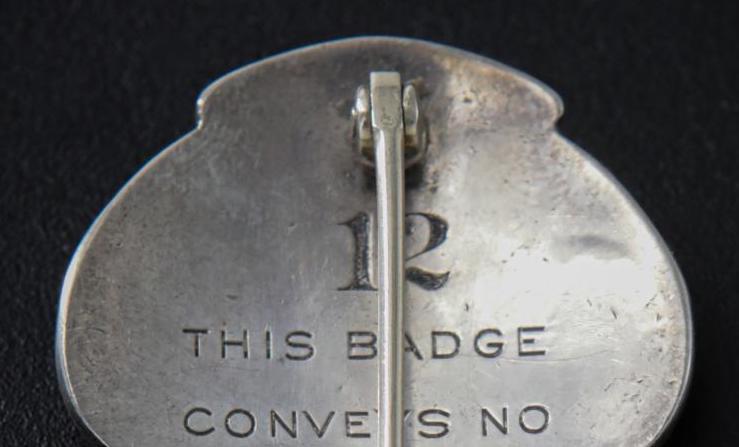
Cropped and enlarge photo of the reverse of badge #12 showing the calligraphic style of the numerals and the orientation of the number "12" in relation to the word "BADGE" for comparison with the lower resolution image below.

Cropped and enlarged image from the poor-resolution of the other original US Dept of State Special Agent's Division badge. This image can be zoomed slightly, but clearly shows that only one number is present on the reverse of this badge, centered of the "B". It may show the bracketed serif comparable to the form seen on number "1" of badge #12 above. What is visible of a vertical line does not appear, in my current opinion, likely to be any number other than "1" (although with a dearth of other badges, the calligraphic forms for numbers 3-9, and zero are unavailable for comparison). The vertical line at the superior margin of the badge is the open hinged pin. Apparently this pin is loose enough that it can open about 180 deg from its closed position. The form of the pin on the above badge appears to be the same as that on badge #12. As can be seen in the 2nd photo of my initial post of 2 December, 2016 on this thread, the pin on badge #12 is not as worn and loose, it only opens to a bit less than 90 deg from the closed position. This round hinge and machine-made safety catch on badge #12 are more common in the late 1920s-30s, however, I've seen several examples from 1900-1910+ federal, state, and city law enforcement badges that also employ this form.
Part of the rumors about DSS still having badge #1 is that it has been sent out to be "restored" and "encased" (in lucite as done for restrikes?) for eventual display in the entrance of the newly renovated headquarters. Is there a collective cringe about the potential indignities being wrought on possible badge #1 by Dr. Frankenfixer as "restoration" on its way to a lucite bath?
0 -
Illustrated below are images of Special Agent Robert S Sharp's U.S. Dept. of State credentials for 1921 signed by Robert C. Bannerman, the Chief Special Agent at the time (1920-his death in 1940). These complement the 1920 and 1925 set of credentials for Robert S. Sharp that I illustrated previously. Sharp was one of the first three individuals recruited as Special Agents by the first Chief Special Agent Joseph M. “Bill” Nye (all former Postal Inspectors) during the term of Secretary of State Robert Lansing (1915-1920). Sharp was the first Special Agent in charge of the Dept. of State Special Agents Division's New York office established probably in 1917-18 by Bill Nye. Badge No. 12 was probably issued to one of the early Special Agents at this New York office. These images are courtesy of an anonymous current DSS Agent.
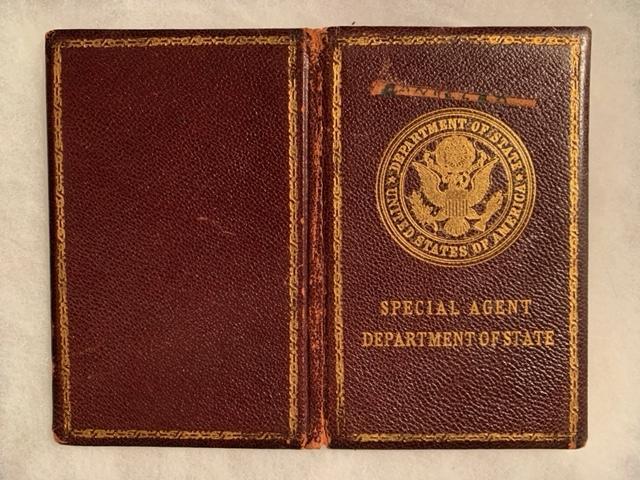
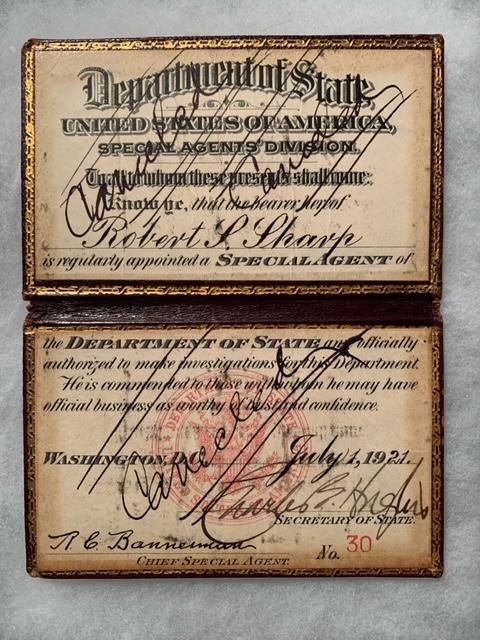
See also the illustrations of Robert S. Sharp's 1920 (signed by Joseph M. Nye) and 1925 (signed bu R. C. Bannerman) credentials in my post of 29 November, 2017 on this thread. Joseph M. Nye's U.S. Dept. of State Special Agents Division credentials, cancelled in 1920 following his resignation from Dept. of State in 1920 to work for Guaranty Trust Company to improve detection of fraud, are shown in the 3rd and 2nd-to-last photos in my post of 9 November, 2018 on this thread.
0 -
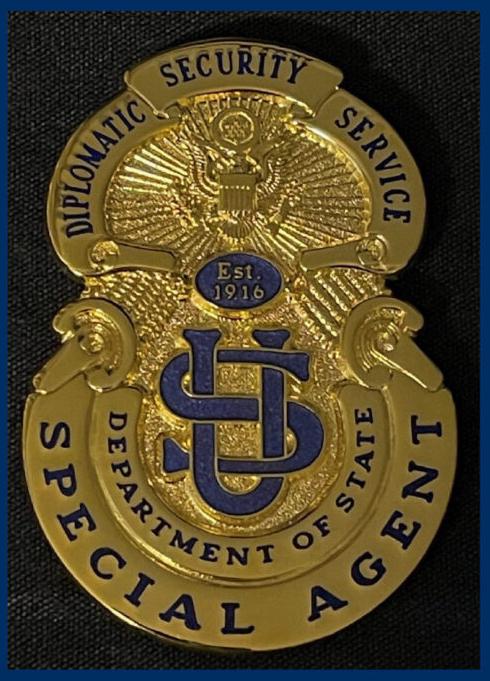
Here is a cropped image of the U.S. Department of State, Diplomatic Security Service's new commemorative badge for use during special events, from the same illustration in the State Magazine, In the News, December, 2021 article that is referenced in the above post from yesterday (https://statemag.state.gov/2021/12/1221itn04/). Image credit is also: State Department photos. This shows better the elements borrowed from the 1917 badge design, most executed in relief rather than through engraving, and in less detail than the original badge. Some design elements are borrowed from the way that later restrikes (not the ~1989 restrike) were designed. Compare this image to the restrike with blue enamel shown glued to a mounting backing in the post of 20 March, 2021. This can be zoomed slightly for a little bit of additional detail.
0 -
I just saw illustrations of the U.S. Department of State, Diplomatic Security Service's new commemorative badge that uses elements of the original 1917 design (DSS calls it the 1916 design, I believe the first badges were minted and distributed in 1917). The illustration below is from an article by Julia Paccone, "DSS unveils new commemorative badge at U.N. General Assembly", State Magazine, In the News, December, 2021 (https://statemag.state.gov/2021/12/1221itn04/).

Above is the only illustration for this brief Public Affairs article. This high-resolution image can be zoomed to view better details of the new DSS badge design. The associated caption reads: "Diplomatic Security Service Director Carlos Matus (top left) and Assistant Secretary of State for Diplomatic Security Gentry Smith hold a DS commemorative badge at the 76th Session of the U.N. General Assembly in New York City, Sept. 16. The new DS commemorative badge (bottom left, and top center) imitates the original special agent badge (bottom center, and right) from 1916, purportedly designed by Tiffany & Co. in New York. State Department photos" Tiffany & Co. is probably not the designer or manufacturer. No hallmarks of any kind are present on the badge. To date, no confirmation has been found that either the the U.S. Mint, or the Bureau of Engraving and Printing manufactured this badge.
The article reads: "Diplomatic Security Service (DSS) special agents received a new addition to their credentials while they protected foreign dignitaries at the 76th Session of the United Nations General Assembly (UNGA 76), Sept. 21-27. Rather than their typical badge, agents sported the “Diplomatic Security Commemorative Badge,” a permanent special alternate badge recently approved by DSS. This commemorative badge is the first of its type to be issued and is a replica of the original special agent badge from 1916.
Deputy Assistant Secretary for Domestic Operations Mark Sullo led the design effort, narrowing it down to two designs: a modification to the current DSS badge or an upgraded version of the original silver badge. The modified badge was selected as the new DSS active badge. Given the popularity of the original badge replica, Sullo successfully lobbied to make it a commemorative badge.
The new commemorative badge is only authorized by the director for use during special occasions, such as UNGA, the Olympics, and other events where DSS agents protect dignitaries and participants. DSS Director Carlos Matus authorized agents to utilize the DSS commemorative badge for the first time during UNGA 76.
“I am very proud of the work the team did on this once-in-a-generation project. The new designs reflect not only how special we truly are, but it is also a sign of respect to those agents who went before us and laid the foundations of the modern day DSS,” said Sullo.
Upon conclusion of UNGA 76, agents reverted to using their new standard-issue badge but will hold on to their commemorative badge for future use at special events.
Julia Paccone is a public affairs specialist in the Bureau of Diplomatic Security Service Public Affairs Office."
0 -
Here is the information from the original Sotheby's listing for the amboyna veneered cabinet that the Victoria & Albert Museum purchased. This is the listing from a 3 July, 2013 auction in London ("Treasures, Princely Taste"), Lot 42 (https://www.sothebys.com/en/auctions/ecatalogue/2013/treasures-princely-taste-l13303/lot.42.html). I am including the extensive description for anyone interested here on GMIC, as it covers cabinetry information; historical information; biographies of the original owner Frederick John Monson, 5th Baron Monson, the second recorded owner of this cabinet Augustus John Debonnaire Monson, the cabinet maker François-Honoré-Georges Jacob-Desmalter, the designer Charles Percier, and the goldsmith Martin Guillaume Biennais; as well as additional references; that are all beyond my familiarity (quite a bit longer than the "Napoleon / Empress Josephine sledge sold on auction - more information" contribution from Marcon1 in his post of 3 January, 2022 here in the France section). This description reiterates that the V&A and MMA cabinets are the only known examples of this medal cabinet design by Percier. Of interest are a few notes about the cabinet that the drawer pulls are thought to resemble bees, as I suspected, referencing Napoleon's use of them symbolically. As can be seen in the photo and description, another base was present when Sotheby's offered this rare cabinet, and obviously the Victoria and Albert Museum's staff determined it to be a later addition, and the base was subsequently removed. The description discusses some design differences between the Sotheby's example and mahogany-veneered example in the Metropolitan Museum of Art's version. One difference between these examples I did not previously note is the slight variation in the design of the uppermost portion of the paired vulture wings on the winged solar disk on the front of the cabinet (and possibly the rear?, however, no images of that face are provided in the V&A images), which the text in the Sotheby's listing calls: "an unusual almost Ionic capital above the disc" (see the 7th-to-last photo in my original post of showing that design on the MMA example, compared with the 8th and 13th photos in my original post showing this element on the V&A cabinet). I do not know the source of the text from the Sotheby's listing, it references 5 figures, although only a single photo is present in this archived listing.

High-resolution image from the Sotheby's 3 July, 2013 (Lot 42) auction listing of this cabinet that was eventually purchased by the Victoria & Albert Museum. The pattern on the amboyna veneer (the V&A Museum identifies the veneer as thuya burl [Teraclinis articulata] and only identifies the base as amboyna [Pterocarpus indicus, or P. spp.]) matches exactly that seen on the V&A example (compare with the 1st and 2nd photos in my original post, and other detailed views of the front of the cabinet). The flared lower base and legs have been removed from the piece following the purchase by the V&A as they were determined to be a later addition to the cabinet. This image can be zoomed for comparative details.
Orignal Text from the Sotheby's listing:
"A silver-mounted and inlayed amboyna and mahogany medal cabinet, by François-Honoré-Georges Jacob-Desmalter (1770-1841), after a design by Charles Percier (1764-1838), he silver mounts by the firm of Martin Guillaume Biennais (1764-1843), probably following instructions from Baron Dominique Vivant Denon (1747-1825), Empire, circa 1810.
Description
silver, ebony, mahogany
Of pylon form with a rectangular ebony banded top above a concave frieze inlaid with a band of silver stripes surmounted by a winged disc and two uraei, the sacred cobra symbol of ancient Egyptian kings, the two longer wings with Biennais maker’s mark (B with a monkey in a diamond surround), together with a standard mark for 1793, the two side wings with the same maker's mark and the `petite garantie’ for 1809-19, above a panelled door, the front and back panels inlaid with a scarab between uraei on lotus stalks, the eye of one uraeus, when pressed flips open to reveal a keyhole, the door opening to reveal the lockplate signed Biennais, Orfrede LL. M.M.. Imples et Royles à Paris, and forty-one graduated drawers each mounted with a silver scarab-like insect probably a bee, the wing of which lifts to open the drawer, each with a silver numbered plaque No 1-41, the back decorated and mounted as the front, the base of the frieze and four corners applied with a projecting curved border inlaid with silver horizontal and diagonal bands above a concave apron on bracket fee.
Provenance
Probably commissioned by Napoleon I (1769 –1821) or Baron Dominique Vivant Denon (1747-1825);
Probably acquired by Frederick John Monson, 5th Lord Monson (1809-1841), for Gatton Park, Surrey, in around 1830, where it probably stood in the Library;
Thence by descent to Augustus John Debonnaire Monson, 9th Lord Monson (1868-1914), at Burton Hall, Lincolnshire, see fig.1;
Thence by descent at Burton Hall, Lincolnshire, where it probably stood in the Library, see fig. 2 and after 1958 at South Carlton, Lincolnshire.Catalogue Note
Comparative Literature:
Michael Beurdeley, Georges Jacob (1739-1814) et son Temps, Saint-Rémy-en-l'Eau, 2002, pp. 152-157;
Clare Eames, `The Emperor's Cabinet’, The Metropolitan Museum of Art Bulletin,1958-1959, pp. 108-112;
Serge Grandjean, Empire Furniture, 1800-1825, London, 1966, ill. 13b;
Anthony Griffiths,` The End of Napoleon’s Histoire Métallique’, Medal, no. 18 (Spring 1991), pp. 35-39;
Danielle O. Kisluk-Grosheide, Wolfram Koeppe, William Rieder, European Furniture in the Metropolitan Museum of Art, Highlights of the Collection, New Haven and London, 2006, No. 92, pp. 218-221;
Jean-Marcel-Humbert, L'Egyptomanie dans l'art occidental, Paris, 1989, p.129;
Jean-Marcel-Humbert, Michael Pantazzi, Christiane Ziegler, Egyptomania L'Egypte dans l'art occidental 1730-1930, Paris, Musée du Louvre, 20th January-18th April 1994, pp. 206-207;
Ulrich Leben, ed., Bernard Molitor, 1755-1833, Exhibition Catalogue at Villa Auban, Villa de Luxembourg, 7th October -10th December 1995, p. 125;
Hector Lefuel, François-Honoré-Georges Jacob-Desmalter, ébéniste de Napoléon I eret de Louis XVIII, Paris, 1925.
Preston Remington, The Metropolitan Museum of Art Bulletin, Vol. 22, no. 4 (Apr. 1927), pp. 122-126.;
Henry Thorold, Lincolnshire Houses, Norwich, 1999, p. 38;
Richard A. Todd, Napoleon’s Medals Victory to the Arts, Stroud, 2009;This magnificent and extremely rare medal cabinet represents the zenith of the`goût d’Egypte’ style in France in the early years of the 19th century and is exceptional in terms of both its conception and execution. It is veneered in the most beautifully figured amboyna wood mounted and inlaid with exceptional quality silver mounts and by the most outstanding ébéniste Jacob-Desmalter and goldsmith Martin Guillaume Biennais of the Empire period.
The `goût d’Egypte’ style was promulgated by the architect Baron Dominique Vivant-Denon (1747- 1825), who had accompanied Napoleon on his Egyptian campaign in around 1798-99. Following on from that in 1802, Denon published his celebrated album,`Voyage dans la Basse et haute Egypte pendant les campagnes du Général Bonaparte’, comprising sketches of battle scenes and architectural details which enjoyed great success all over Europe of which there were several foreign editions; two published in London in 1802, two in Germany in 1803 and one in Florence 1808. The Egyptian themes were borrowed and adapted by some of the leading French cabinet-makers of the era and this cabinet epitomises the taste for adapting ancient Egyptian forms and utilising decorative motifs inspired by ancient Egypt. The pylon (gateway) at the Apollonopolis Parva (now Ghoos) in Upper Egypt, which was depicted by Denon in Plate 80, of his 1802 Album, was obviously the model for the upper section of this cabinet, reproduced here in fig. 3.
The Monson cabinet reflects Jacob-Desmalter's exceptional ébénisterie,`characterised by superb quality, classical severity and functional perfection...'. It is a superlative representation of his innovative furniture and virtuosity as an ébéniste with the employment of the choicest veneers embellished with superb quality silver mounts by Napoleon’s leading silversmith Martin Guillaume Biennais (1764-1843), and according to Grandjean, op. cit., p. 86, `Amboyna and satinwood were not much in demand (during the Empire period) because their prices were high' which reinforces the rarity of this cabinet. The silver marks are from between 1809-1819, next to Biennais’s mark for 1793-94, and even though the cabinet is early 19th century it was usual for Biennais to use earlier marks and to reuse them on other silver. Regarding the silver mark for 1793-1794, this was an unofficial mark. After the abolition of their guild at the time of the Revolution, goldsmiths were no longer permitted to use the mark that for centuries had testified that their metal was to the prescribed standard. As an act of self-protection, they introduced a new unofficial mark of quality of their own.
This cabinet was obviously inspired by the design by Charles Percier (1764-1838), dated to the first quarter of the 19th century, which is now in the Musée des Arts Décoratifs, Cabinet des Arts graphiques, Paris (CD 3240), illustrated by Kisluk-Grosheide, op. cit., p. 220, fig. 126, reproduced here in fig. 4. It is interesting to note that the drawing clearly shows a medal cabinet in a wood with a very tight swirling pattern-possibly amboyna, which reinforces the fact that the offered cabinet very closely follows the original design by Percier.
The differences between this cabinet and the only other known example which is in the Metropolitan Museum of Art, New York, reproduced here in fig. 5, (see post) are in both materials and form as follows: this cabinet is veneered in amboyna whereas the Metropolitan’s is in mahogany and the design by Percier appears to incorporate burrwood rather than mahogany as previously stated. The drawers of this cabinet are much shallower whereas the Metropolitan’s has graduated but deeper drawers with silver mounts of a larger size in the form of scarabs or bees on the drawer fronts. This cabinet opens on the front only and not both sides, and has 41 drawers, whereas the Metropolitan cabinet has 22 drawers on each side making a total of 44 in total and the drawer construction differs. There is a large brass plate behind the lockplate on the reverse of the door of the Monson cabinet which is not present on the Metropolitan cabinet. This cabinet has the silver bands below the front frieze centred by an `x' which is not present on the Metropolitan cabinet and the latter also has an unusual almost Ionic capital above the disc which is missing on this cabinet which does not appear on the Percier design. Furthermore, this cabinet terminates in bracket feet rather than a platform base and is much less flared in outline than the Metropolitan one. Finally, the internal lockplate on the door of the Monson cabinet is signed `Biennais, Orfre de LL. M.M.. Imples et Royles à Paris’ , which the Metropolitan's is not although on the latter above each keyhole Biennais’s name is engraved and there are also slight variations of the engravings on the metalwork of both in particular the bees on the Metropolitan's cabinet.
The Monson cabinet in view of its decorative style and execution has very strong associations with both Napoleon and Denon: as stated previously the use of the most expensive wood-amboyna-fit for an Emperor and the handles on the internal drawers are in the form of scarab-like insects or bees a symbol of Napoleon. This kind of model of scarabs/bees was used by Biennais when he was involved in mounting this type of medal cabinet, such as the ones made in 1800 for Eugène de Beauharnais (Napoleon’s stepson) and Marie-Louise, his wife in 1812. Also according to family tradition the key of the offered cabinet had N for Napoleon on it, was lost in around 1958, when the furniture was moved from Burton Hall to South Carlton and was reputed to have been given by Napoleon to his Empress Marie-Louise. It is worthwhile noting there are no initials on the Metropolitan cabinet key. What is also interesting is that unlike the Metropolitan’s plain lockplate on the inside of the door, the one on this cabinet is rather obviously engraved with Biennais’s name and advertises the fact that he is the Emperor’s goldsmith. Furthermore, although it has not been possible to date to identify the offered cabinet in the accounts of Biennais, that is not to say that it was not also made for Napoleon on Denon’s instructions.
Napoleon was passionate about medals and it is conceivable that several medal cabinets would have been commissioned either directly by him or via Denon’s instructions to Jacob-Desmalter and Biennais. In the late 1790’s, during his Egyptian campaign, Napoleon came upon a medal of the Roman general Julius Caesar and later on he discovered coins of William the Conqueror and Napoleon imbued these with great significance. Napoleon commissioned hundreds of medals during the course of his reign to mark significant achievements such as treaties and to glorify his conquests. The medals were not only works of art but propaganda according to Todd, op. cit. One of the most interesting groups were the series of Napoleonic medallions that relate to the acquisition of Italian works of art by the French Armies. On 16th August 1803, Napoleon visited the Louvre where he saw the renowned Venus de Medici and received from Vivant Denon, then Director General of Museums, a medal depicting the ancient masterpiece. However, it was of the Egyptian campaign that Napoleon stated `the time I spent in Egypt (was)….the most beautiful of my life’. His campaign included scholarly research taking a team of 167 scholars. He founded in Cairo the Egyptian Institute which resulted in his Description de l’Egypte published in ten folio volumes on which those scholars worked for twenty years. According to Todd, op. cit., `The real legacy of Napoleon’s Egyptian campaign was the birth of the discipline of Egyptology’. Three Egyptian medals were eventually produced commemorating-the Conquest of Upper Egypt (1806) the Conquest of Egypt (1808) and the Conquest of Lower Egypt (1810).
Anthony Griffiths op. cit., states regarding the Metropolitan cabinet, `The most interesting record, however, is an account submitted in February 1814 by ( the goldsmith) Biennais for 3600 francs, for what is described as the `médailler du Roi'. In Biennais's account, Griffiths continues, this medal cabinet for the Emperor is described as being `in the form of an Egyptian pedestal, containing 44 mahogany drawers with silver mounts and meant to serve as a stand for the emperor's medal cabinet'. As the Metropolitan's cabinet has two sets of 22 drawers this is quite compelling, although definitive evidence that the Metropolitan cabinet was made for Napoleon has not been found to date. Although what is puzzling is that perhaps this entry refers to another cabinet as clearly the Metropolitan Museum and Monson cabinet were intended to be stand alone medal cabinets in their own right and not merely pedestals to serve as a stand for a medal cabinet.
The history of the very similar cabinet in the Metropolitan Museum of Art, New York, (inv.26.168.77) is unclear, as to whether Denon himself commissioned it or purchased it, however, what is known is that it was recorded in the sale upon the death of Baron Dominique Vivant Denon (1747-1825) in 1826 and listed as `Un médaillier en acajou; forme de naos monolithe égyptien. Ce médaillier est garni, de chaque côté, de 22 tiroirs masque par une porte recouvrante; ses trois faces sont richement décores d’emblèmes égyptiens, incrustés en argent. Socle en marble veiné’. The marble socle is obviously now missing. As stated in the catalogue entry for the Metropolitan's cabinet by Jacob-Desmalter after a Percier design and with silver mounts by the firm of Biennais, which is dated 1809-19, the enmity between Denon and Percier would seem to indicate that it was not a commission by Denon but a later purchase, and that he was not the first owner of the cabinet. As Jean Marcel Humbert observed regarding the Metropolitan cabinet which can be made in relation to the offered one op. cit., `The originality and variety of its decoration make this piece an excellent illustration of the taste for things Egyptian at the beginning of the nineteenth century. At the same time it is the very essence of Egyptomania; the adaptation of antique forms and decorations, in dimensions as well as materials, to a type of object and function completely different from those associated with these symbols in Antiquity’.
Dominique Vivant, Baron Denon (1747-1825) more than any other figure during the Napoleonic era, was almost the sole arbiter of the artistic taste of the Age and even influenced Emperor Napoleon in that regard. Denon began his career in the household of Madame de Pompadour eventually filling diplomatic posts in St. Petersburg, Stockholm and Naples. He was ambassador to Naples from 1779 to 1785 and was responsible for the design of the Legion of Honour made by the firm of Biennais, which Napoleon bestowed upon those he favoured in his immediate circle. He supervised everything made in the workshops of the court artists and craftsmen. In 1802, he became the Director-in Chief of the Musée Napoléon and master of the Mint where he was also responsible for the striking of medals. He had a passion for medals and upon his death his inventory listed three thousand contemporary medals alone.
In the Musée des Arts Décoratifs, there are five hand coloured designs for furniture including drawings that Percier executed for Biennais, one depicts a rectangular bedside table, the other a medal-cabinet ordered by Vivant Denon. The latter was an antiquarian and fascinated by the exotic art forms of Egypt. His drawings were both records of the past and as patterns for future designer’s according to Clare Eames, p. 109, op. cit., `It was perhaps the most influential factor in the popularity of Egyptian decoration…’
Jacob-Desmalter was asked to make for Denon for his own private use a set of mahogany furniture based on the latter's drawings, including a bed in classical taste with three sides decorated in silver to be placed against a wall, a pair of armchairs, a medal cabinet with twenty-two drawers which is probably the one now in the Metropolitan Museum (see ante). The aforementioned furniture is listed in a catalogue drawn up the day after Denon's death by L.J. Dubois, Description des objets d'art qui composent le cabinet de feu M .le Baron Vivant Denon, Paris, 1826, pages 189-190, nos. 832, 833, and the names of Denon and Jacob-Desmalter were cited as the authors of these pieces. According to Grandjean, op. cit., p. 34`..one must write the name of Denon high on the list of originators of the Egyptian mode, and insist that his influence on the furniture of Napoleon’s era was of considerable importance’.
It is interesting to note that in John Bernard Burke's, `A Visitation of the Seats and Arms of the Noblemen and Gentlemen of Great Britain', London 1853, vol. II, p. 226. (published by Hurst and Blakett, Great Marlborough Street), referring to his visit to Gatton Park, Surrey, purchased by the 5th Lord Monson in 1830, there is the following extract:
“The library is entirely fitted up with ebony and ivory. The sofas, tables, and chairs, all of ebony, richly carved, came from Amsterdam; the chimney-piece of Rosso Antreo, with its clocks and candelabra of bronze, was a gift from Napoleon to Eugene Beauharnais on his marriage, and a small escritoire, with some curious contrivances appertaining, belonged also to the Emperor, and was used by him in his campaigns.”
This would seem to confirm that already in 1853 and probably even earlier, perhaps upon the purchase of Gatton Park, in 1830, or during Lord Monson's extensive travels in the 1820's and 1830's, gifts from Napoleon and an item reputedly belonging to him, namely an escritoire that was used by Napoleon in his campaigns, were in the 5th Lord Monson's collection. This also assists in dating the probable acquisition of the medal cabinet by the 5th Lord Monson to around 1830 and further confirms the family's strong connections with Napoleonica.
Furthermore, the medal cabinet in the Metropolitan Museum (bequest of Collis P. Huntington in 1900) was possibly acquired in the second half of the 19th century. However, no provenance for the Metropolitan cabinet is recorded prior to that. The Huntington collection is well known and the Huntington Museum has an outstanding collection of French 18th century art formed by Henry Huntington (1850-1927), the nephew and business associate of Collis P. Huntington (1821-1900), the railroad magnate.
In conclusion therefore, with regards to the Monson cabinet, in the absence of documentary evidence to date, this extremely rare and sumptuous cabinet of exceptional quality was either a commission on behalf of Emperor Napoleon either for his own use or for a member of the Imperial family or for Baron Denon for his own personal use to contain some of his vast collection of medals. It is certainly conceivable that in view of Napoleon’s profound interest in medals that this is the only other outstanding example of a medal cabinet in the `goût d’Egypte’ style, apart from the Metropolitan example, which has resurfaced after nearly two hundred years.
Frederick John Monson, 5th Baron Monson (1809-1841) and Gatton Park, Surrey:
He is well recorded as a collector and travelled extensively in Europe in the 1820's and 1830's and purchased Gatton Park in Surrey in 1830. Sir George Colebrooke (1729-1809), had acquired Gatton from his brother Sir James Colebrooke (1722-1761), a prominent London banker and Member of Parliament for Gatton. In 1762, Sir George, who was Member of Parliament for Arundel and chairman of the East India Company, embarked on a series of improvements to the estate, commissioning Lancelot ‘Capability’ Brown to remodel the park. Brown spent nearly six years working at Gatton, taking the unusual step of actually supervising the gardening in hand, and transformed whatever formal gardens had existed before into sweeping Arcadian parkland.Gatton passed through a number of hands in the following years and in 1830 was sold for £100,000 by Sir Mark Wood, 2ndBt. (1794-1837) to Frederick John Monson, 5th Lord Monson. Monson redeveloped the house, commissioning Thomas Hopper, who designed a magnificent marble hall based on the Corsini Chapel in Church of St. John Lateran, in Rome, and Joseph Severn for frescoes of the Classical Virtues. Brown’s park remained largely intact however, and the estate remained in the Monson family until 1888, and after his death his widow, Theodosia, Dowager Lady Monson, lived on there. The property was eventually sold by the 7th Lord Monson in 1888 and the contents moved to Burton Hall. When it was sold by the 5th Baron’s grandson, William Monson, 1st Viscount Oxenbridge, to Sir Jeremiah Colman, a prominent Norwich based food manufacturer and financier whose fortune was founded on the famous Colman’s Mustard.
Augustus John Debonnaire Monson, 9th Lord Monson (1868-1914):
He was attaché at the embassy in Paris from 1897-1900, when his uncle Sir Edmund Monson was the Ambassador. Augustus was a great friend of Lord Rosebery who encouraged his interest in Napoleon memorabilia, the latter having an entire room dedicated to Napoleonica at Mentmore and Lord Rosebery was the author the book, `Napoleon, The Last Phase’ in 1901. When Augustus married, which he did on 1st July 1903 at the British Embassy, he took as a wife Romaine Stone, daughter of General Roy Stone, USA army and widow of Lawrence Turnure of New York. Their son was born in 1907 and was christened John Rosebery Monson.François-Honoré-Georges Jacob-Desmalter (1770-1841):
He was the favourite cabinet-maker of Napoleon and belonged to a dynasty of leading cabinet-makers. Amongst Jacob-Desmalter's first commissions, was the decoration and furnishing of the town house of Napoleon and his wife Josephine in the rue Chantereine and the surviving furniture illustrates the patriotic and symbolic tastes which were so characteristic of the Directoire period heralding the Empire style. His next major commission was for the Récamiers, important and influential French bankers. At about the same time the firm was commissioned to decorate and furnish Malmaison, by Percier and Fontaine, which was the country retreat of Josephine, where furniture in the` goût d’Egypte’ style still remains today. The firm also provided furniture for Bonaparte's apartments at the Tuileries and also exhibited at the second and third public exhibitions at the `Products of French Industry' held in 1801 and 1802 in the courtyard of the Louvre and Jacob-Desmalter received a Gold Medal at the 1802 exhibition. It was during the Empire period that his reputation was established and his talent fully recognised, as it is recorded that in 1807, the firm employed 350 workmen. His work according to Grandjean, op. cit., `is esteemed not only on account of its stylistic homogeneity but because of its consistent high quality'.Charles Percier (1764-1838):
Charles Percier and his partner Pierre-François–Léonard Fontaine (1762-1853), the most celebrated architects and decorators during the Empire period, were largely responsible for creating the Empire style and are synonymous with creating the furniture and decoration heavy with symbolism for Napoleon. They had been in Rome from 1785 to 1790, where they had followed David's teaching, and they were fully familiar with Ancient Greek and Roman art, which was a major inspiration for their decoration and furnishing. Percier and Fontaine, published their Receuil des decorations intérieurs, (1801, reissued in 1812) and they used motifs such as giant N’s in laurel wreaths, eagles and bees to make the style fully Napoleonic. Both were fully employed by Napoleon as both architects and interior decorators on various palaces such as Malmaison, Tuileries, Louvre, St. Cloud and Versailles. They transformed Napoleon's palaces into lavish showcases for the produce of French art and industry. Percier was also a partner of Jacob-Desmalter and they worked very closely together.Martin Guillaume Biennais (1764-1853):
He was born in Lacochèe near Argentan on 29th Aril 1764. The Duc de Luynes in his Rapport sur l’industrie des métaux précieux à l’Exposition of 1851 stated` Bonaparte having become Emperor, ordered from him large amounts of furniture, tabletterie, and nécessaires, not only for himself but for all of his relatives…’ Jérôme Bonaparte purchased from him in 1800 a nécessaire de voyage when he was based at the Singe violet 238 rue Saint-Honoré. The imperial insignia used by Napoleon were made by Biennais and at the Exposition Industrielle of 1806, Biennais won a Gold Medal for the objects he exhibited. In 1806, he was appointed goldsmith to the Emperor. After Biennais’s death in 1843, it was written` When Bonaparte came back from Egypt he didn’t have any other fortune except glory and traders did not want to sell to him on credit. Biennais was the only one to accept this and he became Napoleon’s official goldsmith when he became Emperor.’Napoleon’s appreciation for the credit given, was demonstrated when he returned to Paris in an increasing number of commissions for Biennais making silver, furniture and jewellery as well as chessboards and travelling cases, much of it ordered by Napoleon for his own use or for gift. At the same period Denon was becoming Napoleon’s cultural mentor advising him in all matters of taste. Biennais’s trade card read `Orfévre de S.M.l’Empereur et Roi' and another trade card lists the objects he made and interestingly it includes `ébénisterie’ (cabinet-work)."
The above is verbatim, with minor grammatical corrections, from the Sotheby's 3 July 2021 catalog listing (https://www.sothebys.com/en/auctions/ecatalogue/2013/treasures-princely-taste-l13303/lot.42.html).
2 -
Owain,
Thank you for your generous help providing the translation of the name on the engraving in the 3 November post. Your identification of the Tunisian Order of Glory (Nishan Iftikhar), and especially the possible date range of 1882-1902, is also quite useful. Both of these bits of information may have helped me identify this individual. However, there is a problematic death date associated with the more detailed information I have encountered.
The 1926 Les Juridictions Mixtes d'Égypte 1876-1926: Livre d'or Édité sous le Patronage du Conseil de l’Ordre des Avocats á l’Occasion du Cinquantenaire des Tribunaux de la Réforme, par le: Journal des Tribunaux Mixtes. Alexandrie, Egypte, Février 1926 anniversary volume identifies only 2 individuals with the surname Magdi. This publication normally has a reliably thorough roster of the Mixed Courts' personnel from 1875-January 1926. Although entries for European judges sometimes list awards made to foreign judges, there does not appear to be a systematic inclusion of honors to Egyptian judges (other than the identification of Bey). I cannot use this reference to confirm the honor of the Tunisian Order of Glory in narrowing which individual may be represented in this portrait I first encountered on Pinterest. No photographs of these two individuals with the surname Magdi are included in any of the plates from this 1926 anniversary publication.
1) In the appendix section with a roster of Egyptian Judges who have served on the District Courts (Alexandria, Cairo, and Mansourah), there is an entry for Saad Magdi (the 1926 Les Juridictions Mixtes d'Égypte 1876-1926 anniversary volume, pg. XVII), listing him as a former Chef du Bureau de Traduction au Ministres des Traveaux Publics (Head of the Translation Bureau to the Ministers of Public Works), named as a judge to the District Court of Alexandria on 16 February, 1882. Judge Magdi retired on 1 June, 1898. Saad Magdi is identified in this listing as having the honorific Moutemaïz. I do not know anything about this title other than it's appearance in a biography of another Egyptian individual who was a Royal Advisor and held the civil ranks of Sanieh, Moutemaïz, and Bey.
2) The appendix listing in the 1926 Les Juridictions Mixtes d'Égypte 1876-1926 anniversary volume of Egyptian Substitutes for the Parquet (the office of the Procureur-General, the prosecutor's office) includes Mohamed Magdi Bey on page XXIV. He was named as Substitute-Assistant to the Parquet on 13 December, 1881. He was called to other duties on 19 January, 1884.
My strong suspicion is that the illustration in my 3 November post depicts Judge Saad Magdi. The similarity in name, the longer service on the court than Mohamed Magdi Bey, and the greater prominence of Judge Magdi's court role compared with the Substitue-Assistant to the Parquet seems to argue in favor of his being the subject of an engraved portrait. However, below I detail some additional online information that problematically identifies the death date for Saleh Magdi Bey as 1881, prior to his listed appointment to the Alexandria District Court in 1882. I thought there might be a suggestion that the sash worn by the individual illustrated in the 3 November portrait might be bicolored. That would be appropriate for the Parquet or other court officials on the Appeals and District Courts, but the District Court judges' sashes were solid red. Owain, your identification of a probable date range indicated by the Bey's signature in the medallion on the 2nd Class Grand Officer Tunisian Order of Glory encompasses the period when both Judge Saad Magdi and Mohamed Magdi Bey worked on the Courts. As I noted in the 3 November post, photographs from this period just before the beginning of the 20th century also show a greater number of judges and officials wearing beards, compared with the trend after the turn of the century when mustaches had almost entirely replaced beards among the Egyptian court personnel.
My previous Google Images search of the 3 November portrait of Saleh Magdi Bey did not bring up any additional information, but today my search did identfiy one website using a much lower-resolution version of this engraving. A biography of Saleh Magdy Bey is provided on an Arabic language website (https://www.aldiwan.net/poem94219.html). It gives his full name as: Muhammad bin Saleh bin Ahmed bin Muhammad bin Ali bin Ahmed bin Sharif Majd Al-Din. He is identified as a researcher, translator, poet, and had a career in the judiciary. The aldiwan.net website also includes at least 8 poems from his Diwan (collection) of poetry. The machine translation of the website makes a number of awkward statements about his origins that are difficult for me to evaluate with my handicap of not reading Arabic. Saleh Magdi Bey may have come from an Egyptian family living in Mecca. His grandfather is identified as the noble Majd al-Din, who may have moved to Egypt from Mecca (?). Saleh Magdi may have been born in Abu Rajwan, approximately 20 miles south of Cairo. The aldiwan.net website states that he was educated in Helwan and then at Al-Alsun School in Cairo, had a miltary upbringing, and studied English in 1869. He translated many books from French, and was appointed by Khedive Ismail to translate the French laws known as the Code Napoleon into Arabic. These were the basis of the international Tribunal's form of law applied in cases involving foreigners and Egyptian Nationals at the Mixed Courts. Presumably, this would have been around the time of the initial formation of the Mixed Court system that replaced the use of Consular Courts for such cases in 1875. Two additional websites provided a very small amount of information when I searched under "Saleh Magdi Bey poet", and also included this same portrait of him. Wikimedia (https://commons.wikimedia.org/wiki/File:Salah_Magdy_Bey_(1826_-_1881),_19th_century_Egyptian_poet.jpg) and Alamy (https://www.alamy.com/stock-photo-salah-magdy-bey-1826-1881-19th-century-egyptian-poet-171881312.html) both identify the image I posted on 3 November as the poet "Salah Magdy Bey", with no mention of his appointment to the Mixed Courts. Wikimedia does identify his profession as translator. Both of those sites give alleged dates for his birth and death as 1826-1881, although this death date contradicts the 1926 Les Juridictions Mixtes d'Égypte 1876-1926 anniversary volume's indication that Saad Magdi served on the District Court of Alexandria from 1881-1898. The aldiwan.net website states that he died in Cairo.
An Arabic language Wikipedia site (https://ar.wikipedia.org/wiki/صالح_مجدي_بك) that I found though a search combining the name Saleh Magdi Bey and "poet" as search terms includes a low-resolution version of the same portrait I posted on 3 November, and provides addition biographical information. It also identifies his birth year as 1826. This site states that he wrote books on landscape drawing, geology, mechanics, arithmetic, algebra, geometry, astronomy, and martial arts (fort construction & hand-thrown bombs). The biography continues to describe his work translating the Code Napoleon that he received several appointment from Khedive Ismail, and his final position on the judiciary (but identified as Cairo) is mentioned as well. This article says that he remained in that position until his death. This Arabic language Wikipedia article provides the reference for his Diwan of poetry as: Diwan Saleh Magdy, Bulaq Press, Cairo 1312 AH / 1894 AD (compiled by his son and printed after his death, but note the date of 1311 AH in the image of the title page below). The article states that he died 1298 AH (1881 AD), after suffering from an incurable disease, recorded in one of his last poems. Three references about Saleh Magdi Bey are cited in this article.
The use of the same portrait showing him in the garb of a Mixed Court judge, his role in the translation of the Code Napoleon, the mention of his work in the judiciary all seem to support the identification of Saleh Magdi Bey with the listing of "Saad Magdi" in the Les Juridictions Mixtes d'Égypte 1876-1926 anniversary volume. Despite the Wikimedia, Alamy, and the Arabic Wikipedia repetitions of a death date of 1881, this still appears to be the most probable correlation with the Mixed Courts anniversary publication. However, I do not know how to reconcile this alleged date of death, contrasting with the statement that Judge Saleh Magdi retired in 1898 in the 1926 appendix listing of Saad Magdi as a judge of the Alexandria Mixed Court. I am unsure whether this problem with a death date for Saleh Magdi Bey is yet another example of the legion of errors that plague the internet or a potential problem in the research used in preparing information about an individual who was a part of the court 45 years before the 1926 anniversary volume.
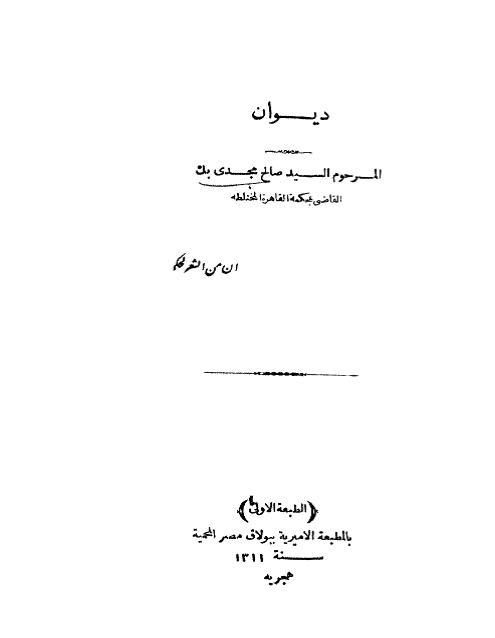
Low-resolution image of the cover page of the Diwan of the late Mr. Saleh Magdi Bey. First Edition. Princely Press, Bolaq, 1311 AH ( ديوان المرحوم السيد صالح مجدي بك. الطبعة الأولى، المطبعة الأميرية ببولاق سنة 1311) from the Arabic language Wikipedia site noted above (https://ar.wikipedia.org/wiki/صالح_مجدي_بك#/media/ملف:Cover_page_of_the_poetry_divan_of_Saleh_Magdy_Bey.jpg). The citation is slightly different than that in the text of the article. The title page has the date 1311 AH, 1893 AD, rather than the 1312 AH (1894 AD) noted in the text of this Wikipedia biography.
Cheers, Rusty
0 -
I probably should not have previously included some miniatures of Ottoman awards in past posts here (especially that of 20 January, 2019 that featured 3 examples of the Order of Osmanieh minis and several Order of Medjidie minis), technically these ought to be under Turkey in Europe. I must have been looking at the Ottoman awards through Egypt-colored glasses overemphasizing Ottoman influence there. As I have already poisoned the waters here with Ottoman minis, I will add just a couple more today.
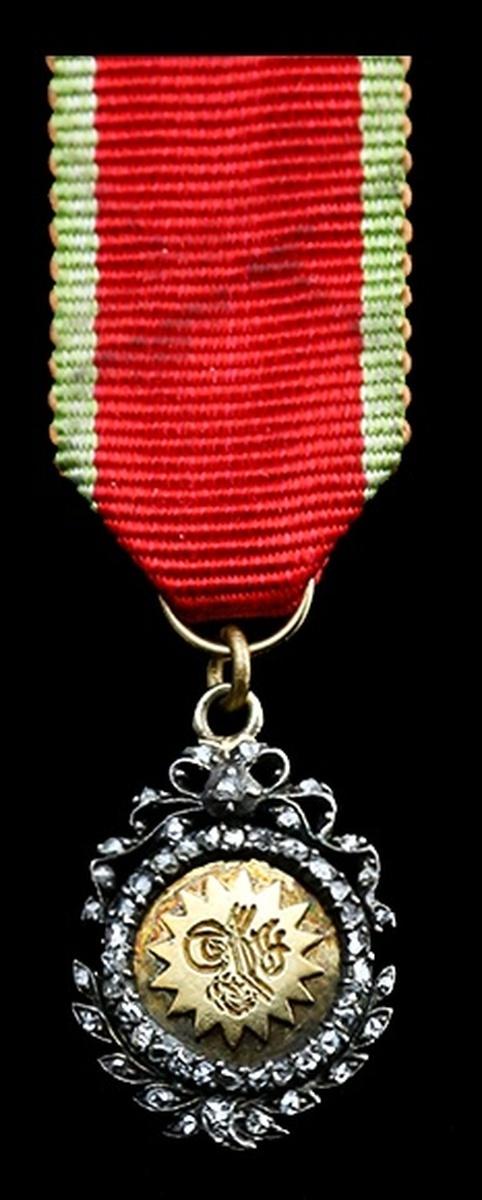
Moderate-resolution photo of an uncommon example of a miniature of the Ottoman Order of Glory, (Iftikhar Nişanı). This mini comes from a past Spink Auction, 17300, Lot 176 (https://www.spink.com/lot/17003000176). The auction description provides the measurements 18 mm wide x 150 mm tall, and the materials as gold, silver, and 55 chip diamonds. This version of the award is based on the more common type 1 form. The full-sized awards exhibits two main variant forms. See the The Valka military history website's descriptions and images of the different forms of the full-sized version this award (https://www.valka.cz/Rad-slavy-t82564). I also included a good-resolution image of a full-sized type 2 form of this award in my post of 14 November, 2021 discussing the awards worn in several portraits of the Egyptian Khedive Abbas Hilmi II, in the thread "Egyptian Khedive commemorative medal" started on 11 November, 2016 in the "Middle East & Arab States" section. The Valka website states that variation in the form of the full-sized award was common (principally referring to the type 1 version the is seen in the more common online images of this award) as no formal decree ever stipulated precise design parameters. Individual court jewelers interpreted the general design and ornamentation as they pleased.
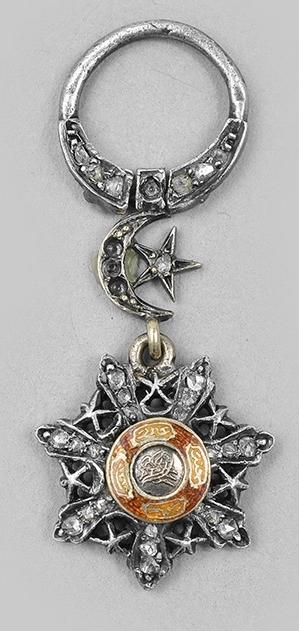
Moderate resolution of an unusual version of a miniature Order of Medjidie with brilliants. This example comes from an 8 February, 2021 auction by eMedals, Item: M0456-1 (https://www.emedals.com/ottoman-empire-an-order-of-medjidjie-i-class-miniature-in-diamonds). The description identifies this as a 1st Class miniature of this order. The materials are identified as silver, with a gold central medallion framed in a red enameled border with inscriptions, and diamond chips. The central medallion is oriented ~90-100 deg from the correct orientation. Note that the tugs of the Sultan's tugra in the central medallion are pointed to the right instead of being uppermost, the beyze is uppwards rather than on the left, and the hançer point to the 7:00 position rather than to the right. The eMedals description gives the dimensions as 12.24 mm wide x 28.69 mm tall, and it weighs 1.4 g. The listing states that the stones mounted in the crescent (of the crescent & star element) include 1 ruby and that 2 are missing (It appear there are 3 empty mounts in this element, is the 1 ruby loose?, perhaps it is just the resolution of the image that makes a stone difficult to see). One diamond is missing from the center of the ornamented lower portion of the suspension loop.
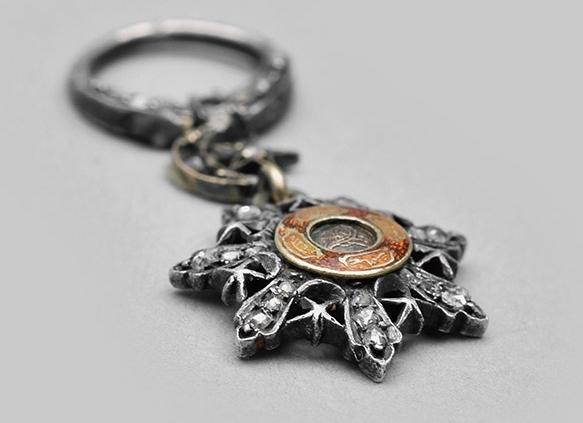
Oblique view of the obverse of the same Order of Medjidie miniature from eMedals February 2021 auction.

Moderate-resolution of the unmarked reverse of this same eMedals Order of Medjidie miniature. The description notes that there appears to be glue on the reverse of the crescent and str suspension. Is the loop suspension a later repair (the view on the obverse above also suggests this)?
0 -
A 2nd Class Grand Officer set of the Order of Ismail is currently on offer in an upcoming auction by Heynault venues publiques of Brussels on 7 December, 2021 (Lot 0373). The auction listing identifies this as a "Grand Cross" set, however the measurements of the badge and breast star clearly indicate it is a 2nd Class Grand Officer set. This offering includes the neck badge and breast star, as well as a neck ribbon that may be new, but the group is not associated with a case, and is stated come from a private Belgian collection. This auction lot is listed on the Lot-Art website with one moderate resolution photo combining views of the obverse, reverse, and ribbon included with this set (https://www.lot-art.com/auction-lots/EGYPT-Order-of-Ismail-Nishan-al-Ismail/373-egypt_order-07.12.21-haynault), but is best represented on the Liveauctioneers website (https://www.liveauctioneers.com/item/118086226_egypt-order-of-ismail-nishan-al-ismail?utm_source=LotArt&utm_medium=web&utm_campaign=LotArt2019A). I cannot yet access good quality images from the Heynault listing (https://haynault.be/fr/vente-publique/84/item/373). The Liveauctioneers listing for the Heynault Order of Ismail includes the same moderate-resolution image of the obverse, reverse, and ribbon seen on the Lot-Art listing, and also includes 2 separate photos that are higher-resolution images of the obverse, and the reverse, shown below. (all 3 images are on the Heynault site, but they are difficult to zoom or download).

Moderately high-resolution image of the obverse of the Heynault example this 2nd Class Grand Officer neck badge and breast star set (misidentified as a 1st Class Grand Cordon award in the description) from the Liveauctioneers website listing (https://www.liveauctioneers.com/item/118086226_egypt-order-of-ismail-nishan-al-ismail?utm_source=LotArt&utm_medium=web&utm_campaign=LotArt2019A). The ribbon appears nearly pristine, and could be a modern replacement. This image can be zoomed for much more detail. The dimensions given for the neck badge are 82 mm tall x 62 mm wide, and it weight is 50.93 g. The height measurement is stated to include the suspension ring. These measurements fall within the range of reported neck badges' dimensions (both 2nd and 3rd Class neck badges and 1st Class sash badges), variously reported as 78-85 mm tall (not always identifying where on the suspension device and/or loop attachment those are measured). The weight is slightly heavier than that reported for most such badges, ranging between 47 and 49 g. It is clearly marked Lattes on the reverse, and the photos of the reverse also show the 3 Egyptian gold hallmarks, with a date hallmark of "Z"=1924-1925 (correctly identified in the auction description). All 3 Egyptian gold hallmarks are visible on the obverse right-hand link between the superior star arm and the crown suspension device. The diameter of the breast star is given as 68 mm, and its weight as 77.89 g. The diameter of most 2nd Class breast stars is 70 mm. However the above star is the size of 2nd Class breast stars and cannot be a 1st Class star, that range from 81-82 mm, with most identified as 80 mm. Where reported, the weight of most 2nd Class Brest stars range between 81-81.25 g. The Heynault example exhibits the 3 Egyptian silver hallmarks in the most common location on the reverse (on the longest ray to the viewers' right of the central long ray of the embellishment). The silver hallmarks on the breast star are more difficult to read than this on the neck badge, but does show well the "Z" date hallmark. The description notes some "minute knocks" to the enamel, although no obvious damage is seen in these images. The wreath configuration on the neck badge and breast star are those seen on other unquestionable J. Lattes pieces. As noted in previous posts, the Lattes wreath design is identical on the 1st Class sash badges and all 2nd and 3rd Class neck badges. The wreath on the Heynault neck badge shows a slight rotation to the viewer's right, that also can be seen on the orientation of the Lattes name and 3 Egyptian hallmarks on the reverse (although the orientation of the central boss of the medallion with the calligraphic inscription of "Ismail" does not show any offset to the right). The wreath on the breast star is congruent with that seen on 2nd Class Lattes-made breast stars (that of the 1st Class star is different). Both the neck badge and breast star exhibit the same engraving on the gold and blue enamel star arms. They show 2 lateral marks on each side of the most distal blossom, and a single central engraved mark oriented within the most distal petal. The two central flowers have 3 lateral engraved marks and the v-shaped mark outlining the central petal. the resolution of the image does not allow evaluation of the fineness of the other engraving on these gold floral elements. The gold and red enamel bands around the wreath also are consistent with Lattes workmanship and do not resemble those seen on Tewfik Bichay-made pieces. The form of the leaves, the placement of the gold laurel fruit dots, and the depth and color of the enamel also unambiguously identify Mason Lattes execution.

Moderately high-resolution photo of the reverse of the neck badge and breast star, with the same view of the neck ribbon, from the Liveauctioneers listing of this upcoming Heynault auction offering of Lot 0373. This image can be zoomed for additional details. The gold hallmarks on the neck badge below the "LATTES" name are those of the Cairo Assay Office for 18 k gold, the ibis indicating Egyptian-manufactured gold, and the "Z' date hallmark. There are no gold hallmarks on the reverse of the crown suspension element, but all 3 gold hallmarks are visible on the reverse of the suspension loop. As noted under the photos of the obverse, the reveres shows a slight rotation of the central element so that the name "LATTES" is tipped upwards on the viewer's left. Interestingly for understanding the construction of this badge, as noted above in the description of the obverse, the central boss of the medallion with the inscription "Ismail" is not comparably rotated, indicating that it is an independently assembled component fixed in place without being affected by displacement of the wreath element. The silver hallmarks on the inferior long lateral ray to the viewer's right of the central inferior ray of the embellishment are less clear in the resolution of this photo. The central cat hallmark denoting Egyptian-made silver is slightly definable, and the "Z" hallmark is visible. The congruence in the date hallmarks on the neck badge and breast star help confirm their most likely association. No gold hallmarks are visible on the reverse of the star arms of the breast str and no marks are visible on the tunic pin.
0 -

Portrait photo of an young Egyptian official of the Indigenous Egyptian Courts, from a current eBay auction (https://www.ebay.com/itm/313742114590?ssPageName=STRK%3AMEBIDX%3AIT&_trksid=p2060353.m1438.l2649). The auction description identifies this as an original photographic print measuring 14 cm x 9 cm, and the impressed studio mark is apparently that of Badr. This official wears a long western-style jacket rather than the stamboulin coat, a white vest, white tie, and wing collar, along with his tarboosh. This form of costume is also seen on other photos of officials in the Indigenous Courts (see the 1st, 2nd, 11th, 12th, and 17th photos in my post of 6 April, 2020 on this thread), but is less commonly seen on portraits of officials of the Mixed Courts (however see two images of the Greffier Adib Maakad Bey shown as the 15th and 17th photos in my post of 6 September, 2019 on this thread wearing this same clothing). Some other group portraits may show this costume, however this individual's outfit, bicolored sash (green & red), and crescent with a single star is identical to the Indigenous Court official shown in the 17th photo of that 6 April post.
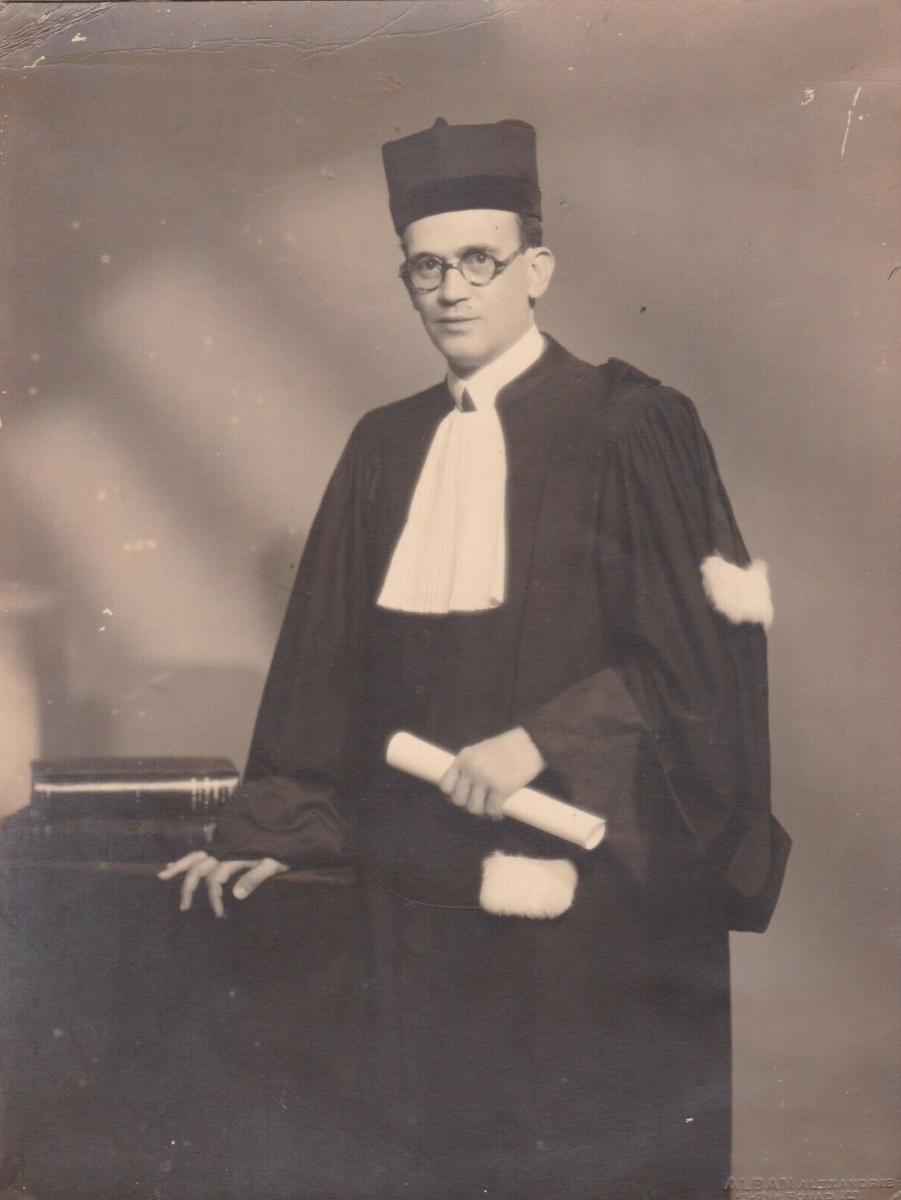
The above portrait photo shows an Egyptian lawyer from a current eBay auction listing (https://www.ebay.com/itm/275040366929). The auction description identifies this an as original print, probably measuring 12 cm x 17 cm. This is likely a graduation portrait. The lawyer does not wear a sash nor insignia indicating assignment to either the Indigenous or Mixed Courts, but shows the form of the gown, rabat (scarf), beretta (cap), and épitoge (a French form of the academic hood used in British academic costume) as seen in other images of Egyptian lawyers (especially the 14th, 16th, 17th, and 29th images in my post of 21 August 2019 on this thread) used in the Mixed Courts. The costume of the lawyer shown in that 29th photo of my 21 August post is essentially identical to the regalia shown above. The above photo does show some elements of the Egyptian avocats costume in better detail than several other images I have previously illustrated on this thread.
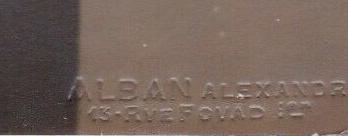
Close-up cropped image of the embossed studio name in the lower right corner of this portrait (cropped from a separate image in the same eBay listing), identifying the photographic studio as Alban of Alexandria, located at 13 rue Fouad. The eBay seller states that this was an Armenian-owned photo studio (not uncommon among photographic studios from this period in Cairo and Alexandria), and many of the photos I have included in this thread are the work of this apparently prolific studio in Alexandria.
0 -
Over the American Thanksgiving holiday I had chance to take a few better pictures of the Pierre Crabitès judicial badge. I posted the first photos I took of this badge on 2 December, 2019 in this thread, but they were taken with a borrowed camera and were not as high-resolution as those I am including in this post.
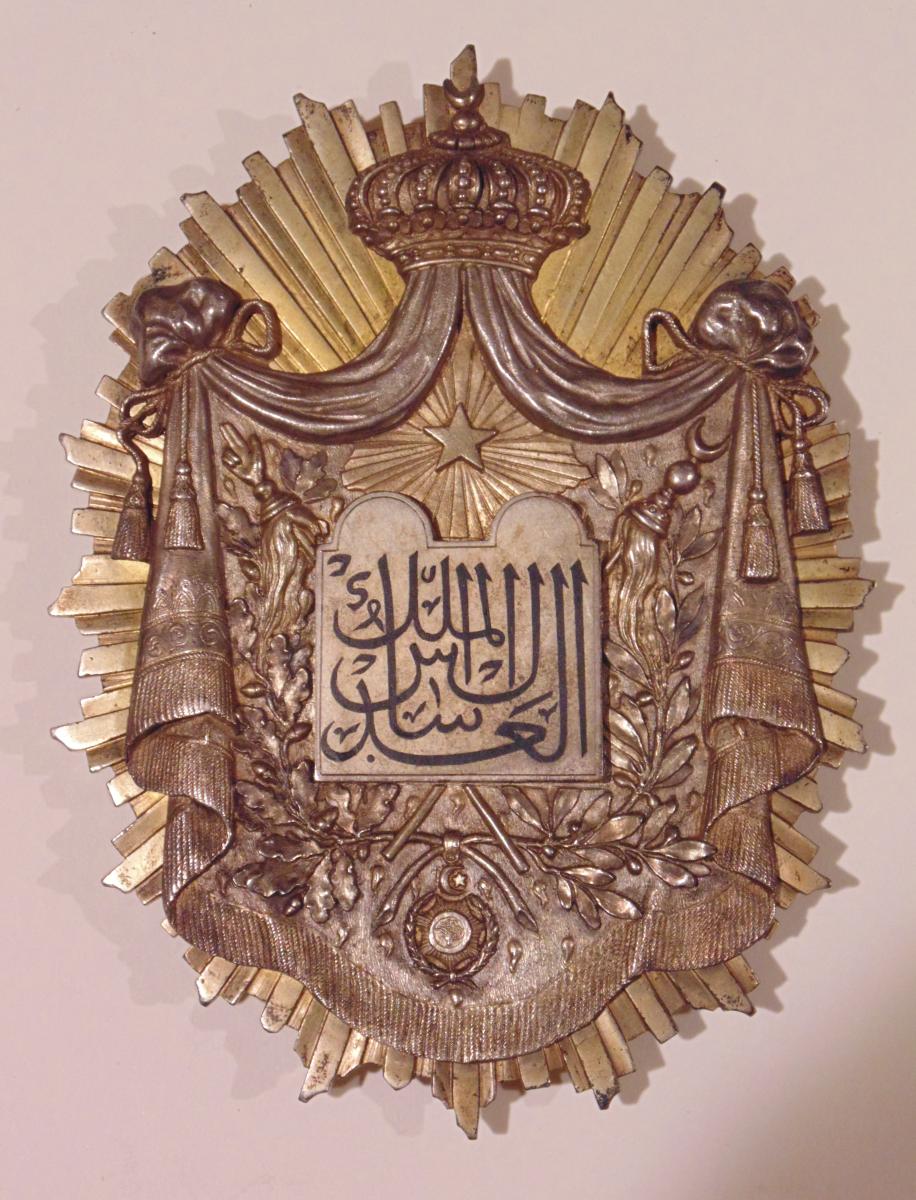
This image of the obverse of the Crabitès badge can be zoomed for greater detail. As noted elsewhere in this thread, this is a gold and silver District Court badge for Judge Crabitès during his time on the bench of the Cairo Court from 1911-1936. This badge was made by Rudolf Stobbe of Alexandria. Although the reverse does not have a maker's mark, it is in a case marked Rudolf Stobbe (see the 1st and 5th photos in my 2 December, 2019 post).
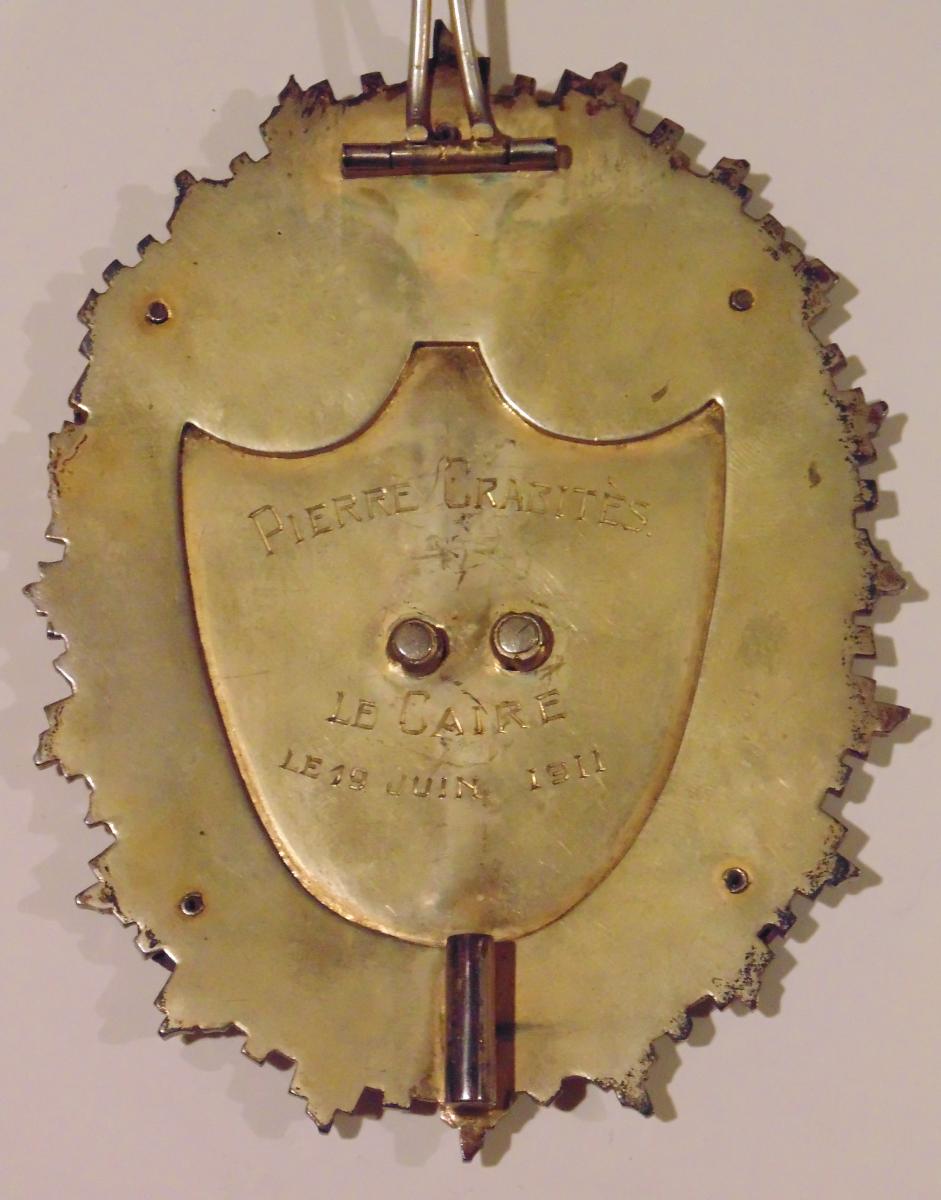
Reverse of the Crabitès badge showing the engraving of his name and the date of his appointment to the Cairo District Mixed Court (19 June, 1911).
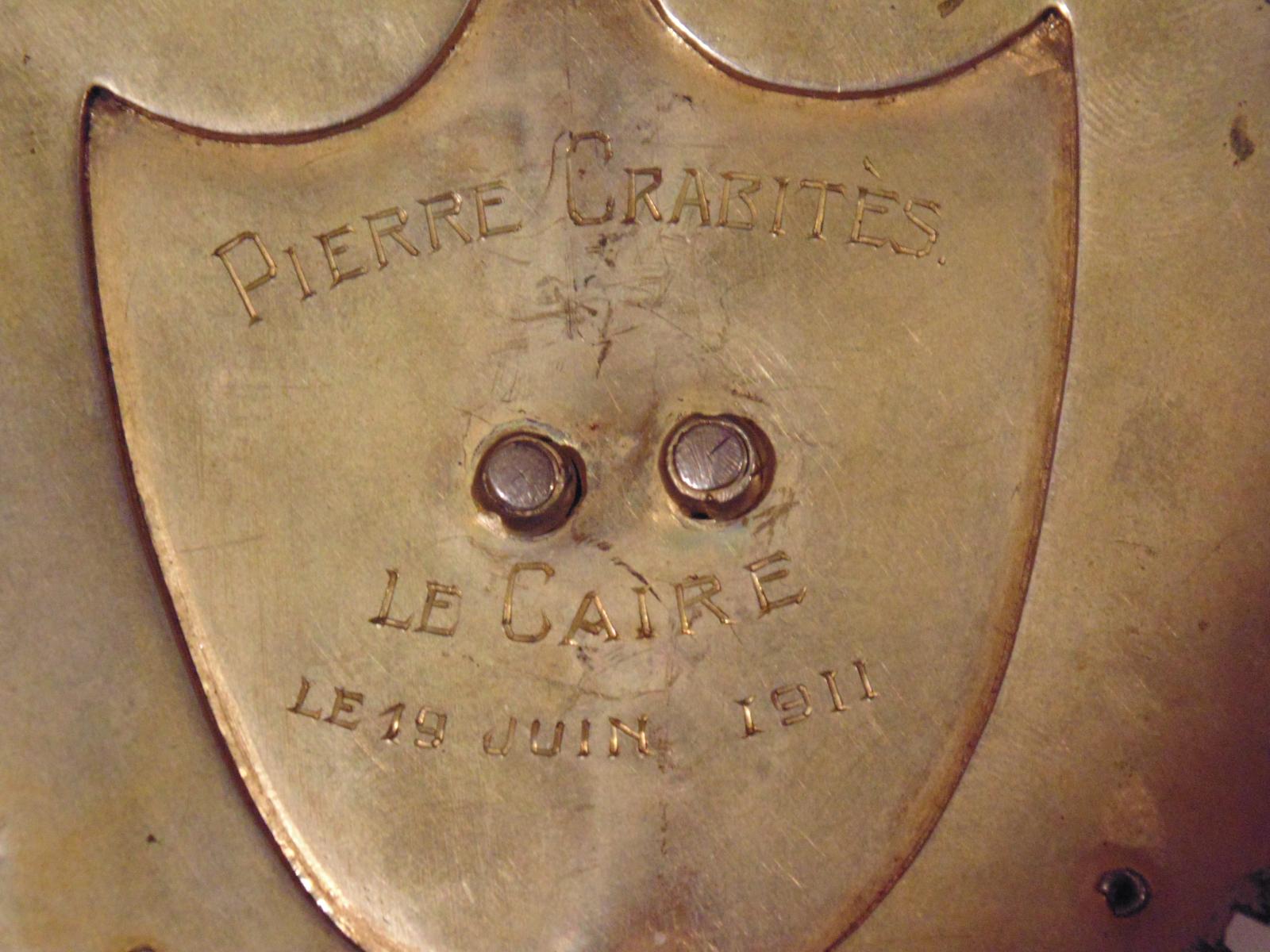
Cropped enlargement of the inscription on the reverse of the Crabitès badge. As noted in my 2 December, 2019 post, the Les Juridictions Mixtes d'Égypte 1876-1926: Livre d'or Édité sous le Patronage du Conseil de l’Ordre des Avocats á l’Occasion du Cinquantenaire des Tribunaux de la Réforme, par le: Journal des Tribunaux Mixtes. Alexandrie, Egypte, Février 1926 volume identifies the date when Crabitès was named to the Cairo court as 8 June, 1911 in the Appendix I listing on page xi of judges on the "Tribunaux de Première Instance" from the United States. Apparently, there was conflict between the US government and Great Britain over Crabitès nomination by US President William H. Taft to the Egyptian government that apparently was only resolved by the 19 June, 1911 date (US State Department Document 883.05/49: From Peter A. Jay, Agent and Consul-General in Cairo, to the Secretary of State in Washington D.C. 20 June 1911).
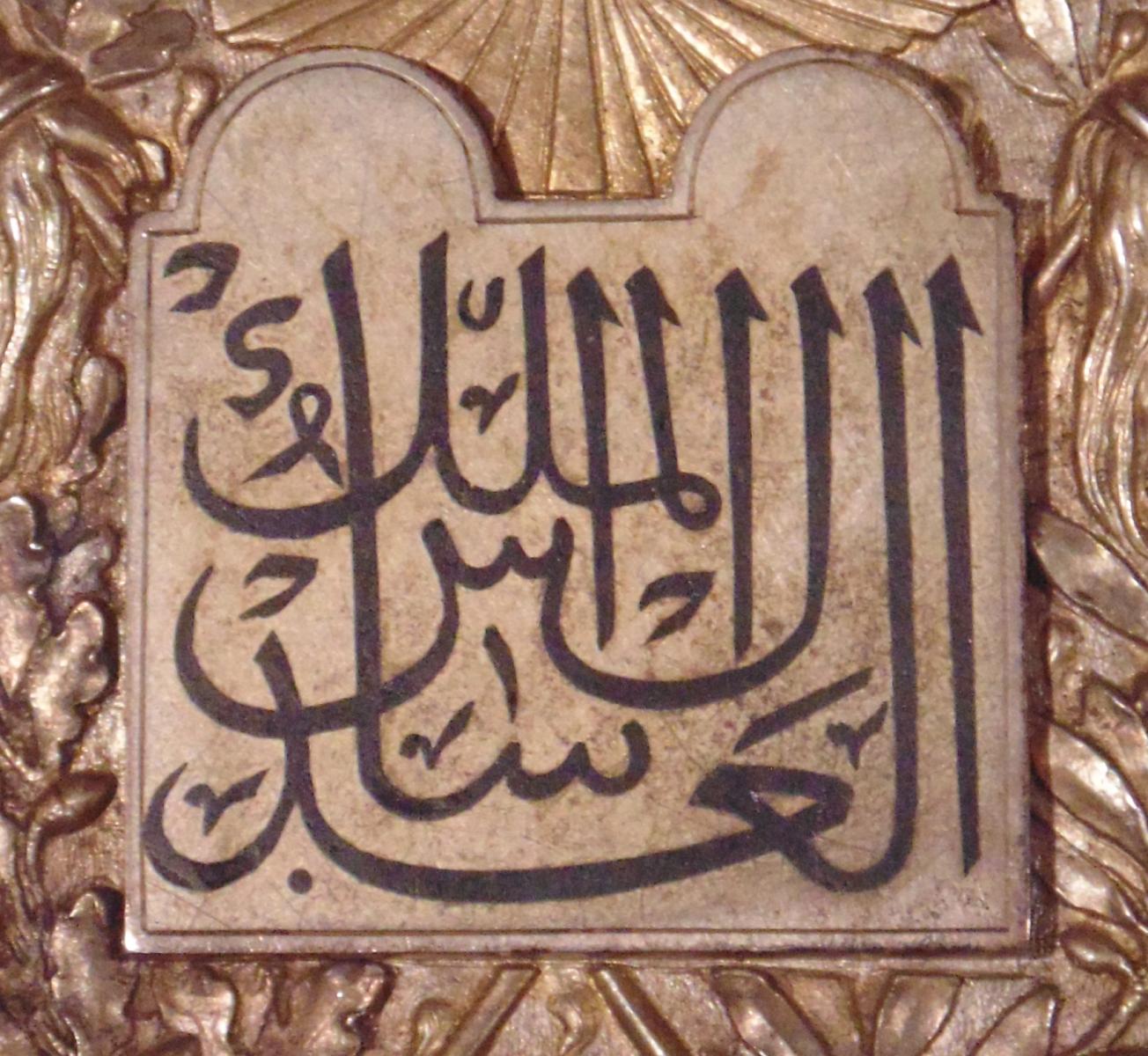
Cropped detail of the calligraphy on the central tablet inscription of the Crabitès Stobbe-made badge. This is a higher-resolution image of the calligraphy on the Crabitès badge than shown in the 13th photo of my post of 6 September, 2021 on this thread, comparing differences in the calligraphy by four identified makers of these badges (and at least 4 currently unidentified manufacturers of the Mixed Courts badges).
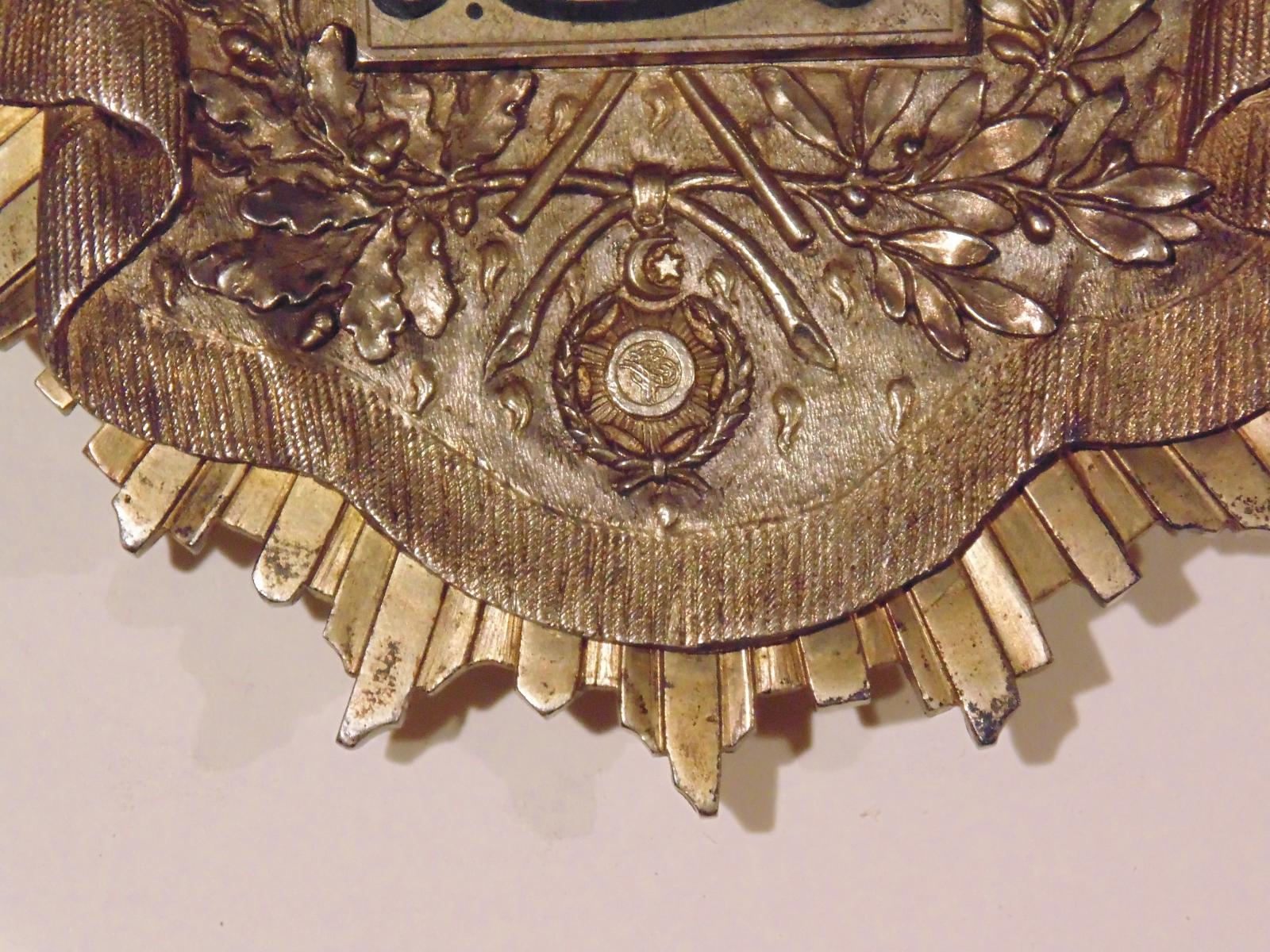
Close-up image of the Order of Medjidie element on the obverse showing the upside-down orientation of the tugra that is seen on all Stobbe manufactured badges. This image can be zoomed to see better the tuğ elements oriented downwards, the beyze on the right rather than left, and the hançer on the left instead of the right. I previously illustrated this element of the Crabitès badge as the 13th image in my post of 7 September, 2021 discussing and illustrating different manufacturers' orientation of the tugra. However, that image doesn't provide as much detail as the above higher-resolution photo of the inferior margin of this badge.
0 -
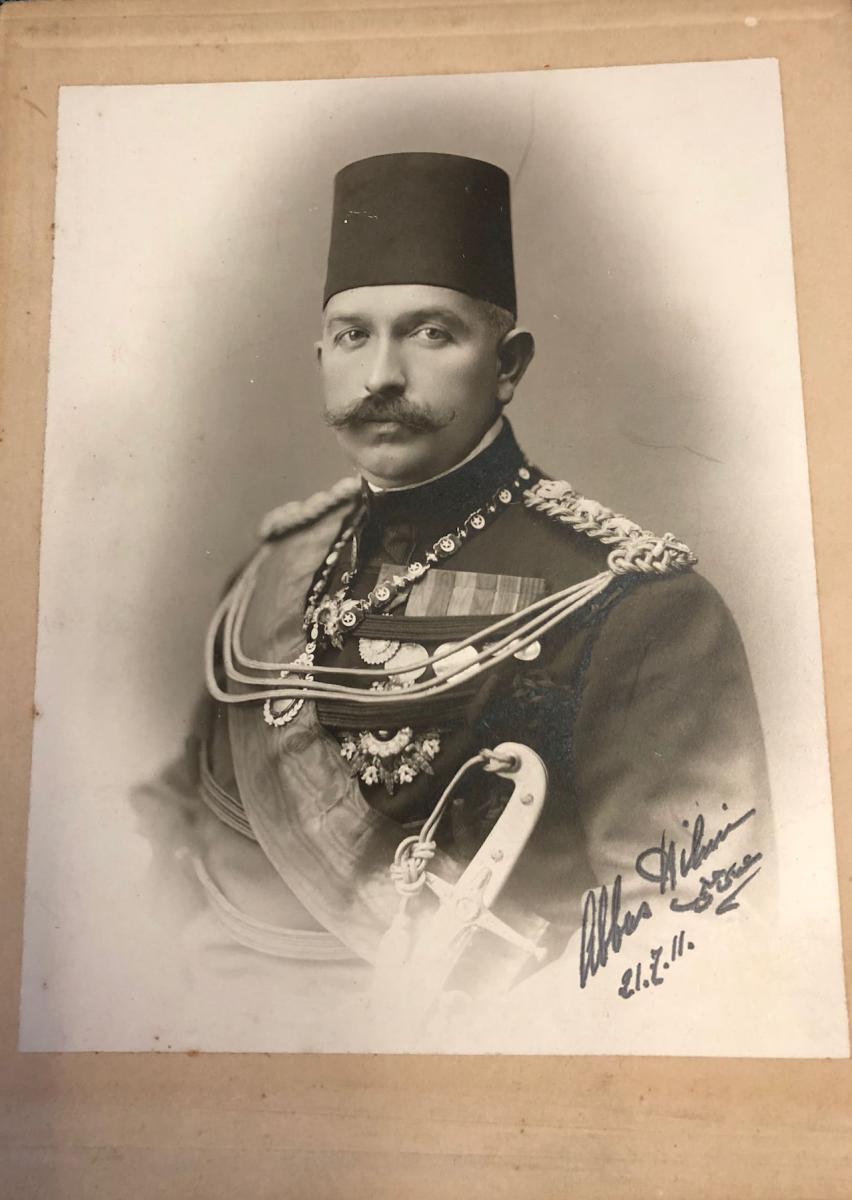
The previous higher-resolution version of the 1910 portrait photo of Khedive Abbas Hilmi II (the second photo in my recent post of 3 November, 2021 on this thread) allowed me to perform a google image search for other versions. I found one additional even higher-resolution online example of this portrait. This portrait, shown above, is the same 1910 photograph of the Khedive and came from an Italian language website of a collector of diverse militaria from ~1700-1946 (https://collezionemilitare.it/wp-content/uploads/IMG_4218.jpg). The matting is very similar to that on the two previous examples of the same matted portrait. The first version I initially found on the Foundation for Arab Music Archiving & Research website (http://www.amar-foundation.org/020-khedive-abbas-hilmi-ii/). The second example (a better-resolution cropped version of the same AMAR matted photograph) came from a Pinterest post by Hassan Abo Marym (https://www.pinterest.com/pin/642888915547710702/). The third version of this portrait, but not showing any indication of a contemporary matting, (the last image in my post of 3 November, 2021) came from AFIFI's Pinterest site (https://www.pinterest.com/pin/790663278323178294/). The above portrait lacks the legend with the number: “1328”, the Khedive’s name: “ABBAS II.”, the portrait date: “1910”, and the name of the studio: “ATELIER REISER, ALEXANDRIE & LE CAIRE.” seen in the lower right corner of the larger image of the matting in my post of 3 May, 2018 on this thread. However, the matting itself is identical with that in the previous labelled example. The photo is inscribed in pen with the name “Abbas Hilmi”, a short Arabic Inscription, and the date “21.7.11.” (27 July, 1911). The signature is probably original, the scratch of the pen nib and bleed of ink around that is visible when the signature is enlarged. This very high-resolution image can be zoomed for even greater discernable details, especially helpful in providing better views of the Khedive’s orders and medals, as well as his uniform.
Abbas Hilmi II wears the three highest orders of the Ottoman Empire: the Collar of Hanedan (Hanedan-ı Âli Osman Nişanı); the neck badge of the High Order of Honor (Nişanı Âli İmtiyaz) and the breast star for this same rare award (there also is a sash badge, not visible in this portrait). The sash is red and green, with red worn toward the right i.e., lower); and the Order of Glory (Iftikhar Madalyasi). Additionally, he wears four other insignia that were difficult to make out in the lower-resolution versions of this same portrait I previously encountered. I believe that this image has helped me securely identify the Khedive’s awards. A genealogical entry for Abbas Hilmi II on royalark.net (https://www.royalark.net/Egypt/egypt11.htm) lists several medals that are not identified in most other sources listing the Khedive’s honors (almost all derived from Wikipedia’s listing of honors) that include some of those shown in this portrait.
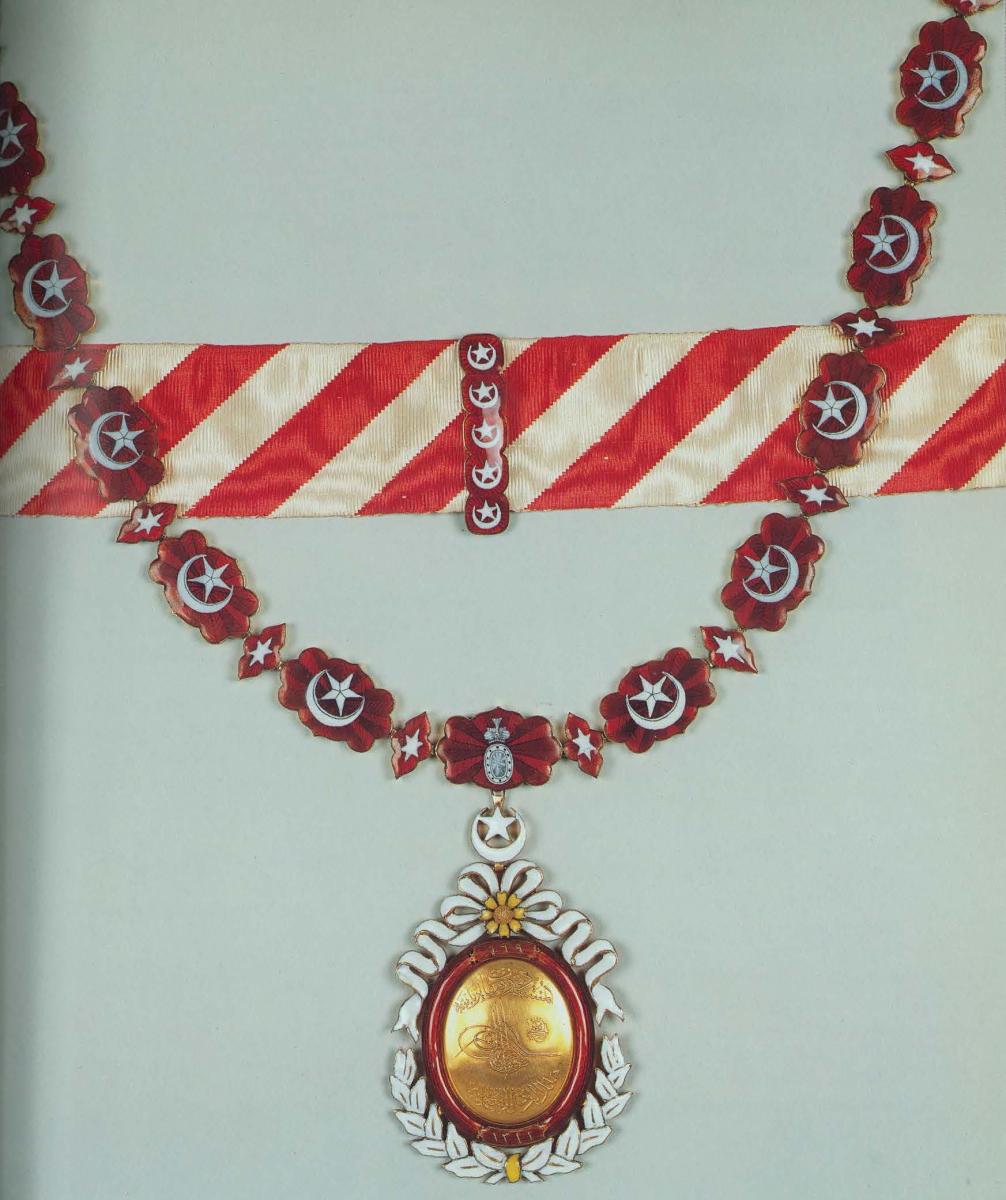
A moderate resolution image of the Ottoman Collar of Hanedan (Hanedan-ı Âli Osman Nişanı), from: Patterson, Stephen, 1996. Royal Insignia: British and Foreign Orders of Chivalry from the Royal Collection. Merrell Holberton Publishers, London. The photo probably represents the example presented to King Edward VII. The Royal Collection Identification Number is RCIN 441555a & b. The text description of the collar is on pg. 162, and the above image is on pg. 167 of Patterson 1996. I previously started a thread on 16 January, 2019 about this Collar in a thread titled “Question about the Collar of Hanedan” in the “Turkey” section of the “European States” here on GMIC. This is one of the images included in that thread, that also contains other detailed photos of the Collar of Hanedan contributed by other GMIC savants. Abbas Hilmi II received his Collar in 1895.
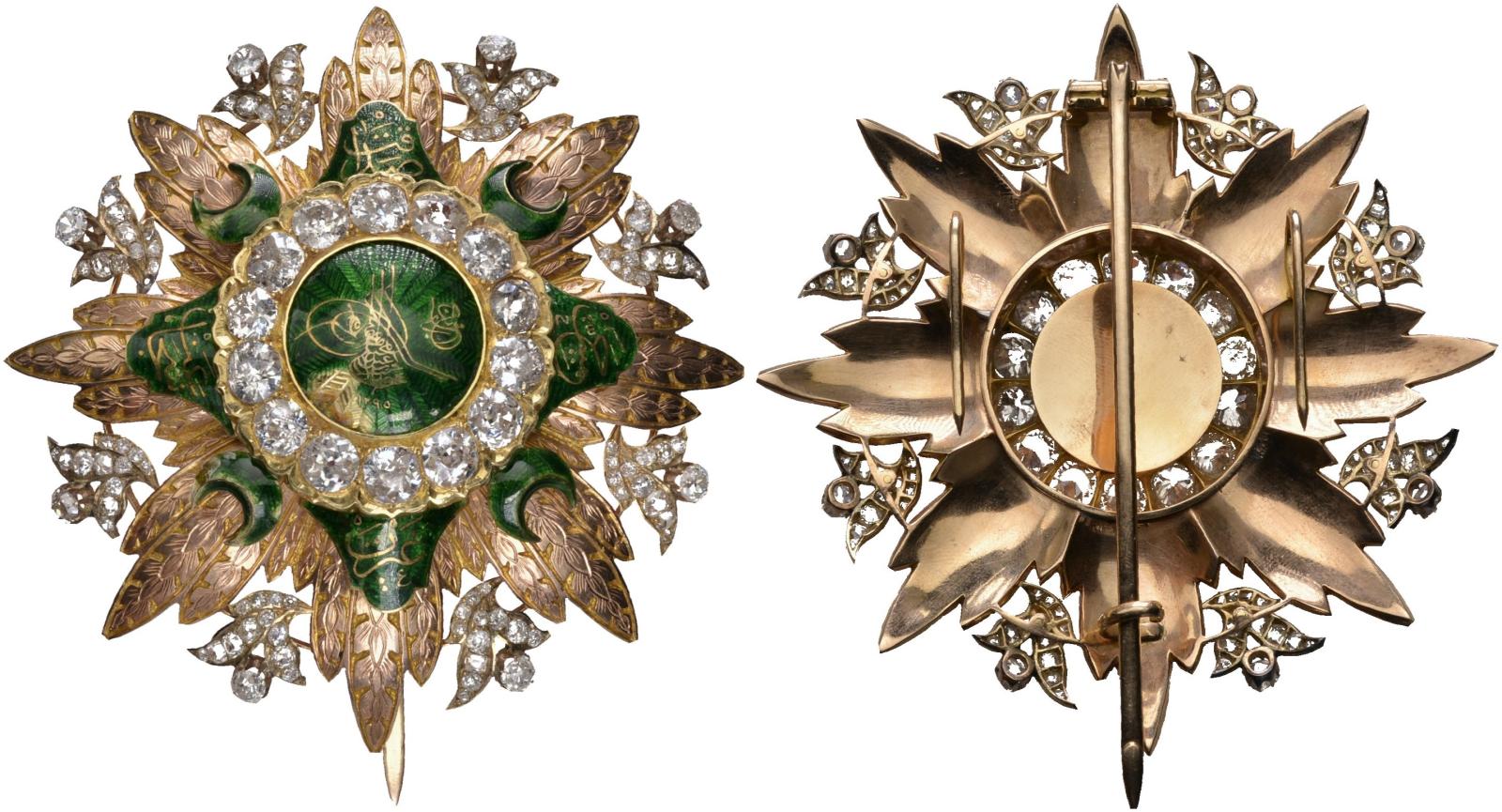
Very high-resolution image of a breast star of the rare Ottoman award Nişanı Âli İmtiyaz, the Exalted Order of Honor. This photograph can be enlarged for much better detail of its design. This image comes from an 18 August, 2018 auction (Auction 299, Lot 7176) by Fritz Rudolf Künker GmbH & Co. (https://www.kuenker.de/en/archiv/stueck/172685). The Künker auction description identifies the materials as engraved gold, enamel, 118 antique-cut diamonds, 14 of them (probably those forming the frame of the central medallion) are each approximately 0.3 carats. The breast star measurements are given as 96.8 mm (probably the height including the tunic pin) x 96.3 mm, and the weight is 110.5 g. There is some chipping of the green enamel. The tughra in the central medallion is that of Sultan Abdülhamid II and the date is AH 1295 AH (AD 1878), when the award was established. The four green enamel plaques with gold script surrounding the central medallion read: Sadâkat (loyalty); Hamiyyet (devotion); Gayret (zeal); and Şecâ'at (courage). This particular piece is attributed to Hussein ibn Ali al-Hashimi (from 1908 to 1924 Grand Sherif of Mecca and Emir of the Hejaz, and after 1916 the self-proclaimed first King of Hejaz), with a probable award date of 1908. Apparently, a photo of him wearing this breast star shows the same damage to the medallion’s enamel. The hammer price for this seldom-seen medal was 85,000 €. These same very high-resolution images are also archived on the Turkish language website (https://koleksiyonturkiye.blogspot.com/2019/01/ottoman-empire-high-order-of-distinction.html). Online photos of the neck badge, sash, and sash badge are very uncommon (except in portrait photographs, and I have not seen a photo with a sash badge) and mostly low-resolution. I stumbled on a couple additional photos of possible examples, but could not bring them up in subsequent online searches.
.jpg.aec711939519fa23be64b12063049516.jpg)
As noted, I cannot unambiguously make out all of the five medals worn above the breast star of the Nişanı Âli İmtiyaz. However, beginning from the middle of the Khedive’s chest I believe this first medal is the type 2 Ottoman Order of Glory (Iftikhar Nişanı), shown above. I have only found three sources showing this form of the insignia, none of those photos includes a ribbon. A description of this second variant on a Czech language military history website, Valka (https://www.valka.cz/Rad-slavy-t82564), discusses the different form of this award and provides 3 low-resolution images of this oval badge (showing an example similar to that above, the reverse of that same badge, and a version with sabers). The above image shows an example from a 29 November, 2000 auction (Auction 1264, Lot 481) by Christies (https://www.christies.com/lot/lot-turkey-order-of-glory-oval-diamond-set-badge-1938433/). The auction description identifies this as a “type 2 Order of Glory”. The auction listing states that the materials are a gold central medallion, surrounded by a silver band set with 28 diamonds, the 32 silver gilt rays of the embellishment are set with 4 diamonds each, and the suspension ring is identified as gold. The measurements are 48 mm tall x 39 mm wide. The description states this example has the tughra of Sultan Mahmud II, and states a possible date of c.1850. The most reliably accurate depiction of several aspects of the Khedive’s awards is in a portrait painting of Abbas Hilmi II hanging in the Atlı Köşk (the next image in this post). That portrait appears to show a solid red ribbon for the Iftikhar Nişanı. There are several online illustrations of ribbons for at least two other forms of this award that show a red ribbon with thin green stripes inset slightly from the margin. The Valka military history website describes the ribbon for the oval version of this award as red with a green border. It states that even this oval form was normally worn as a neck badge, except by some foreigners who wore it as a chest badge. The Valka article also points out that variation in the form of this award is common (principally referring to the version seen in the more common online images of the type 1 form of the badge) as no formal decree ever stipulated precise design parameters. Individual court jewelers interpreted the general design and ornamentation as they pleased.

Moderately high-resolution image of this portrait of Khedive Abbas Hilmi II (from: http://lcivelekoglu.blogspot.com/2013/12/tarihten-bugune-dusen-notlar-20-aralik.html). The image can be zoomed for greater details. This is the most potentially accurate official color portrait of Khedive Abbas Hilmi II readily available online. It currently hangs in the Prince Muhammad Ali Hassan Mansion, now known as Atlı Köşk (Mansion with the Horse), in Istanbul. This painting, as well as other portraits of the Khedive, helps show critical details of the other medals that are obscured by the first chest loop of the uniform in the 1910 photographic portrait. The above portrait painting provides good information on ribbon colors, and at least the overall color of the Order of Glory badge and the other medals, relative to the same awards shown in the 1910 Reiser Studio photographic portrait. The colors and configuration of the depictions of the Collar of Hanedan and of the Nişanı Âli İmtiyaz are quite accurate, lending confidence in using this as a source for complementary identification of the awards worn by the Khedive in the 1910 portrait, that was used as the model for the 1910 commemorative medal. I have not identified the date when this portrait was made. This painting also quite conveniently shows all of the same medals that are worn in the 1910 photographic portrait that is the first image in this post. Although several photos of the Khedive after 1910 show him wearing some foreign orders, this particular suite of medals also is featured in several other portraits.
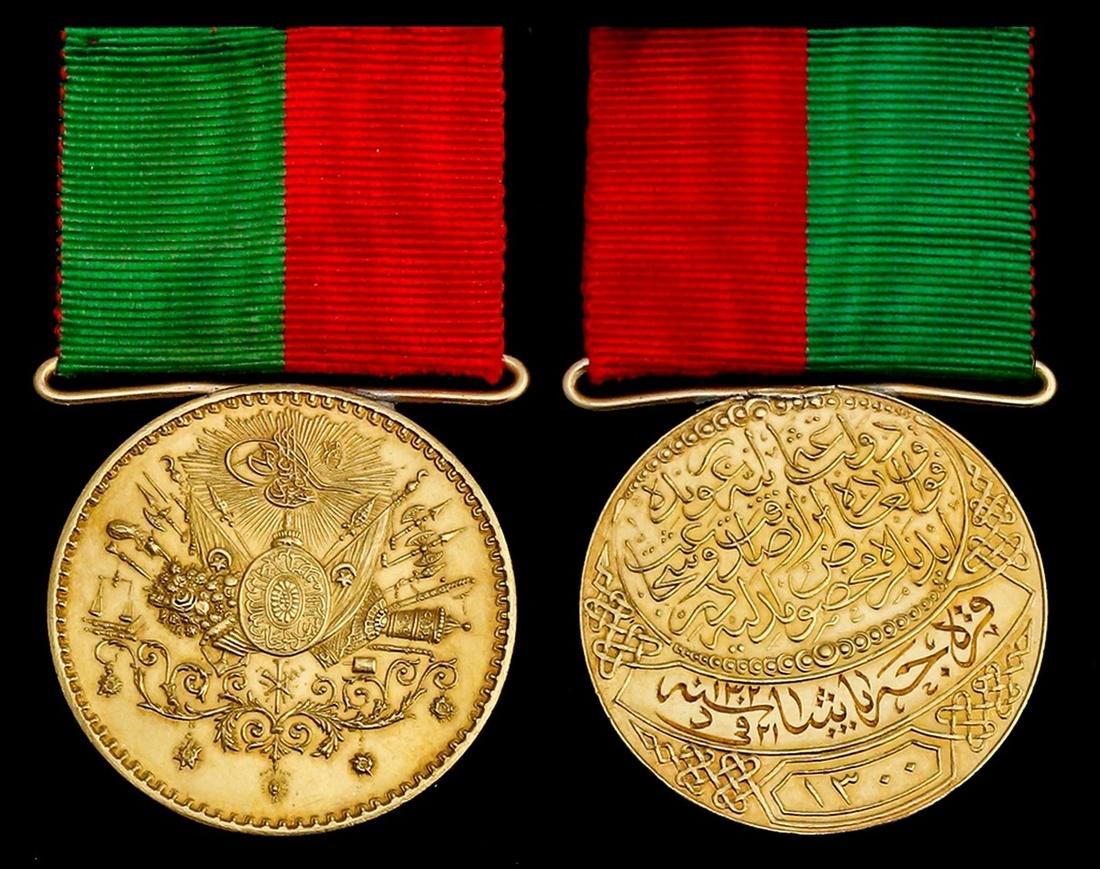
Given the color of the ribbons shown in the above portrait of the Khedive, and a couple of other fairly accurate painted portraits of Abbas Hilmi II, I believe that the 2nd and 3rd medals are likely to be the Ottoman Medal of Imtiyaz Medal (Imtiyaz Madalyasi), in gold and silver. As noted, royalark.net lists the Khedive as having been awarded the Imtiyaz Madalyasi in both gold and silver. Other photographic portraits show the elaborate suspension devices on both of these medals. I believe that the identification of these two medals is quite secure. The medal colors in the above portrait also suggest the gold and silver. The ribbon colors in the Atlı Köşk portrait show the correct ribbon color orientation of red on the right and green on the left for the Imtiyaz Medal. The example shown above of the Imtiyaz Madalyasi exhibits refitting with a different suspension from the original (obverse on L, reverse on R). This photo shows good details of the design of both faces of the Imtiyaz Medal and the reverse illustrates the engraved name of the recipient (it can be enlarged for much better detail of the medal design). This example is from an auction by Spink (Auction 17003, Lot 115), identified as a 2nd type of this medal (would the 2nd type not be just the addition of the bar with the date AH 1333 [AD 1915?] above crossed sabers for WWI?), and measuring 38 mm in diameter (https://spink.com/lot/17003000115). The reverse (R) is described as having a date of AH 1302 (AD 1884), however, it looks like AH 1300 (AD 1882) to me (which is the date of the inception of the medal). It is named to Qirah Hamad Shah. Many examples of the Imyitaz Medal on auction sites exhibit incorrect ribbons and replacement suspension devices. This is especially common on the gold examples that are less common on the auction market.
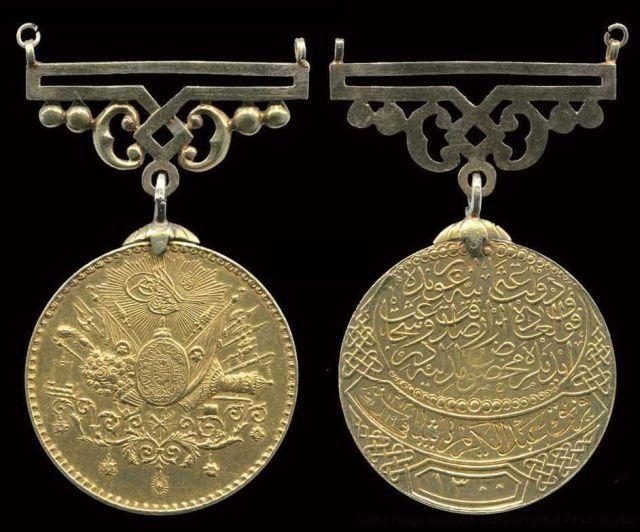
The above image of a gold Imyitaz Medal shows the distinctive original suspension device for this award. The same form was used for the examples in both gold and silver. In the 1910 photographic portrait of the Khedive from the Studio Reiser in either Alexandria or Cario, and on the Atlı Köşk portrait painting shown above, this unique element is not visible. However, other portraits of the Khedive do show the suspension devices and help identify the Imyitaz Medals (see below). The above good-resolution photo shows the obverse (L) and reverse (R) of the Imtiyaz Medal in gold. This comes from a Pinterest post of Halid Tezcan Keser (https://i.pinimg.com/originals/05/85/b6/0585b6fb4eaf46d95322afe54cbe83fe.jpg). Although this example does not have a ribbon, it does show quite well the suspension device, that is missing on the above example of an Imtiyaz Medal in gold. It also is another example showing an engraved name in the space above the date. The Pinterest site provides no information about this medal and I have not yet found a source for the image.
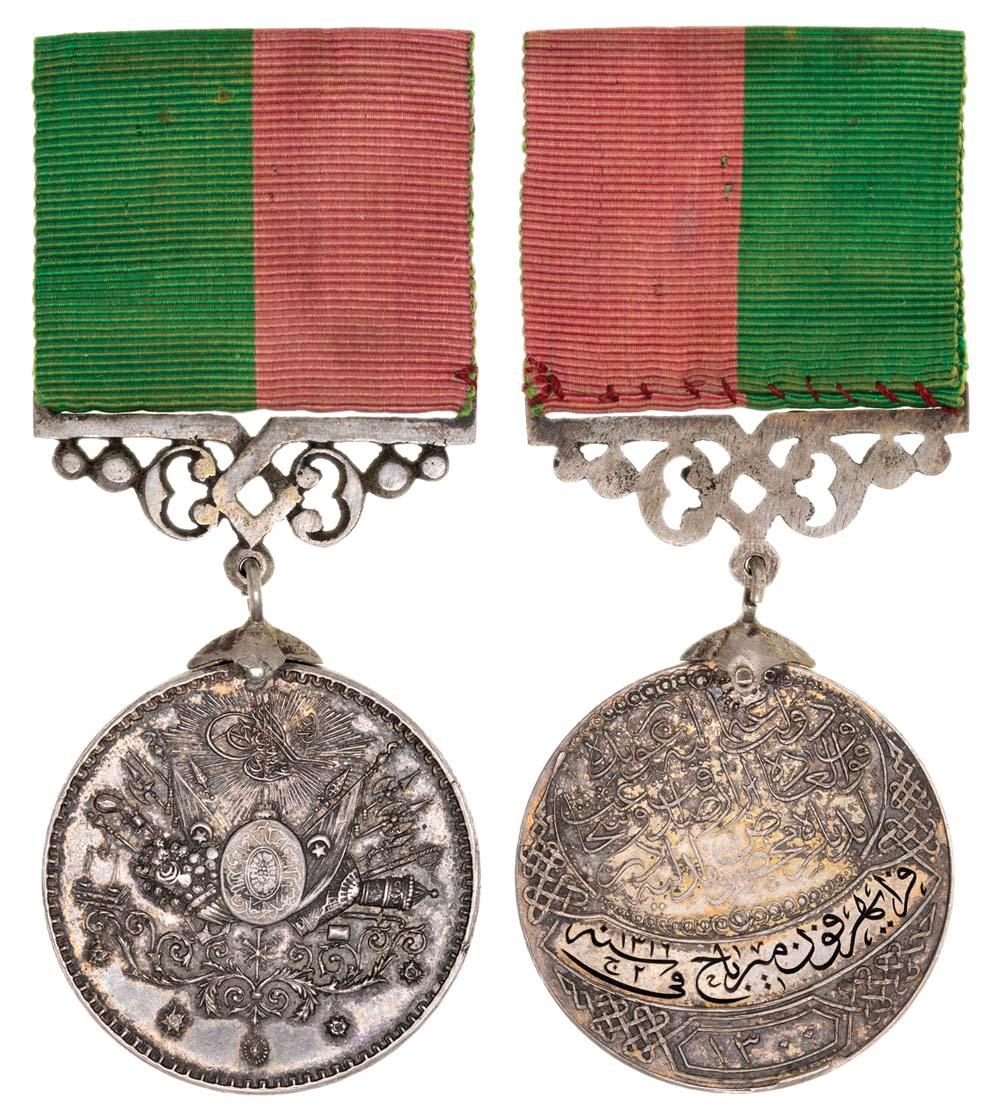
The 3rd medal from the center of the Khedives chest is certainly the Ottoman Imtiyaz Medal in silver. The above example shows the correct ribbon color configuration and an intact suspension device. This comes from a 2 September, 2021 auction (Sale 127) by Noble Numismatics Pty Ltd (https://www.noble.com.au/auctions/lot/?id=436721). This is Lot 1569. This image can be zoomed for bit of additional detail. Again, this example was selected because it had a recipient’s name inscribed above the year AH 1300 (unaccountably, the auction description identifies AH 1316 [ AD 1898]). I intentionally did not select photos of either the gold or silver Imtiyaz Medal with the WWI bar with date above crossed sabers. This is because Abbas Hilmi II was forced to abdicate by the British just at the outbreak of the war in 1914. The British perceived his uncle, Hussein Kamel, to be both more malleable to their desires for a ruler of Egypt and unenthusiastic for Abbas Hilmi II’s interest in seeking ways to make nationalist aspirations consistent with the monarchy. There are many more examples of the WWI Imtiyaz Medals in auction morgues than pre-WWI medals. Even many of these more recent examples are plagued by incorrect ribbons and suspension replacements. The bars with the date above the crossed sabers are made of either gold or silver as appropriate to the medal. Other auction listings provide diameter measurements between 37-38 mm. The website of Medals Database gives the following translations of inscriptions: obverse: Relying on Divine Guidance and Assistance, Abdulhamid Khan, Sultan of the Ottoman Empire; reverse; Medal for Those That Have Shown Exceptional Loyalty and Bravery for the Ottoman Empire (from: https://www.identifymedals.com/database/medals-by-country/turkey-medals/the-imtiyaz-medal/).

The above portrait of Khedive Abbas Hilmi II shows him wearing the neck badge of the Collar of Hanedan suspended by a gold and enamel suspension clip, without the red and white ribbon, as shown in my post of 18 January, 2019 in the thread “Question about the Collar of Hanedan”. This photo also shows the breast star of the Nişanı Âli İmtiyaz. Some details on the obverse designs of the Imtiyaz Medals in gold and silver worn by the Khedive are visible in this image. The form of the suspension on both these two medals also matches that seen on photographs of the Imtiyaz Medals with the original suspension devices. This portrait photo also appears to show the same two smaller medals at the viewer’s right as seen in the 1910 portrait photo, and that the 4th is darker (gold) and the 5th is lighter (silver). This version of the portrait photo of the Khedive comes from the flickr site of Hassan Kamel-Kelisli-Morali (https://www.flickr.com/photos/kelisli/501497462), who notes that the Khedive is wearing the summer military uniform of a Field Marshall. I do not know the precise date of this photo. However, an engraving of this image is used in the French news journal L’ILLUSTRATION of 27 June, 1903 (No. 3148. Pg. 430), in a short report on the Khedive’s visit to Britain. That 1903 image from L’Illustration is on the Salt Research website, Istanbul, Turkey (https://archives.saltresearch.org/handle/123456789/22980).

The above photographic portrait also shows the ribbon colors, the medal colors (gold and silver), and especially the form of the suspension for both Imyitaz medals. In this black & white image, the green of the left side of each medal’s ribbon and the upper band of the sash appears darker, and the red appears lighter. I do not know the date of this photograph. This portrait version comes from a post on Pinterest by AFIFI (https://i.pinimg.com/originals/50/c6/69/50c669a115bd933077a406fd096af617.jpg). There two online dated versions of this photo that provide some temporal brackets: first, the photo was published in the British journal The Sphere from 23 June, 1900, Vol 1 No 22, Pg. 3, in an article discussing a visit by the Khedive to Britain. Second, is a rare stencil colored lithograph Weißenberg illustrated broadsheet from 1895 based on this photo portrait (see the 4th photo in my post of 16 January, 2019 on the thread “Question about the Collar of Hanedan”). Alleged dates associated with a few online versions of this photo vary wildly, the earliest is 1889.
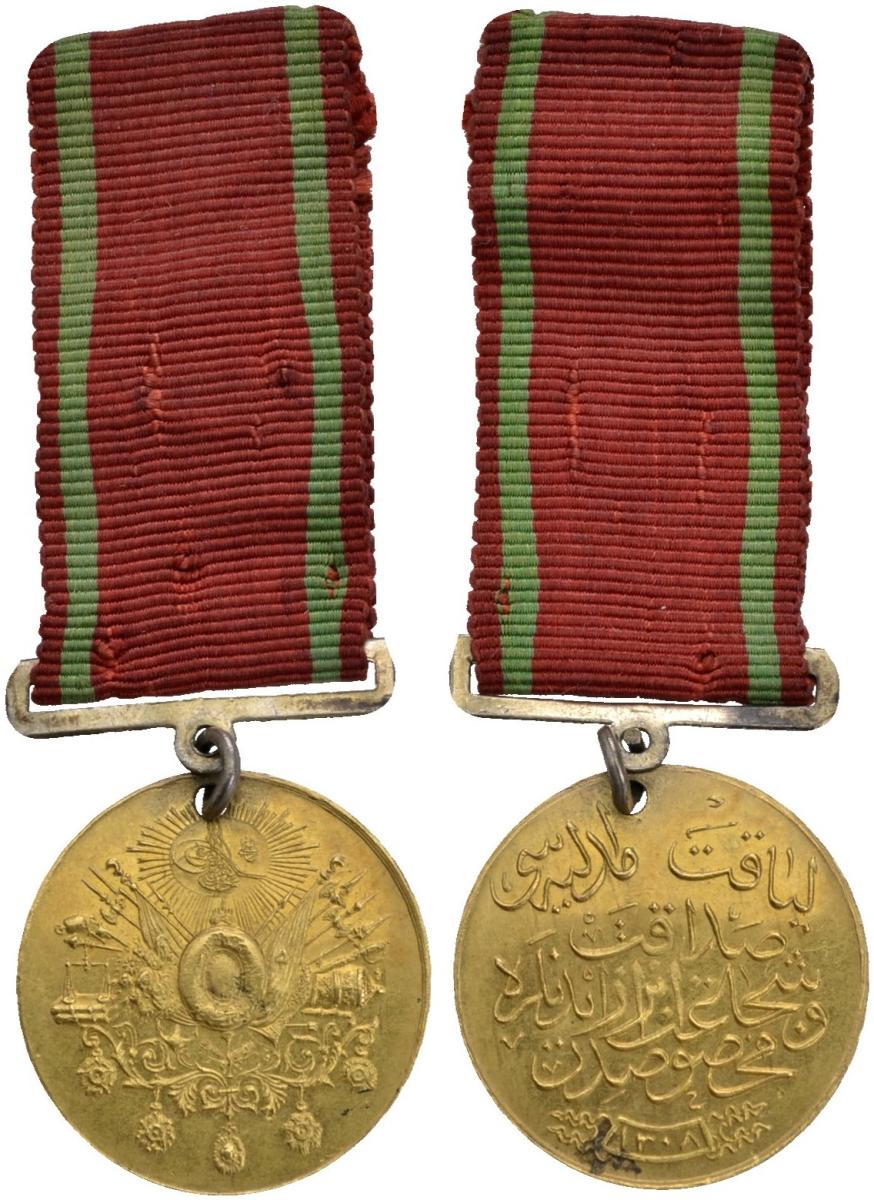
I think that the 4th medal from the center of the Khedive’s chest is the Ottoman Liyakat Medal in gold (Liyakat Madlyasi). Technically, this gold version ranked higher than the Imyataz Medal in silver, and should have been next to that gold Imyitaz. In the 1910 Reiser Studio photo of Abbas Hilmi II, this 4th medal is smaller than the two Imyitaz and has a ribbon with two thin marginal stripes (probably a red ribbon with two inset edge stripes in green). The Atlı Köşk portrait of the Khedive shows this medal with a ribbon that is red with two thin edge stripes of green. The Pinterest portrait of the Khedive wearing the summer Field Marshall uniform clearly shows the size difference of this 4th (and the 5th) medal compared with the two larger Imyitaz Medals. Auction site measurements reported range between 24-25.5 mm in diameter. The above Liyakat Medal comes from a fall 2017 auction (Lot 7284) by Fritz Rudolf Künker GmbH & Co. (https://www.kuenker.de/en/archiv/stueck/172345). Medals Database translates the inscription on the reverse as: Medal of Merit Specially for Those Who Have Shown Loyalty and Bravery, above the date of the institution of this medal, AH 1308 (AD 1890): (https://www.identifymedals.com/database/medals-by-country/turkey-medals/the-liyakat-medal/).

Obverse of the silver Ottoman Medal for the War with Greece 1897 (Yunan Muharabsei Madalyasi) from a 13 May, 2019 auction by eMedals, Item: EU16879.
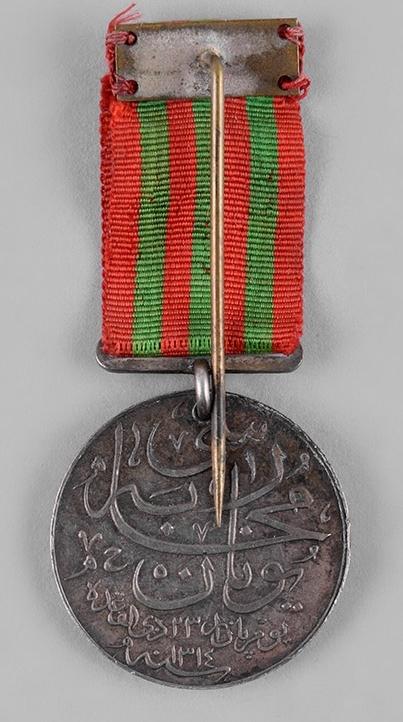
Reverse of the same silver Ottoman Medal for the War with Greece 1897 (Yunan Muharabsei Madalyasi) from a 2019 auction by eMedals.
The small 5th medal from the center of the Khedive’s chest was the more difficult for me to try and identify. This medal is comparably as small as the Liyakat Medal, and the 1910 Reiser Studio portrait shows a ribbon with 4 lighter stripes (green) and 4 or 5 darker stripes (red). The large, painted portrait of Abbas Hilmi II hanging in the Atlı Köşk shows this medal with a ribbon that has 3 green stripes and 4 red stripes. This ribbon pattern indicates the greatest probability that it is the silver Ottoman Medal for the War with Greece 1897 (Yunan Muharabsei Madalyasi). This medal commemorates the military success of the campaign, although the diplomatic outcome was settled more in Greece's favor. The above moderate-resolution images show the obverse of the medal as the 1st illustration and the reverse in the 2nd photo. This example comes from a 13 May, 2019 auction by eMedals, Item: EU16879 (https://www.emedals.com/turkey-ottoman-empire-a-medal-for-the-war-with-greece-1896-1314-ah). The auction description gives a diameter measurement of 24.5 mm. This is the same dimension given in most descriptions I have found on auction information that include measurements. I have seen examples with various numbers of stripes on the ribbon (5 green & 6 red; 4 green & 5 red). Although I have seen examples of this medal with different number of red and green stripes, Demir states in a post of 25 March, 2013 on the thread “Greek war medal” started by lew on 15 March, 2013 in the “Turkey” section of “European States” here on GMIC that the ribbon should have 4 red stripes and 3 green stripes. I also have seen a few examples with more elaborate suspension devices (in addition to the chain ribbon for officers). The flickr portrait of Abbas Hilmi in the summer Field Marshall uniform may show either the same suspension as seen on the eMedals example shown above, or possibly a more decorative suspension. However, the detail of the photo is not good enough to determine which form the suspension exhibits. The very high-resolution engraved version of this portrait from L’Illustration of 27 June, 1903 lacks some precise details, but shows a plain suspension. The obverse design includes the tughra of Sultan Abdul Hamid II with laurel wreath and a rose. The reverse is inscribed: Greek War Day - Sunday, 23rd of Zildake (11th month of the Hejira calendar), 1314' (1897AD), according to the translation provided by Medal Medaille for a listing of an example of this medal, with an incorrect ribbon (http://www.medal-medaille.com/sold/product_info.php?products_id=717).

A photograph of Khedive Abbas Hilmi II from Egyptian Royalty blogspot (http://egyptianroyalityandglory.blogspot.com/2010/04/khedivi-abbass-helmi-ii-great-statesman.html). This photo is undated and no contextual information is available on this website or from correlations with other examples of this image (I have not yet found better resolution or documented versions of this portrait). It shows Abbas Hilmi II wearing all of the same medals seen in the 1st and 10th portraits above, those discussed in this thread.

The last portrait I wish to include is one of an older image of Abbas Hilmi II. This portrait also comes from the Pinterest site of AFIFI, showing Abbas Hilmi II later in life following his exile from Egypt (https://www.pinterest.com/pin/790663278323257394/). I cannot tell from the low-resolution of this image whether this is a painting or a photograph. I favor it being a painting. It shows the former Khedive with white moustaches, eyebrows, and hair. He appears to be wearing the same awards as in the 1910 Reiser Studio portrait photo of the Khedive. The costume appears copied from earlier examples (such as the 1st and 10th photos in this post), the older Abbas Hilmi II's torso is not his actual more robust girth seen in photographs of him in middle and older ages. Some photographic portraits of the Khedive do show him wearing a few foreign honors, however he appears to have preferred a modest display, dominated by Ottoman awards. The reprise of this ensemble of awards from relatively early in the Khedive's reign is either: an artist's uniformed use of early images of the costume with the older exile's facial features (more likely); or an actual nostalgic tribute if this portrait was executed for Abbas Hilmi II (less likely).
The very high-resolution of the 1910 portrait of Khedive Abbas Hilmi II that is the first photo in this post comes from an Italian language website documenting an extensive private collection of his historical military artifact covering a total period of 1700-1946, specializing in materials and documents from 1848-1946 (collezionemilitare.it: https://collezionemilitare.it). The collector identifies the materials he collects as: cavalry uniforms, helmets, hats, material pertaining to particular military personnel and historical figures, medals, decorations, honors, orders of chivalry, badges, flags, military paintings, photographs, documents, weapons, etc. The website also repeatedly expresses an interest in obtaining additional materials, including entire collections of militaria, family collections, and items from military libraries and archives. The individual who runs this personal website, Marco Torelli, provides some images of grouped items in his collections, photos of the facility where they are housed, and several eclectic sets of montage illustrations of groups of items in his collection. As far as I can tell, there is no search tool to look for materials or information on his website. Some internal links do connect to a range of different topics on collezionemilitare.it, however there is not a systematic presentation of different areas of interest to Torelli. I found this photo of Abbas Hilmi in a section discussing King Vittorio Emanuele III of Italy (1869-1947) who reigned as the King of Italy from 29 May, 1900 until his abdication on 9 May, 1946 (https://collezionemilitare.it/mostra/re-vittorio-emanuele-iii/). He was also the Emperor of Ethiopia (1936–1941) and the King of the Albanians (1939-1943). There is no information on Marco Torelli’s website providing any documentation of why this portrait photo of Khedive Abbas Hilmi II is associated with the materials regarding King Vittorio Emanuele III. My assumption would be that this signed photograph was given to Vittorio Emanuele by the Khedive as a personal memento. However, other than royal courtesy, as expected between Italy and Egypt, the specific contexts of any relationship they may have had is unclear to me. Both rulers sympathized with Parliamentary institutions within their countries. Abbas Hilmi II with more insight and ethics in how he trod that unworn path for rulers, but with no greater luck. When Vittorio Emanuele abdicated in 1946 in favor of his son Umberto II (hoping that action would reinvigorate the Savoy monarchy in the face of a referendum to abolish the institution that eventually did succeed with 54% of the vote by the Constitutional Assembly; certainly attributable to his unflagging support for Mussolini until shortly after the first bombing of Rome on 19 July, 1943, even when the many members of the Fascists party itself and the Fascist military had previously pressured the King to dismiss Mussolini, politicians all supporting the open belief that only Fascism could save Italy from the alternatives of Anarchy or Communism), he went into exile in Alexandria, Egypt, welcomed by King Farouk I. He died there the next year and was buried at St. Catherine’s Cathedral in Alexandria (his remains were repatriated to Italy in 2017).
0 -
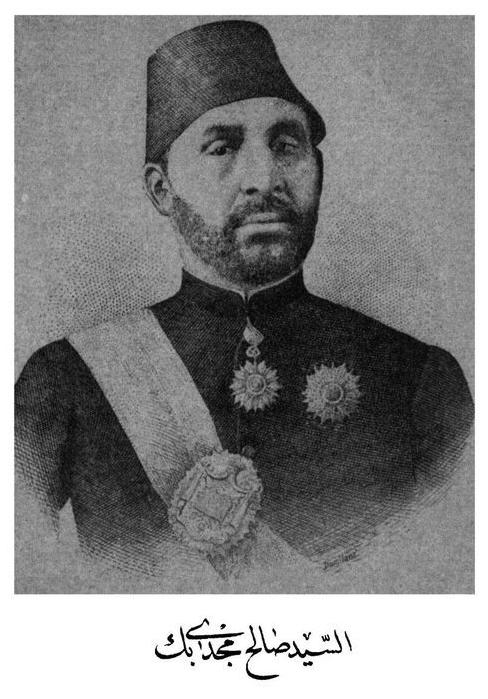
I found this engraving of a man wearing a sash and badge of Egyptian Mixed Courts, along with the stamboulin coat and tarboosh. The clothing suggests this individual may have been a Mixed Courts judge rather than one of the other officials who also wore the sash and badge. However, there is a suggestion in the engraving that this may be a bi-colored sash (that might suggest a role either with the Parquet or in a non-judicial role for this individual). Although the details of the neck badge and breast star he is wearing are not completely clear, they appear to resemble the Tunisian Order of Glory (Nishan Iftikhar). I am unfamiliar with this Order, so any corrections to my suggestion by more knowledgeable individuals here on GMIC are much appreciated. This image came from a Pinterest site by Mohamed Elhabiby (https://www.pinterest.com/pin/770889661211491510/). The same image also was posted to a set of Pinterest images by Peter Miller (with the same URL). A possible source is attached to the image (ia0164.us.archive.org), however this does not pull up any source for this image. I apologize for my ignorance fo Arabic to be able to read the inscription. I doubt any online translations I tried provide any useful information ("Mr. Sa'Adab"). The man appears likely to be Egyptian. I have checked the 50th anniversary volume in the Les Juridictions Mixtes d'Égypte 1876-1926 and not found any clear match. One noticeable aspect in the photographs in that book is that beards generally become much less common after 1880-1890 among judges and officials of the Mixed Courts.
0 -
I recently came across two higher-resolution versions of the 1910 photo portrait of Khedive Abbas Hilmi II that I posted here on 28 April and 3 May, 2018. In that post of 28 April, I identified this studio image as the basis for the portrait bust on the 1910 Abbas Hilmi II commemorative medal. This is apparently the only medal to have used this portrait of the Khedive, and is distinctively different than the portrait of the younger Abbas Hilmi II used on the better-known commemorative medals (those for the c. 1892 International Import & Export Suez Competition and the 1895 celebrating the International Exposition of Progress). I included in that 28 April post a version of the more commonly seen portrait of the young Khedive that served as the basis for that medal bust, produced by Stefano Johnson of Milan. The photo of 28 April (4th-to-last image in that post) is a low-resolution version of this image. I posted a higher resolution version on 3 May that is matted with a 1910 date, the name of the photo studio (Atelier Reiser, Alexandrie & le Caire), and the calligraphic signature of Abbas Hilmi II that was on the Foundation for Arab Music Archiving & Research website (AMAR), for a podcast (#20, 1 August, 2013) of music associated with Abbas Hilmi II Pasha (http://www.amar-foundation.org/020-khedive-abbas-hilmi-ii/). The slightly-higher resolution image directly below (the 1st photo in this post) is a cropped version of that portrait in the same matting.
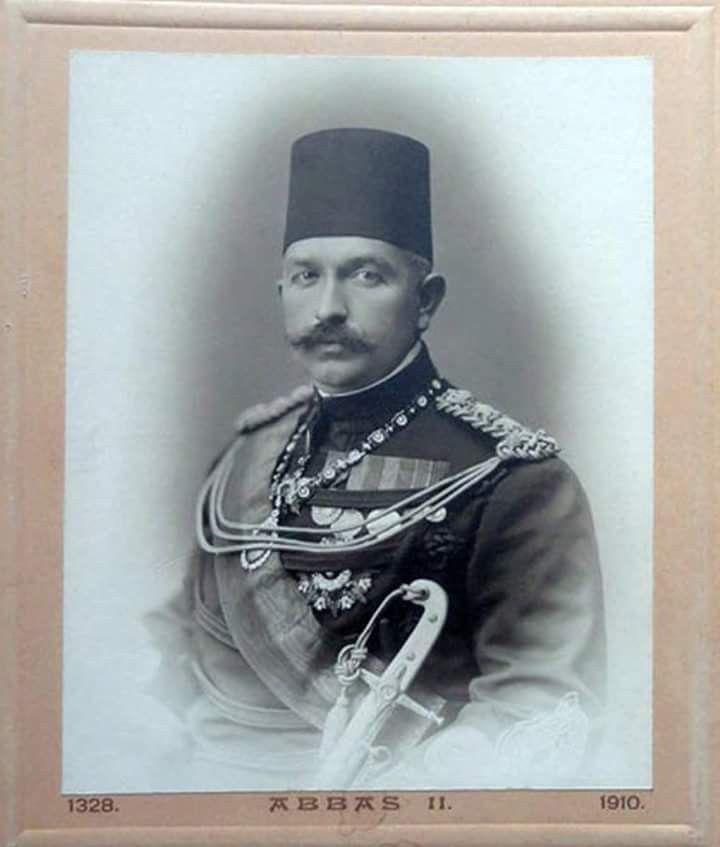
I found the above slightly higher-resolution, cropped version of the matted image I posted on this thread on 3 May, 2018 image from the AMAR website, that includes some of the matting (it is from the same photo, the staining on the mat between the letters “…BAS…” is identical to that seen on my 3 May 2018 post). The cropping removes the name of Atelier Reiser and the signature of Abbas Hilmi II. This image is from a Pinterest post by Hassan Abo Marym (https://www.pinterest.com/pin/642888915547710702/).
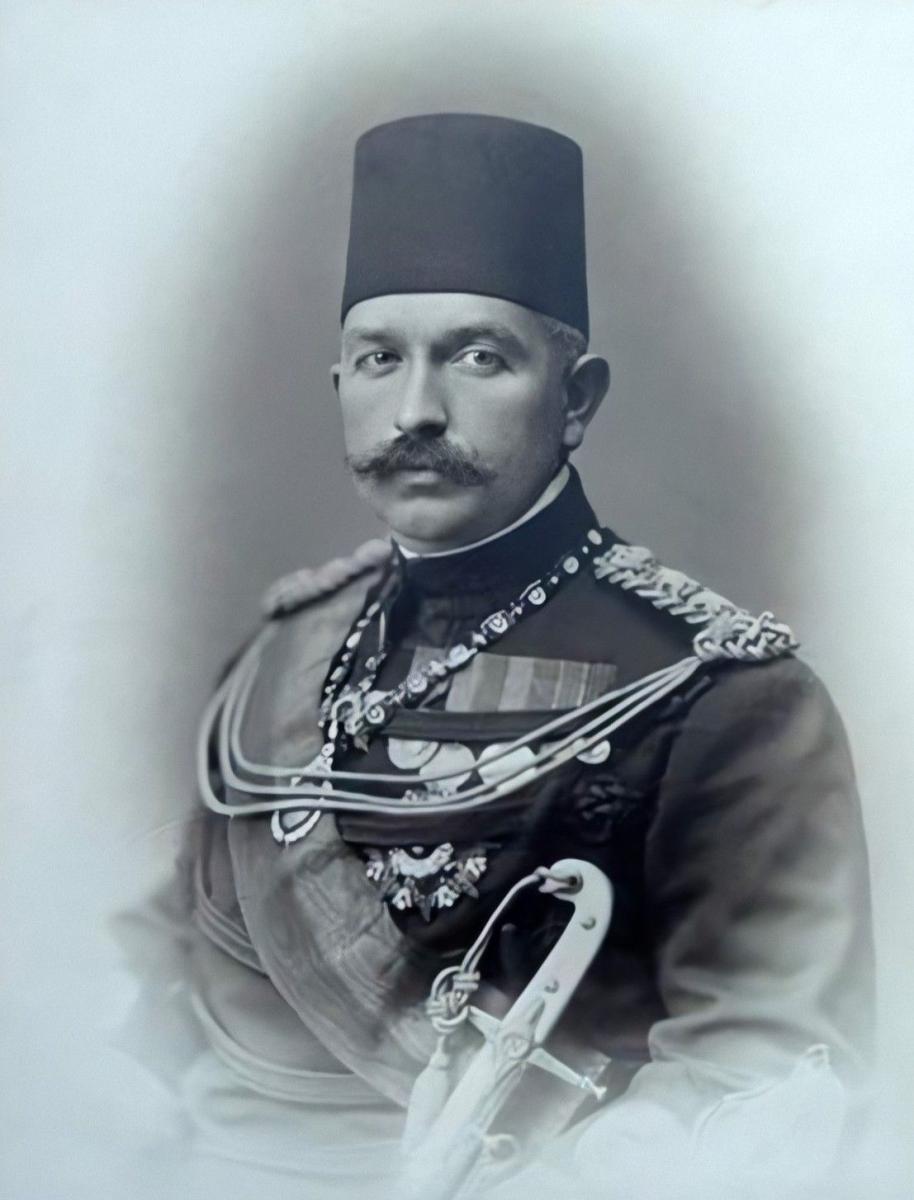
Above is much higher-resolution version of this same 1910 portrait of Khedive Abbas Hilmi II that is posted on AFIFI’s Pinterest site (https://www.pinterest.com/pin/790663278323178294/). This photo can be zoomed for more details. This version from Pinterest shows only the photo and no matting. No source attribution is given for this photograph. The Khedive is wearing the Collar of the Order of Hanedon (normally awarded only to princes & princesses of the Ottoman Royal family and to some heads of state) and the neck badge and breast star that are identified by one Egyptian colleague as the Supreme Order of Imtiyaz in Brilliant. Can anyone here on GMIC confirm or correct that identification? This is the same neck badge and breast star shown in a common portrait of Abdulmejid II, the last Caliph of the Ottoman Dynasty (As shown in the 8th photo of my first post on the thread "Question about the Collar of Hanedon", 16 January, 2019, In the "European States" section under "Turkey"). Is the sash that of this Order of Imtiyaz (most color portraits of Abbas Hilmi show it with red above green, a few reverse that order)? I cannot identify the other three full-sized medals and the two miniatures. Two of those medals appear in most portraits of Abbas Hilmi II, in color versions the ribbons show green on the left and red on the right, would any of these be Medals of Imtiyaz (possibly one in gold and one is silver)?

Image of the bust on the obverse of the commemorative medal celebrating the anniversary of Khedive Abbas Hilmi II’s coronation and return from the haj. This shows the resemblance between the above 1910 portrait photo of the Khedive and the form of this bust designed by the family of medallists in Paris, Charles Massonet et Fils. From a 6 December, 2012 auction (Lot 1338) by Dix Noonan Webb (https://www.dnw.co.uk/auction-archive/lot-archive/lot.php?department=Medallions&lot_uid=224096). This very-high resolution image can be zoomed for much greater detail and comparison with the 1910 portrait of the Khedive.
0 -
I came across photos and documentation of this elaborate early 19th century Napoleonic medal storage cabinet in late 2019, that is designed with Ancient Egyptian-inspired artistic elements, and I am only now putting this on GMIC. I encountered this information fortuitously while performing internet searches for Egyptian orders and medals. There is an example of this cabinet in the Victoria and Albert Museum (UK) and in the Metropolitan Museum of Art (USA). Both are exceptionally well-illustrated with very high-resolution images, as can be seen below. Additionally, I came across one drawing in the Musée des Arts Décoratifs in Paris that is attributed to Charles Percier, who is probably the designer of this medal cabinet. I thought this is a beautiful part of the history of military and commemorative medals, as well as the history of medal collecting, and a lot of good photographs are provided online. Since I first stumbled upon the information about this medal cabinet, the images and some of the textual descriptions have been picked up and re-posted to some additional photo sharing social media websites (i.e., Twitter, Reddit, etc.).
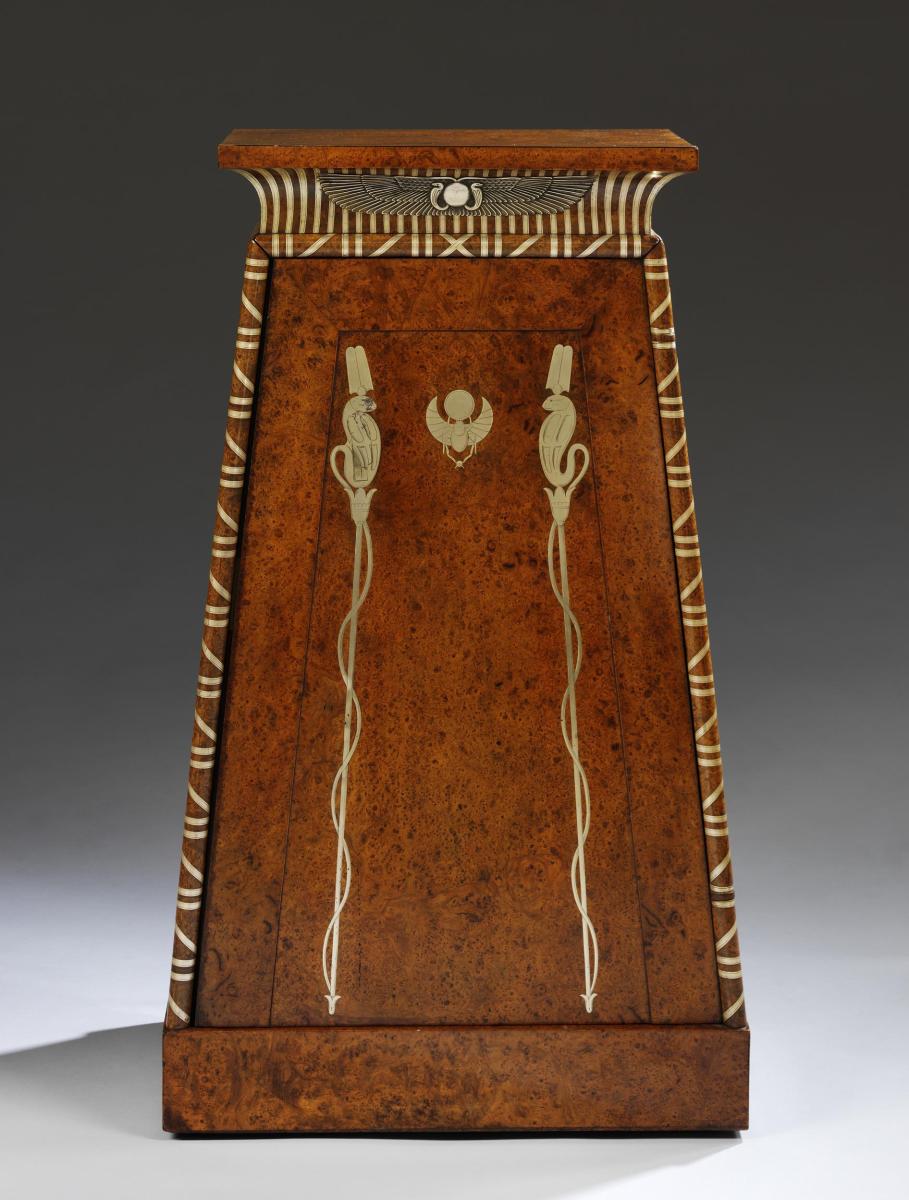
All of the high-resolution photographs of the Victoria and Albert museum’s example of this medal cabinet are copyrighted by the by the Victoria and Albert Museum, London. This Napoleonic medal cabinet is in the Furniture and Woodwork Collection, its accession number is: W.8:1,2-2014, and the images and textual description can be found at: https://collections.vam.ac.uk/item/O1284580/medal-cabinet-martin-guillaume-biennais/. All of the photographs in this post can be enlarged for greater details of the design and construction details of this piece. This beautifully crafted medal cabinet was purchased by the Victoria and Albert Museum following a successful appeal to the public for funds to acquire this cabinet in July 2014 before it was exported (raising £534,000). The first photo above shows the front of the medal cabinet. A V&A article about the acquisition calls it “…perhaps the finest piece of French Empire furniture in Britain today.” The cabinet was probably made c. 1810, and was commissioned by Napoleon Bonaparte. As is well known, Napoleon used medals that commemorated the most noteworthy events in his career as an important propaganda tool. Over 2,000 medals were struck to celebrate his accomplishments. A possibly apocryphal story of an archaeological discovery of a medal of the Roman general Julius Caesar during his Egyptian campaign (1798) was considered an omen to him. Likewise, the alleged uncovering of coins of William the Conquerer during the construction of Napoleon’s tent at Ambleteuse in 1803, was used as a prognostication of Napoleon’s potential victory over Britain as he planned an invasion.
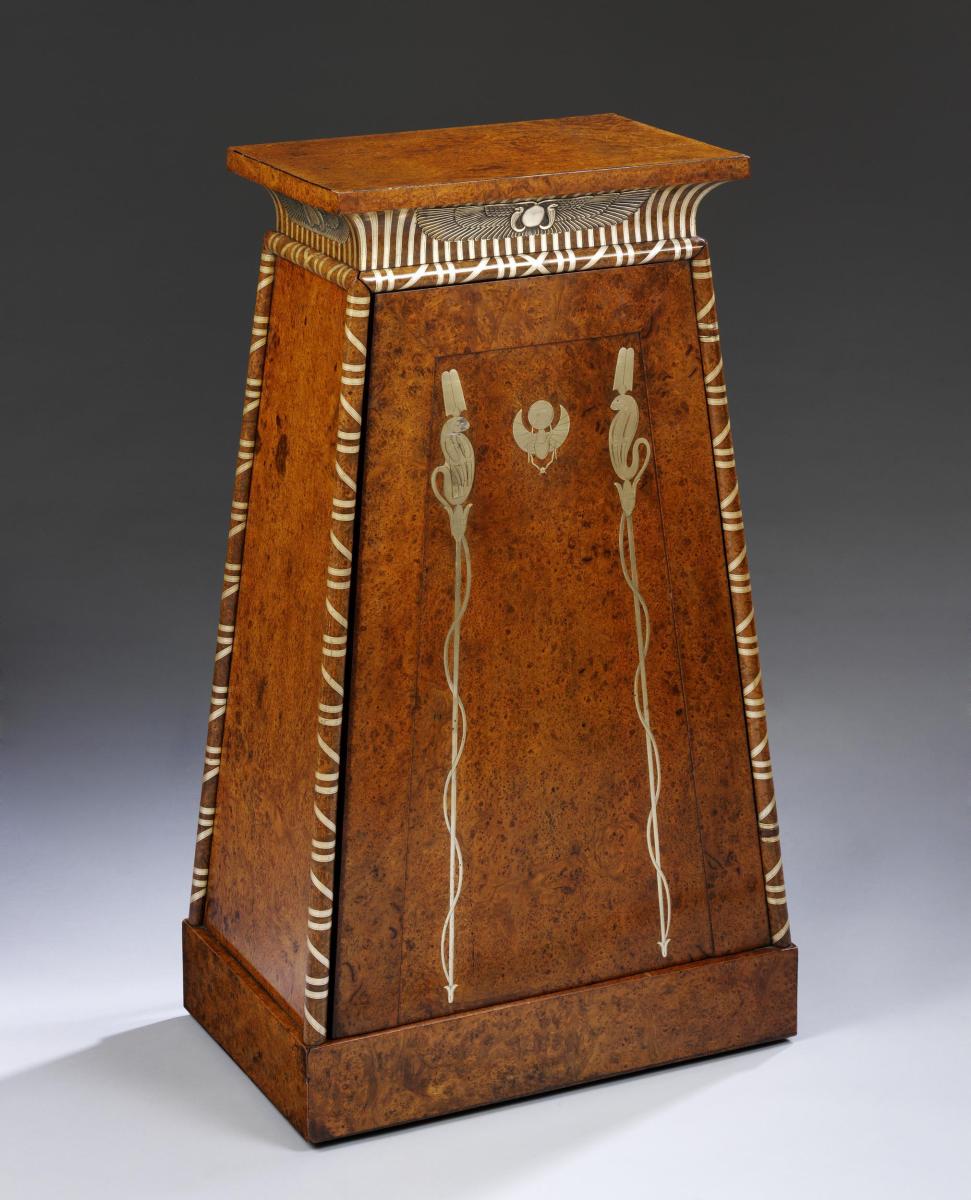
The Victoria and Albert Museum catalogue information identifies this medal cabinet as an oak case veneered on the exterior with thuya burl (Teraclinis articulata). The interior is veneered in mahogany (likely Swietenia mahagoni, the species identified for the Metropolitan Museum example that is illustrated below). The drawers and runners are solid mahogany. A small line of ebony is inlaid around the upper margin of the cornice. The plinth is not original, but also is veneered in either amboyna (Pterocarpus indicus, or P. spp.) or thuya burl. The cabinet is decorated in 950 silver inlay. This includes several Ancient Egyptian-themed elements and engraved silver bands along all of the rounded molding on each side and the lower margin of the cornice. The front and back are inlaid with a central winged silver scarab element holding a sun’s disk in its forelegs, representing Kheper, the personification of the rising sun. The back legs are depicted piercing a sphere, a fantasy elaboration that is not a component of Ancient Egyptian design. On both the front and back, the Kheper element is flanked on each side by silver Uraei, cobras symbolic of royalty, wearing double ostrich feathered headdresses with sun symbols (the Amun crown), their bodies twined around a single lotus stalk. The cornice is decorated with vertical silver bands and each face has a silver winged solar disk flanked by double Uraei. These winged disks are identical on the front and back, and exhibit a slightly different design for each of the two shorter sides. The cabinet dimensions are: 88.2 cm high x 52.3 cm wide x 31.8 cm deep (all given excluding the non-original plinth).
The form of the cornice of this cabinet is based on a temple pylon of the Apollonopolis Parva in the Coptite nome (now Qus) in Upper Egypt. An engraving of the field drawing by the French artist Dominique Vivant-Denon (1747-1825), one of the 167 savants who accompanied Napoleon’s Egyptian Campaign and recorded Egyptian architecture and antiquities in 1798-1799, published this engraving of the Apollnopolis Pylon, along with many other architectural engravings, images of famous Ancient Egyptian monuments, and some engravings of people, in a popular travel book. This pylon is shown in both Plate 36 and Plate 80 in: Denon, Dominique Vivant, Baron, 1802. Voyages dans l basses et la haute Égypte, pendant les campagnes du géneral Bonaparte par Vivant Denon 2 Vols. (Atlas Title:) Planches du Voyages dans le Basse et la Huate Égypte. De l’Imprimerie de Didot l’aîné, Paris; see the final illustration in this post). The majority of the pylon in Denon’s sketch is buried in sand, but the upper flat face portion below the cornice shows figures suggestive of boastful royal achievements. Below the cornice, this medal cabinet is a fantasy adaptation of the popularity of Ancient Egyptian-themed art. Despite being an imagined ensemble, the decoration of this medal cabinet is elegantly executed without baroque over-elaboration.
The cabinet’s design is attributed to the architect Charles Percier (1764-1838). See the illustration by Percier, shown as the second-to-last illustration of this post. The manufacturer of this cabinet was the French Imperial goldsmith Martin-Guillaume Bennais (1764-1843). The lockplate is inscribed with the manufacturer’s name: “Biennais, Orfre de L. L. M. M. Imples et Royles à Paris” (Biennais, goldsmith to their Imperial and Royal Majesties in Paris). The longer winged Uraei on the front and back of the cornice are stamped with 3 silver hallmarks (only two are visible in the close-up photo shown directly below). The oval Greek woman's head with a "P" mark for 1793, a diamond-shaped maker’s mark of Biennais are visible in the photos of the cabinet. The third hallmark should be the Paris standard, or title, hallmark for 1809-1819 (a form of the rooster hallmark with the number 1 in a horizontal octagonal frame, indicating 950 silver assayed in Paris, however no illustration showing this mark is provided, unless s it may be visible in the 13th image in this post, see the note below the next photo). Because of his inscription on the lockplate, it was clear that Biennais fabricated the silver mounts. Older suppositions about the cabinet maker of this piece favored the Parisian firm Desmalter et Cie. However, the current consensus, at least within the V&A, is that the cabinetry of the case as well as the silver mounts were all were probably fabricated in the Biennais workshop (note below that the Metropolitan Museum still identifies Desmalter’s workshop as the probably manufacturer of their example of this medal cabinet). Biennais supplied Napoleon and his family with silver items from at least 1798, and he manufactured the crown and scepter used for his 1804 coronation as Emperor in Paris and Milan.
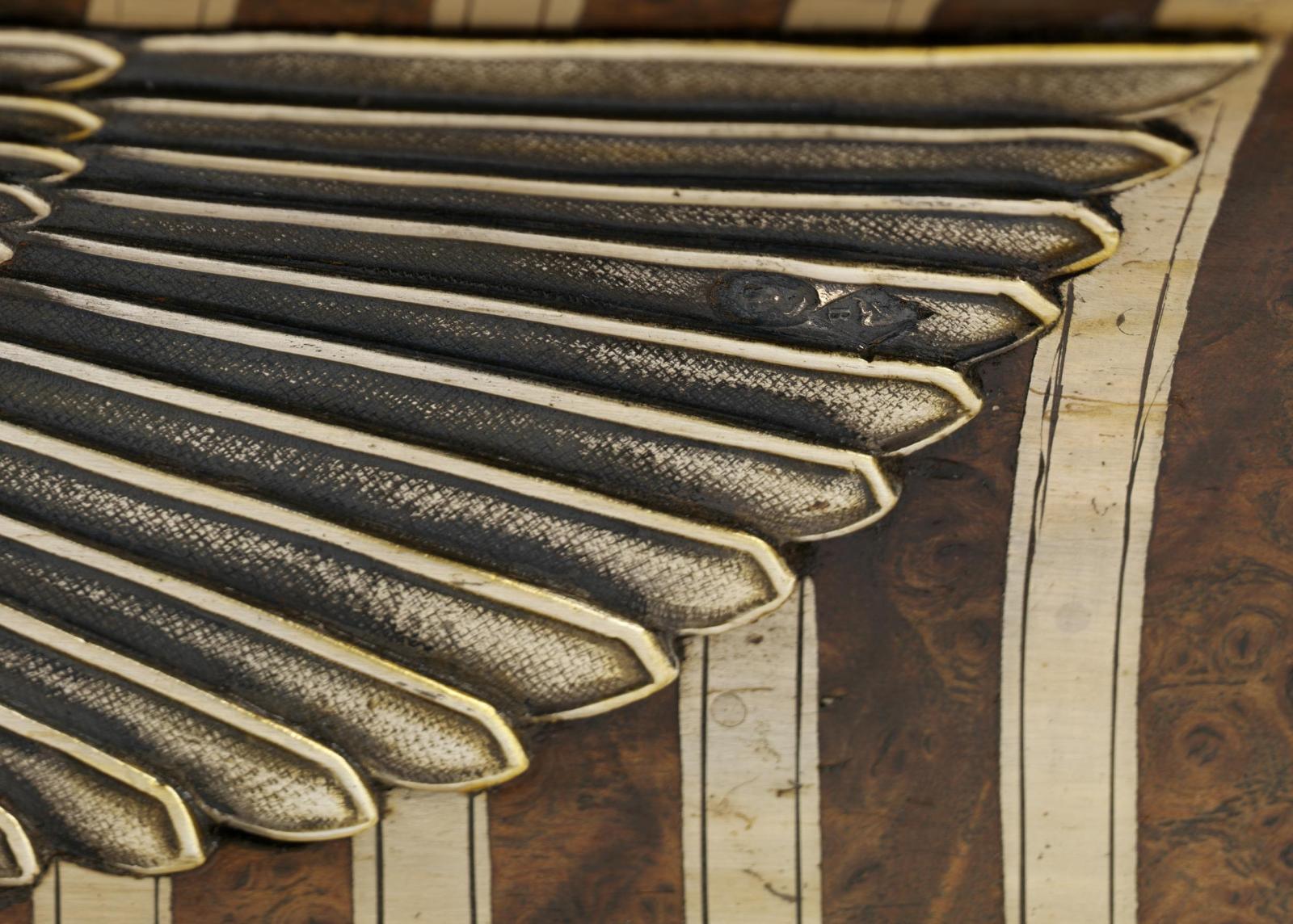
Close-up image of the right side of the cornice on the front of the medal cabinet showing the silver hallmarks on the right wingtip. The most medial oval mark is the Greek woman’s head mark for 1793 (almost certainly with the letter “P”). Apparently this mark, and others dating to the late 19th century, were common marks in the post-revolutionary period and employed in some contexts until at least 1830. The more lateral hallmark is that of Biennais, a “B” in a vertical diamond-shaped lozenge with a monkey above that, with two pellets (dots) to either side of the monkey. I do not see the location of the third hallmark (the standard hallmark for 1809-1819) noted in the museum’s description of this cabinet (unless it is shown in the 13th photo in this post, as a surface anomaly below the sun disk on the most central right-side feather, although that appears more rectangular than octagonal). These wing emblems represented vultures’ wings in Ancient Egyptian iconography. The wings reach out from the solar disk that is flanked by two
Uraei, representing a symbol of royalty and of Ra, one of the sun gods of Egypt, from Heliopolis.
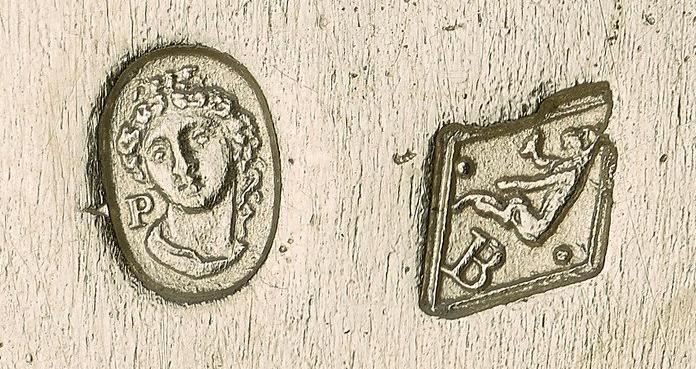
On the right is an example of the Biennais maker’s mark, showing the B surmounted by a monkey and flanked by 2 pellets. The hallmark on the left is the Greek woman’s head with the letter "P" on the left of the bust in an oval, is a mark identified for 1793. Following the revolution, there was a breakdown in systematic guarantee marking of silver and gold. Although this Greek woman’s head mark (and a version with the same bust but with a number 1 to the right of the bust for the period 1794-1797) was instituted in Paris by the Association of Gold and Silversmiths (Association de Orfévres), the use of these punches were only privately done and did not offer any legal guarantee. Both of these hallmarks come from a teapot in the Royal Collection Trust. These hallmarks are from a cropped image of the underside of the lid of a silver, gilt, and ebony teapot made by Biennais c. 1809-1815, that is curated in the Royal Collection Trust, RCIN 48395 (https://www.rct.uk/collection/48395/teapot). These four images are copyrighted (Royal Collection Trust / © Her Majesty Queen Elizabeth II 2021), but can be used for non-commercial purposes.
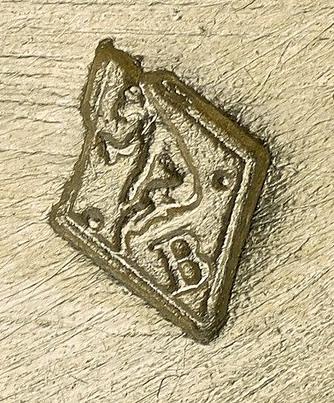
Above is a second example of the Biennais maker’s mark, showing the B surmounted by a monkey and flanked by 2 pellets. This image is cropped from a photo of the underside of the more proximal portion of the hinged lid of the same silver, gilt and ebony teapot made by Biennais and curated in the Royal Collection Trust.
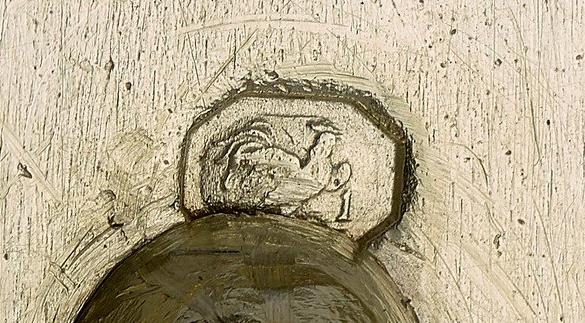
Above is the cock and numeral 1 (1er coq) on the right in an octagon that is the Paris assay office fineness mark for 950 silver. The horizontal octagonal frame probably indicates 1809-1819 hallmark (the standard, or title, mark, poinçon de titre). This photo is from the same teapot in the Royal Collection Trust. This detail of the assay mark is near the same more distal portion of the underside of the hinged lid with the Biennais and Greek woman’s head marks shown in the first hallmark image above (cropped from a larger photo showing all 3 hallmarks). The mass at the lower edge of the photo is part of the rivet holding the exterior ebony knob to the lid of the same teapot that held a tea caddy nested within itself, one of Biennais’ sets of traveling service ware, necessaires de voyages.
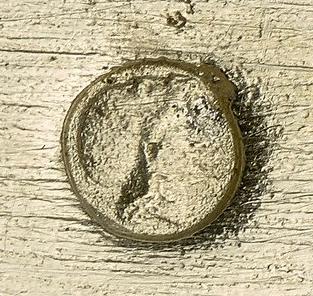
Above is the third hallmark on the same part of the underside of the proximal hinged lid of the same Biennais-made teapot as the second example of the Biennais maker’s mark shown above (cropped from an image showing that Biennais mark, the Greek woman’s head with a "P", and this helmeted head mark). It shows a helmeted head in a circle that is probably the Paris medium object guarantee mark for silver 1809-1819 (poinçon de garantie). This mark is stated to also be present on both the Victoria and Albert and the Metropolitan Museum medal cabinets (however none of the photos show this mark on the V&A example, and only dark circles can be seen on each of the two different winged sundisk elements with paired Uraei illustrated for the Met example; ).
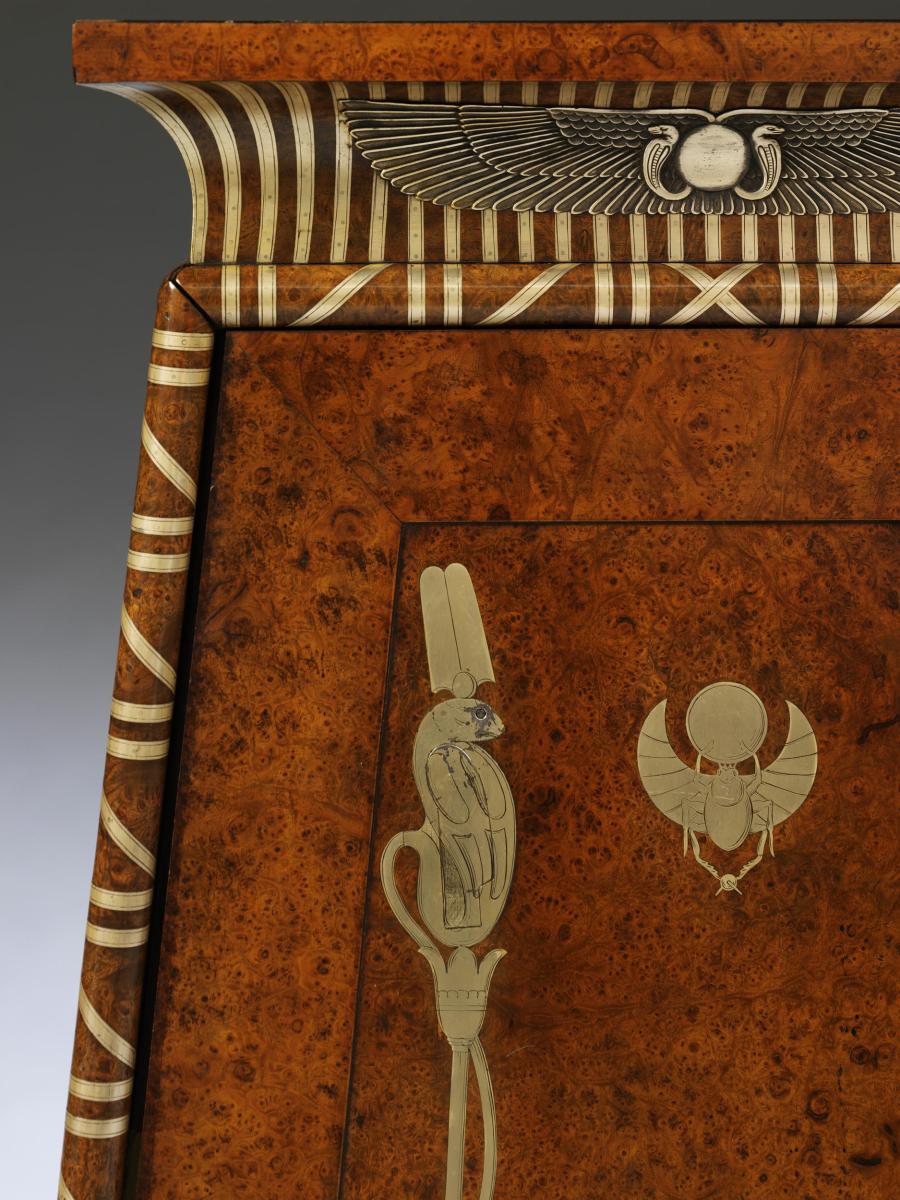
The cabinet opens with a hidden lock that is exposed by inserting a thin rod into the eye of the left-hand Uraeus on the front. This opens the body of the Uraeus exposing the keyhole. This images also shows the most detailed view of the central scarab with the solar disk (Kheper).
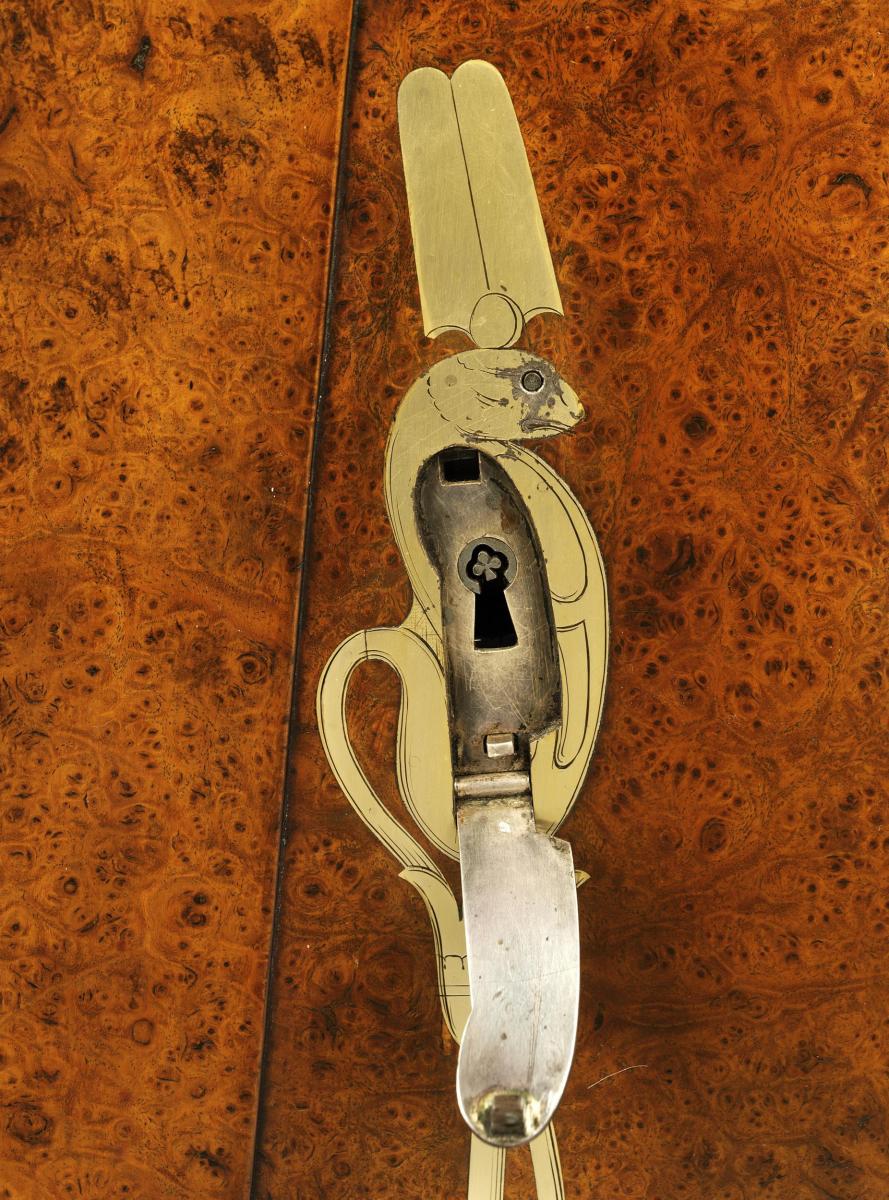
Close up image of the lock mechanism cover latch opened by pressing the mechanism in the eye of the left-hand Uraeus. After being unlocked, the open portion of the cobra’s body serves as the pull to open the front panel.
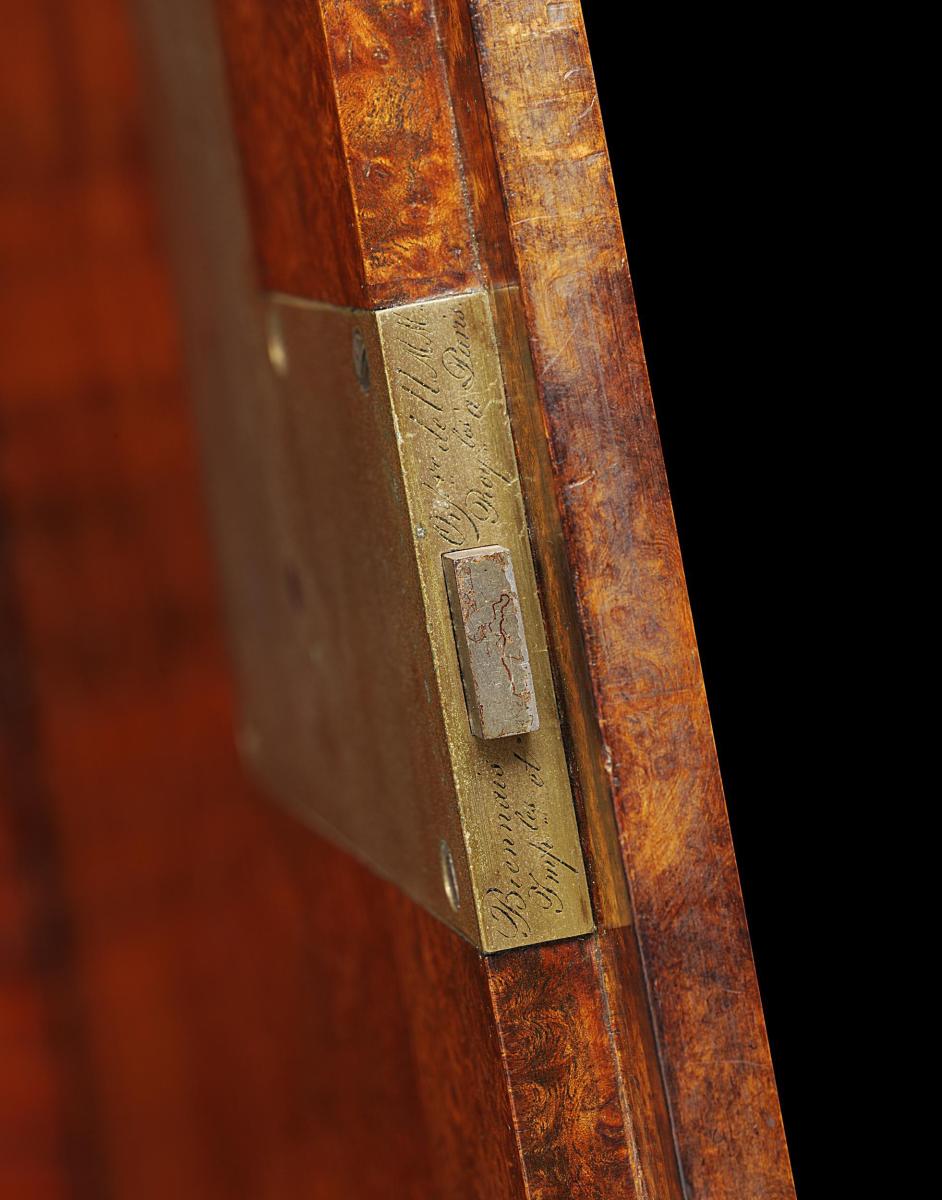
Close-up image of the lockplate with the inscription “Biennais, Orfre de L. L. M. M. Imples et Royles à Paris“.
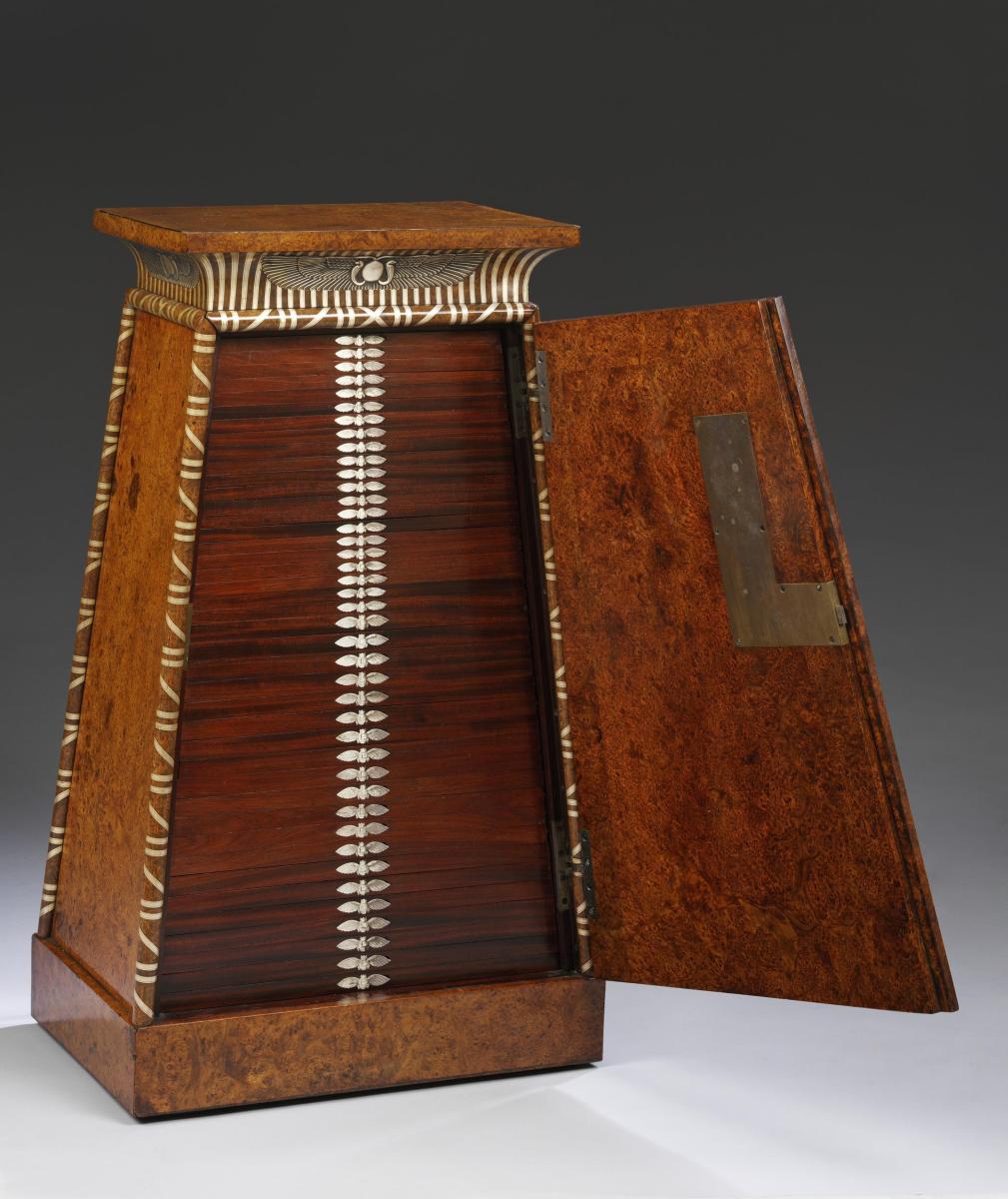
The entire front panel of the cabinet opened to reveal 41 trapezoidally-shaped, dovetailed medal storage drawers made of mahogany. The uppermost 21 drawers are 1.27 cm high and the lower 20 drawers are 1.905 cm high. The center of each drawer has a stylized silver winged insect to serve as a drawer pull. The Victoria and Albert Museum description suggest these may represent scarabs. However, their distinctly differently design compared with the central scarabs (Kheper) on the front and back panels underscores that these were probably intended to represent bees. These were an important symbol chosen by Napoleon possibly because of associations with immortality, resurrection (the latter both somewhat confounded with cicadas, that some scholars believe are represented in the archaeological representations that predate the use of the fleur-de-lys), industriousness, and benevolence, but also explicitly linking him to archaeological symbols associated with Merovingian kings. Napoleon did not specify the reason for his selection of bee imagery. Each bee has a hinged wing on the right side that serves as a drawer pull.

Cropped detail of the 2nd photo below this one showing the form of the winged-insect drawer pulls. As noted, these are not similar to the depiction of the winged scarabs on each of the front and rear faces of the medal cabinet. See the 4th photo above this (first below the hallmark photos, showing the left-hand Uraeus and the central scarab and sun disk) in this post that can be enlarged to illustrate the contrast between these drawer pulls and the form of the scarab with vulture wings on the front and back panels. Although not anatomically accurate depictions of either scarabs or bees, the form of the pulls on the Victoria and Albert Museum cabinet’s drawers are quite different than those on the Metropolitan Museum example. The drawer pulls on the Met’s cabinet are designed to much more closely resemble Ancient Egyptian depictions of scarabs (see the cropped 3rd image in the set of photos below illustrating the Metropolitan Museum medal cabinet). Although images of scarabs in Ancient Egyptian often show them winged, the form of those wings resembles bird (vulture) wings rather than insect wings. It is possible these pulls were intended to look like scarabs. However, the difference from the image of the Kheper scarab on the front of this case and the importance of bee imagery to Napoleon, all suggest it is quite likely that these silver pulls were intended to depict bees. As noted below, the Metropolitan Museum example may have been constructed after this medal cabinet was likely made, possibly in February 1814. At that time, Napoleon had rejected the peace terms offered in the Frankfurt Proposal of November 1813 by the enlarged European coalition following his losses in Russia toward the end of 1812 and at the Battle of Leipzig in October 1813. Whether that may have influenced the re-design of the pulls to more closely resemble Ancient Egyptian scarabs rather than Napoleonic bees, is entirely speculation on my part.
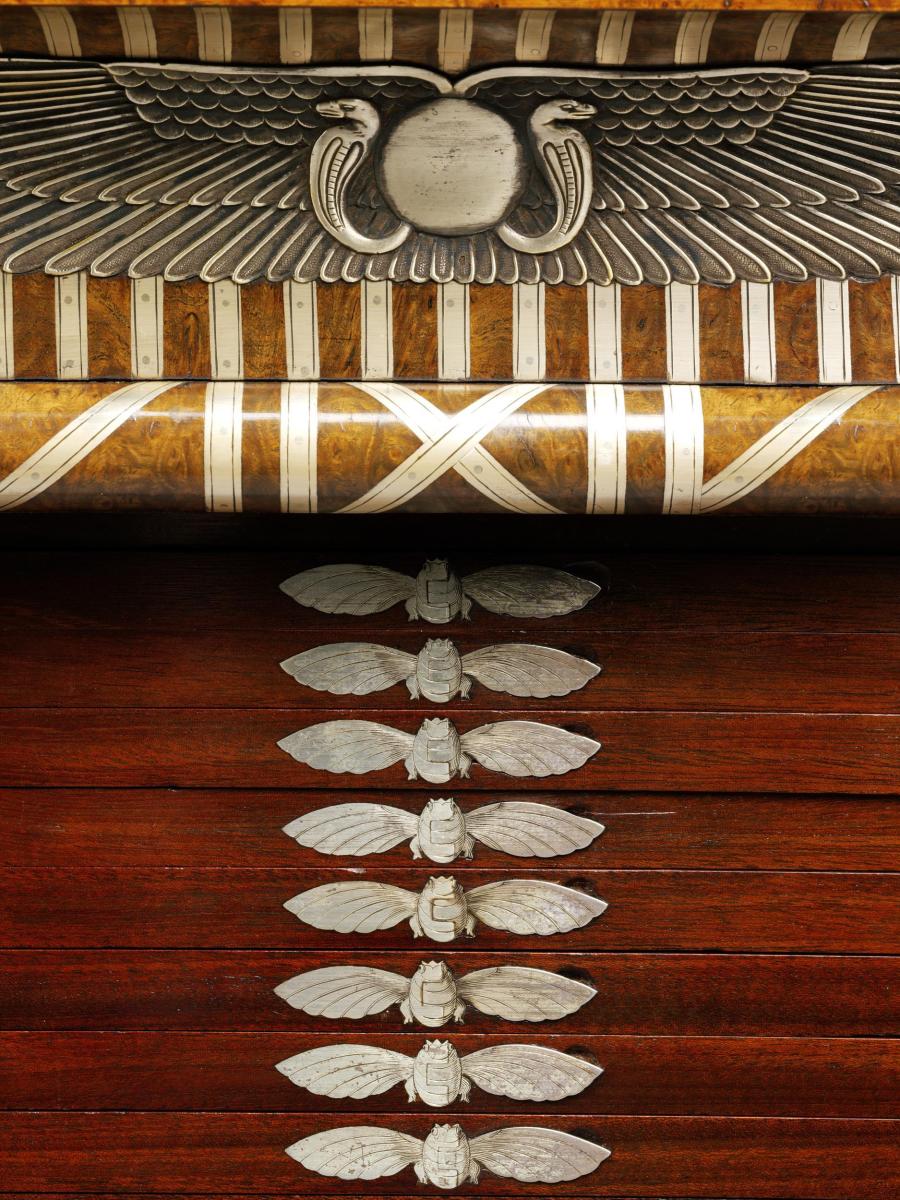
Detail of the front panel opened showing the central portion of the Uraei and sun disk and the bee drawer pulls.
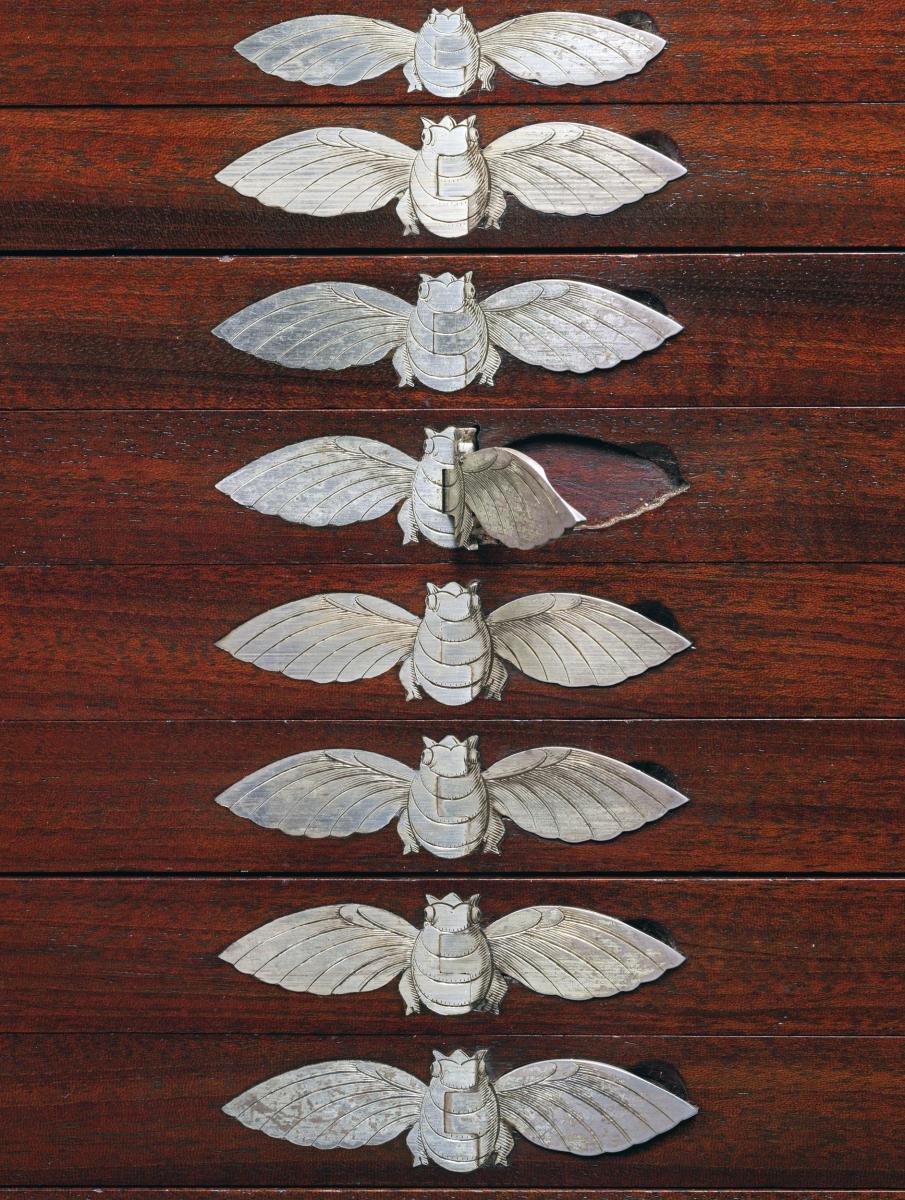
Detail of the drawer pulls showing one of the hinged right wings swiveled open to serve as the drawer pull.
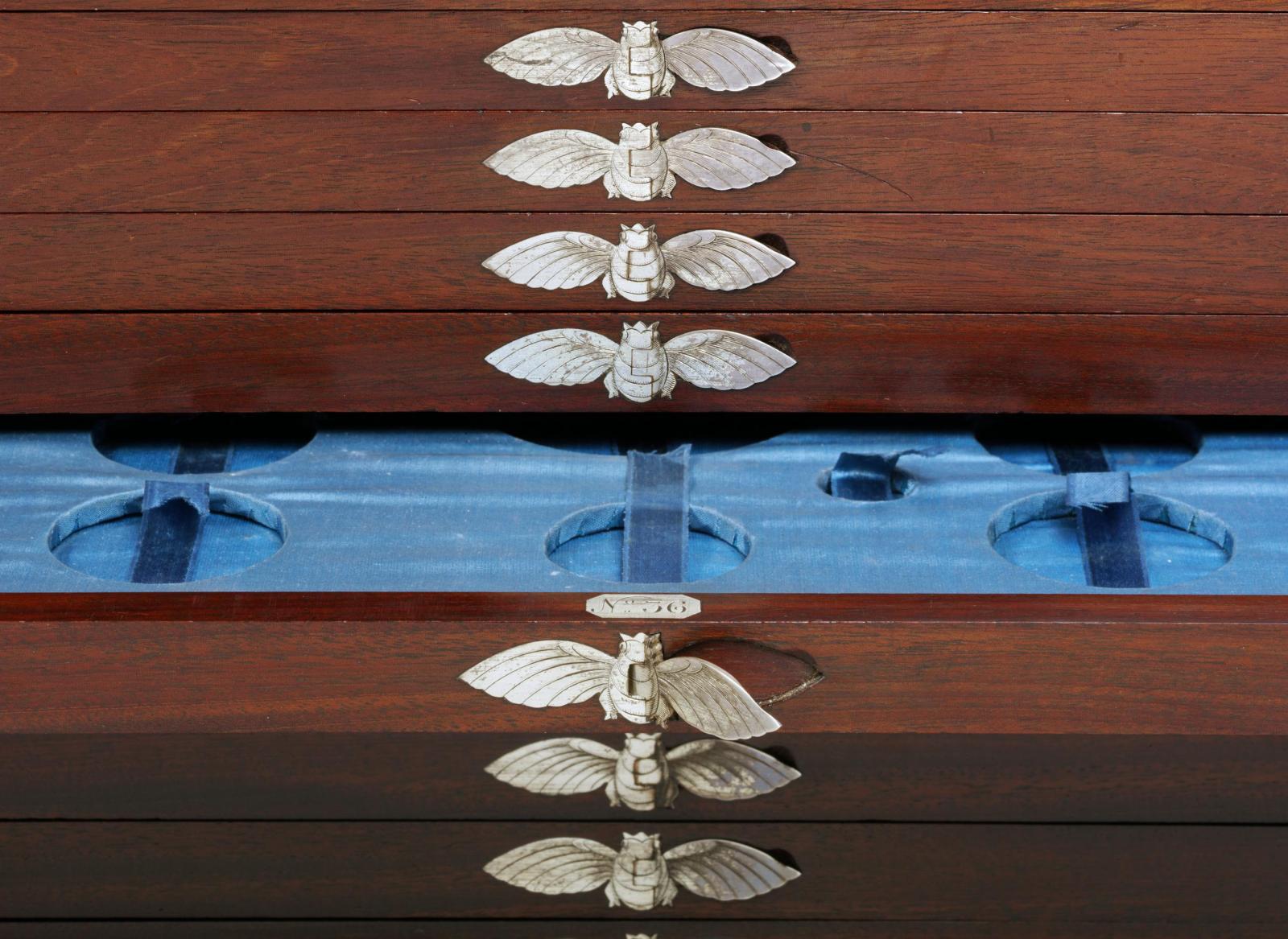
The inside of each draw has a numbered octagonal silver plaque (numbered from top to bottom). This photo shows drawer No. 36 open.
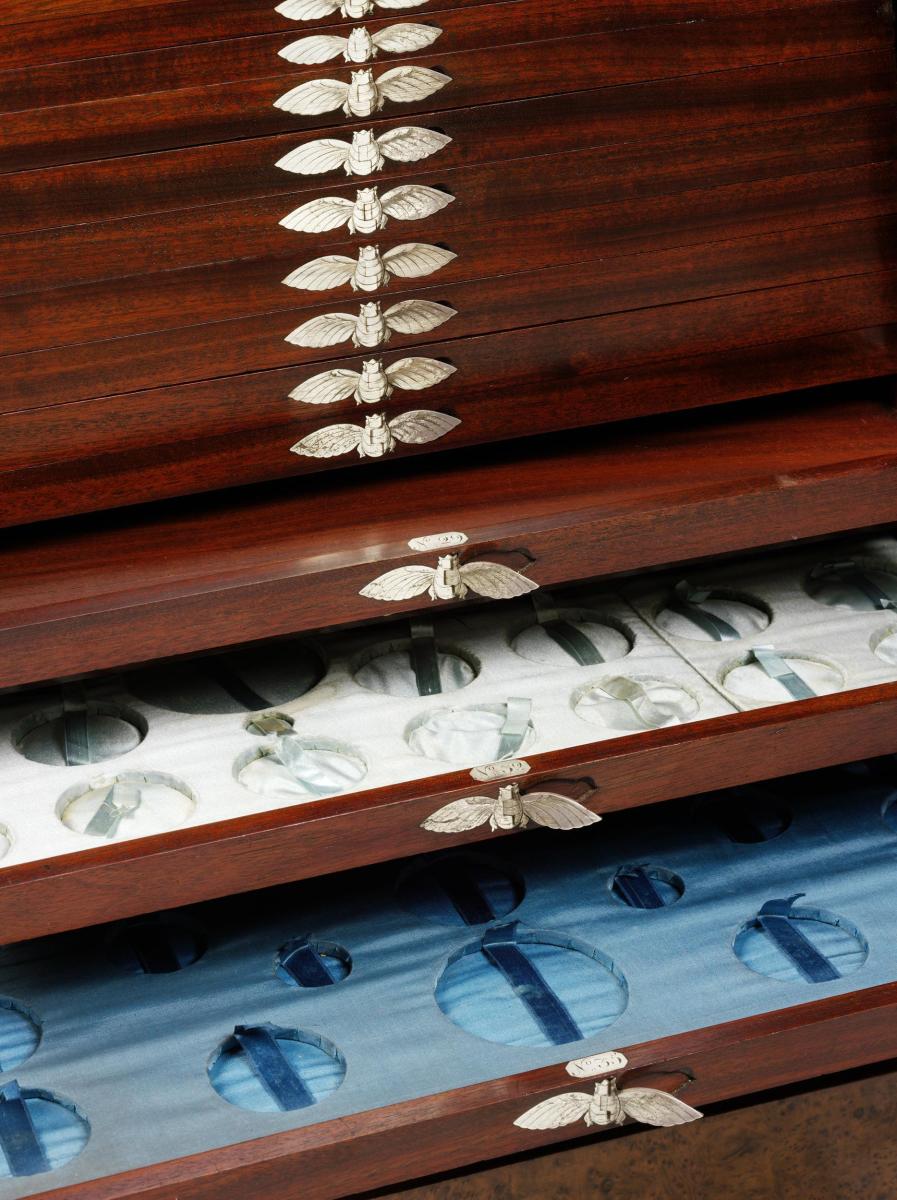
Detailed view of drawers 29, 32, and 35 partially opened.
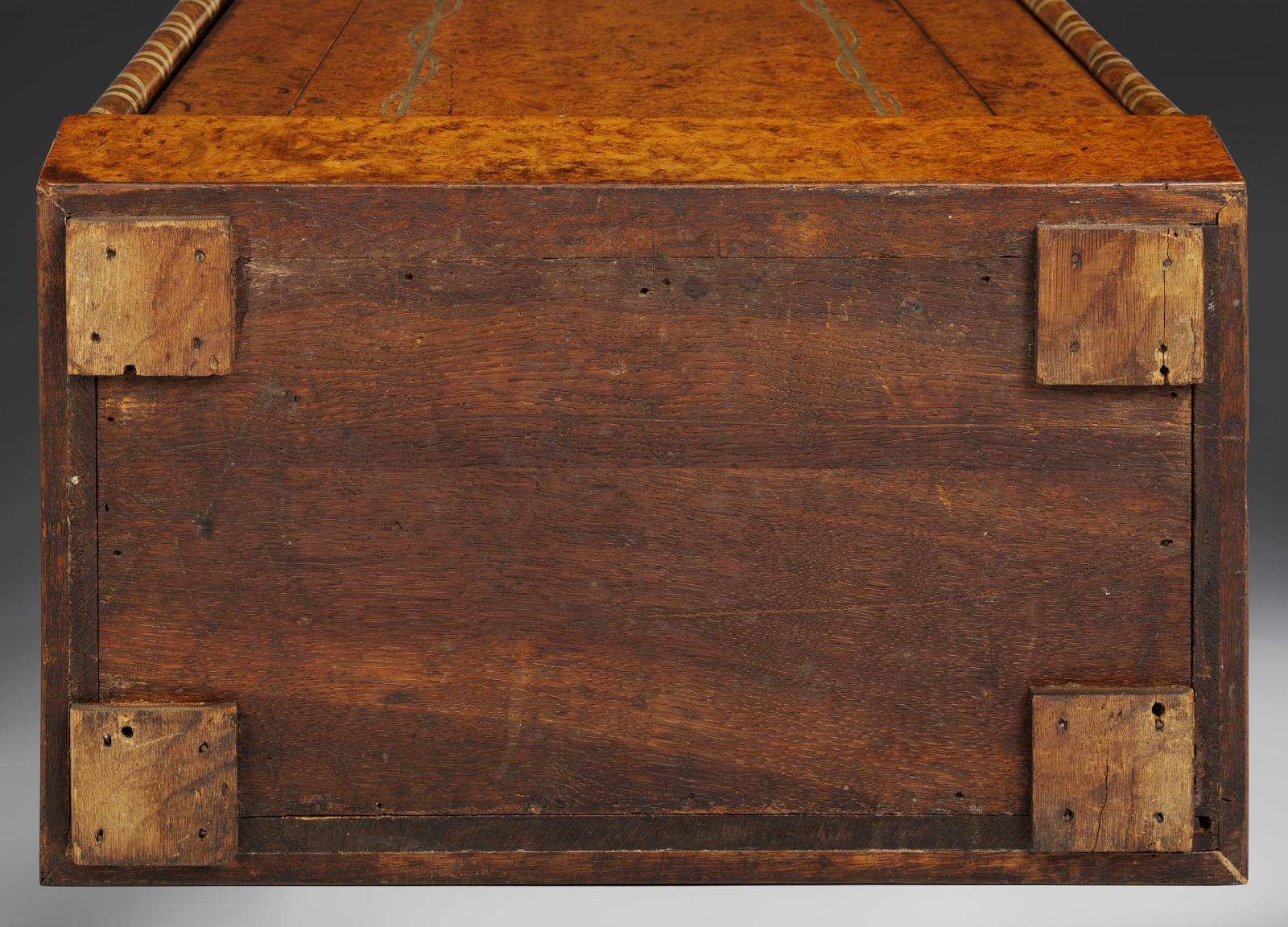
Underside of the medal cabinet showing the plinth that apparently was a later addition to this cabinet (there is no discussion in the V&A text identifying why it is identified as not contemporaneous with the original construction of the cabinet nor how faithfully it may mimic the original plinth, not that the Metropolitan Museum example has a similar plinth). piece.
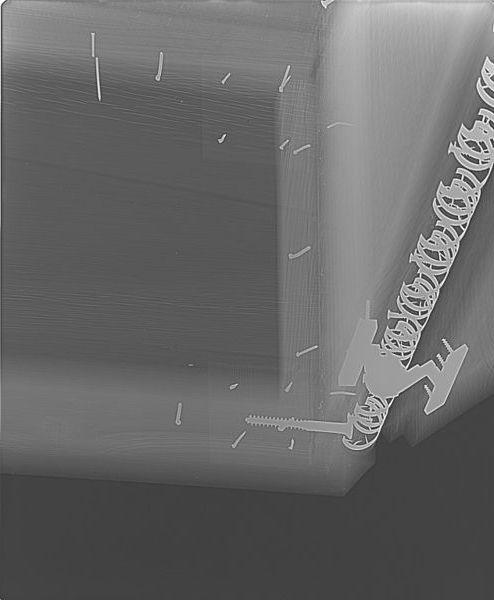
X-ray image of the lower right corner of the front of the medal cabinet (looking downward) showing the lowermost hinge on the front panel door and the silver mounting attached with nails and (modern?) screws to the rounded molding. The majority of the nails visible are those holding the later addition of the plinth. Apparently the drawers were removed to take this series of X-ray images.
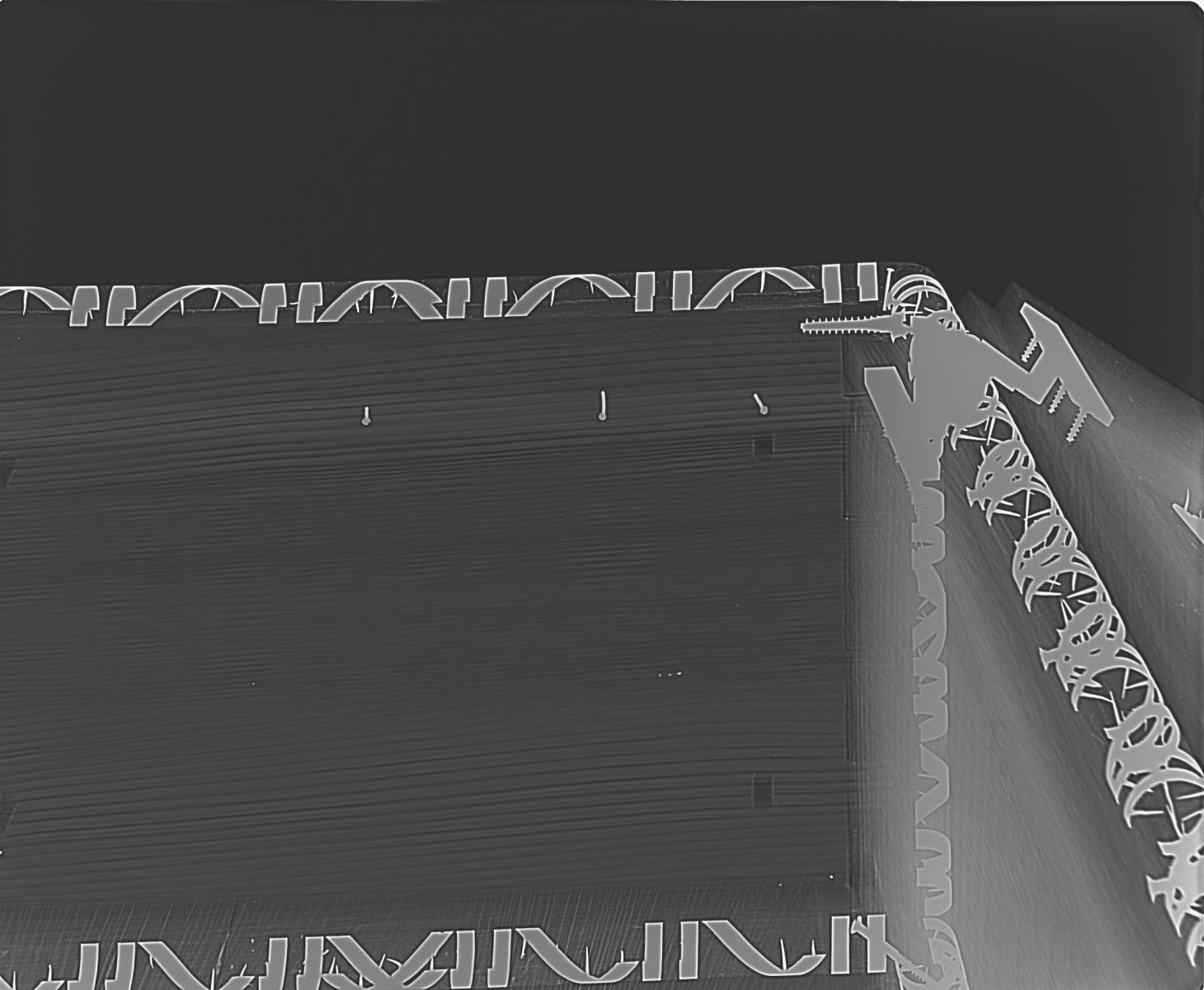
X-ray image of the upper roof of the cabinet interior, looking toward the cornice with the front panel door open on the right.
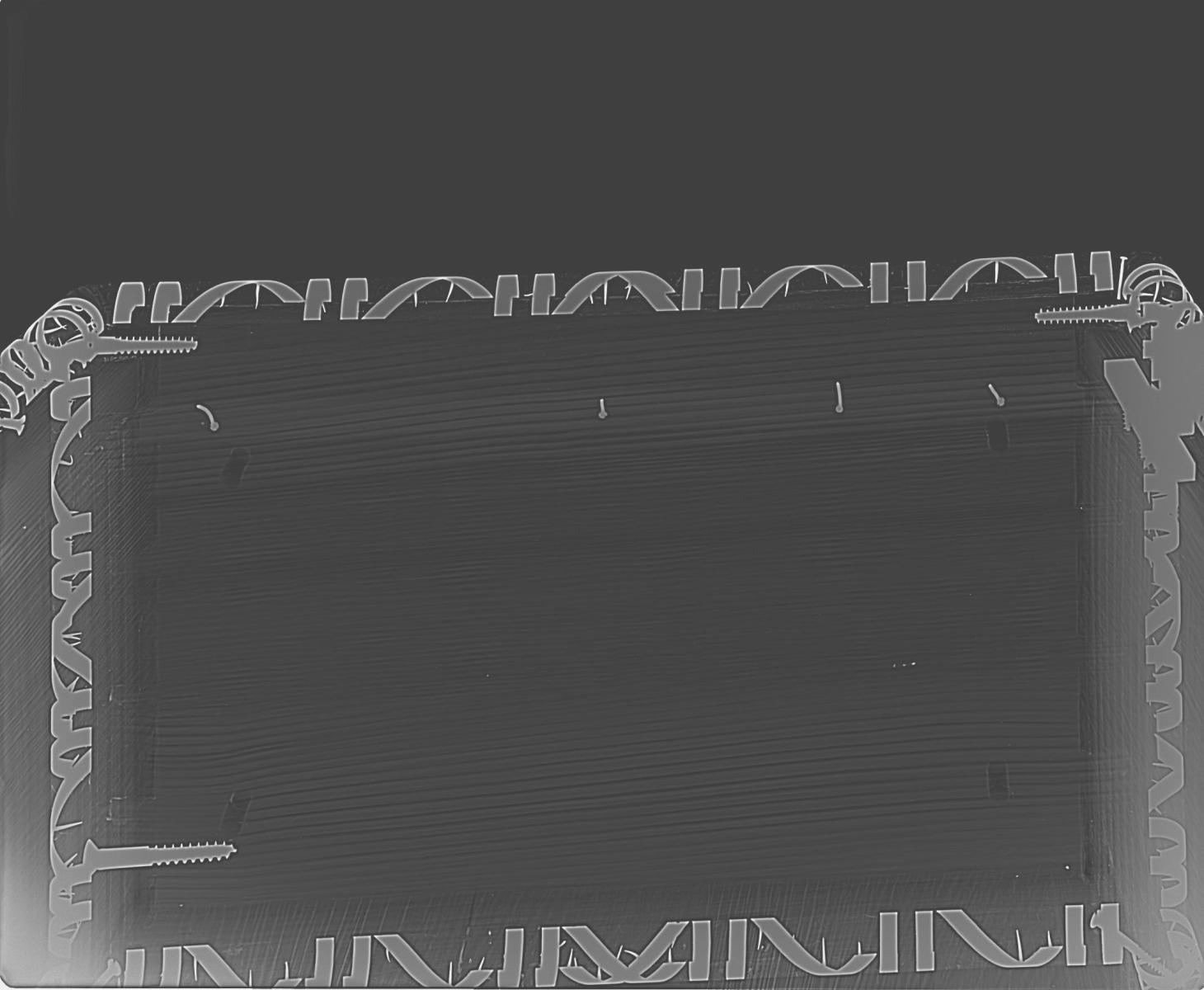
X-ray image from a similar angle (looking upward into the interior roof of the cabinet) to the previous illustration bit with the front panel shut and both sides of the cabinet visible.
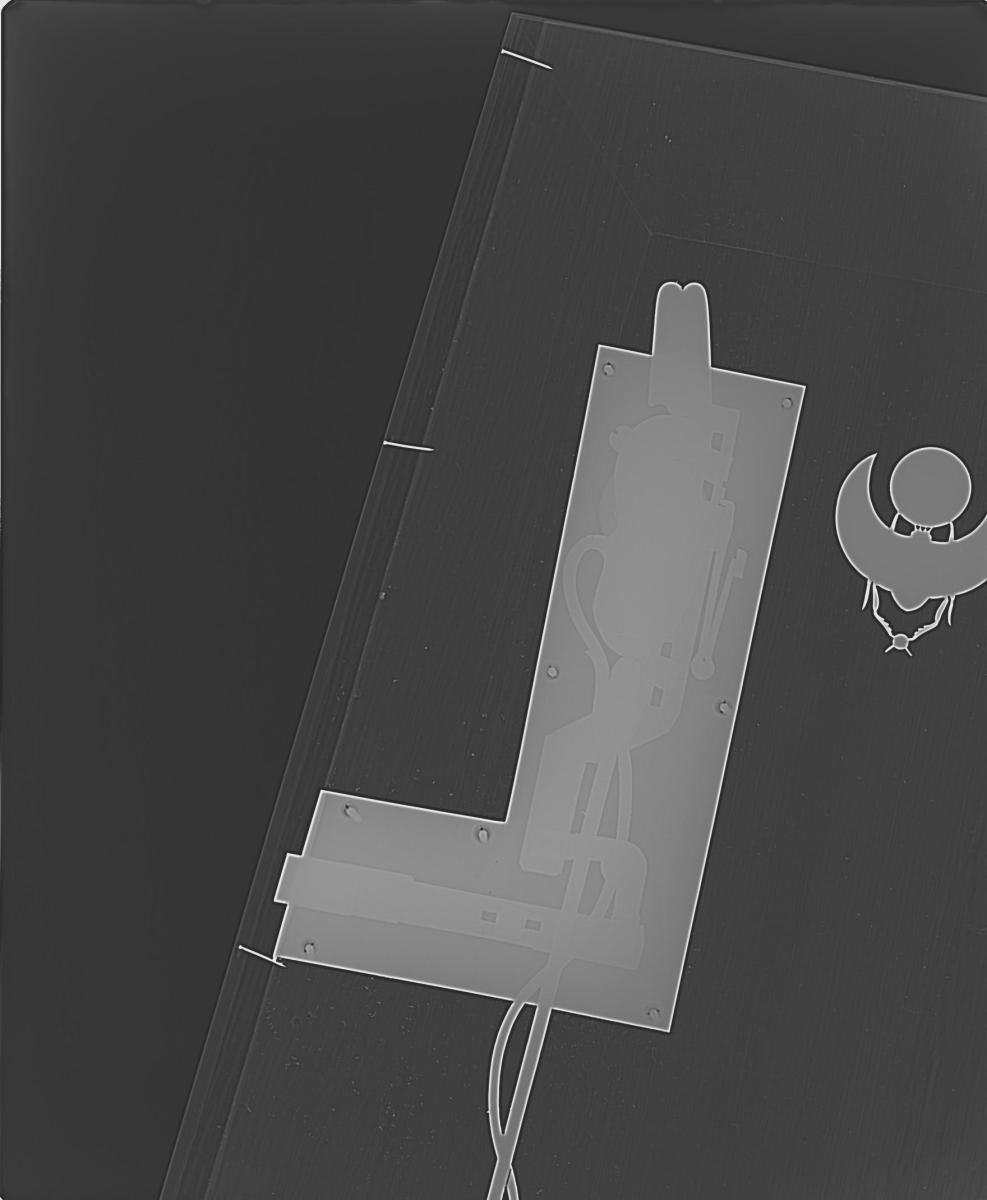
X-ray image looking from the inside of the front panel door at the locking mechanism.
Three references in Journal articles about this medal cabinet are identified in the Victoria and Albert Museum catalogue record. Two are articles about this cabinet in relation to the news of the V&A acquisition: Art Quarterly, Winter 2014, pg. 86; and Meinertas, Leela, 2017. A Napoleonic Medal Cabinet. Luxury Vol 4, (issues 2 and 3), pp. 171-176. The scholarly article is: Griffiths, Antony, Spring 1991. The end of Napoleon’s ‘Histoire Métallique’, Part III. Medal, No. 18: 47-49. Additional references are given in footnotes to the description of the Metropolitan Museum example.
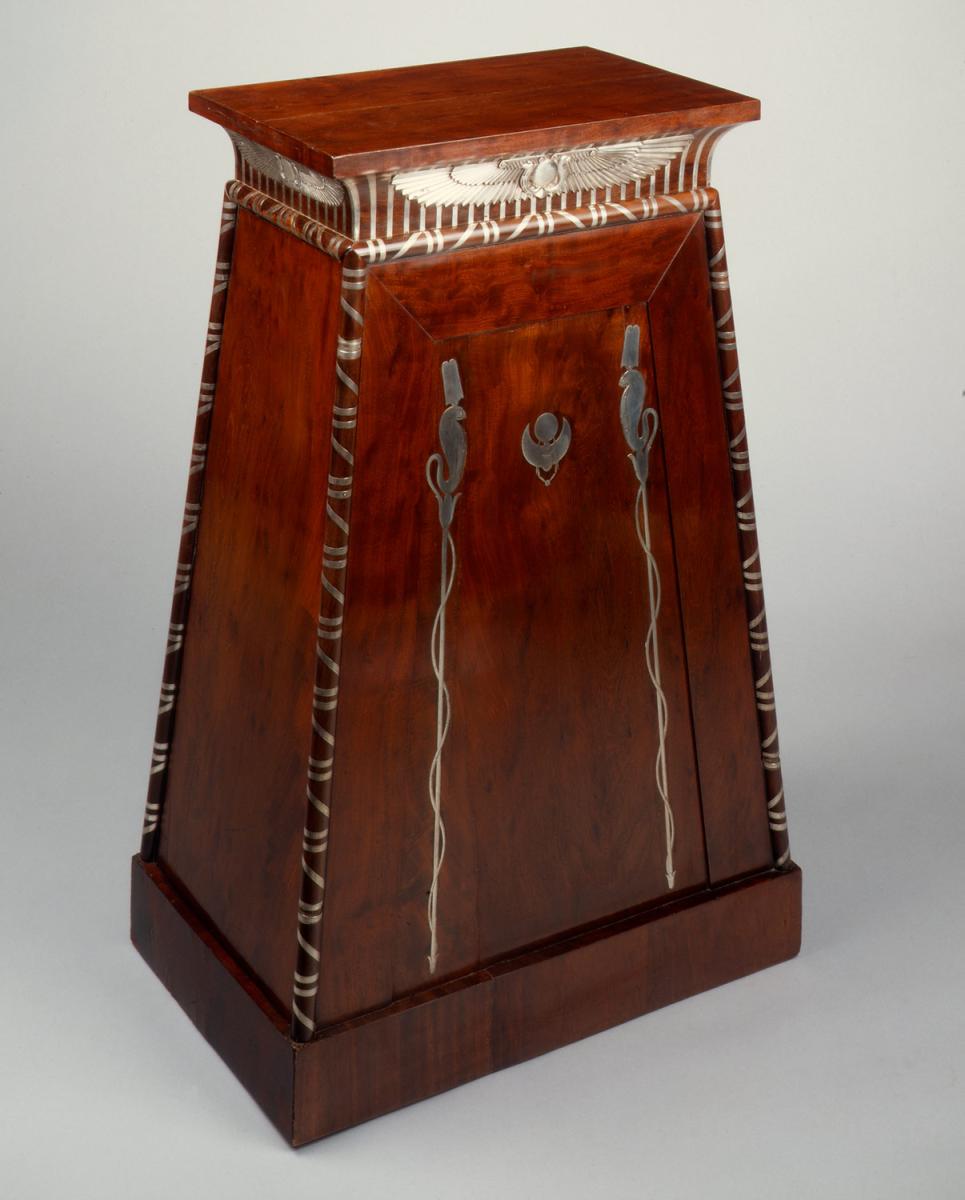
Shown above is a moderately-high resolution photo of the other example of this medal cabinet design that is in the Metropolitan Museum of Art has several design variations from the Victoria and Albert Museum example (https://www.metmuseum.org/art/collection/search/195473). This photo appears to be of the back face, the two Uraei on this side do not have the eyehole releases to expose the keyholes that allow the cabinet to be opened. All of the other photos of this cabinet show the front face of the cabinet. The MMA cabinet may have been made in approximately 1814, although the catalogue listing identifies its dates as c. 1809-1819 (bracketed by the Paris hallmark of 1809-1819 that is described as being present on the cabinet's silver fittings, although none of the photos of this piece show that hallmark). An account notation described by Antony Griffiths (1991, The end of Napoleon’s ‘Histoire Métallique’, Part III. Medal, No. 18: 47-49): "The most interesting record, however, is an account submitted in February 1814 by [the goldsmith] Biennais for 3,600 francs, for what is described as the 'médailler du Roi.'" In Biennaises account, Griffiths continues, this medal cabinet for the king is described as "in the form of an Egyptian pedestal, containing 44 mahogany drawers with silver mounts, and meant to serve as a stand for the emperor's old medal cabinet." The configuration of 44 drawers refers to the design of this example (if not to this specific medal cabinet), and not to the Victoria and Albert cabinet (or its general design) that has a total of 41 drawers. Griffiths feel that this bill from 1814 for 3,600 francs refers to the Metropolitan Museum example. Although the catalogue heading for this item calls it a “coin cabinet”, all of the descriptive material discusses it as a medal cabinet. The photos of the Metropolitan Museum medal cabinet included here, and data about it, are uncopyrighted and within the public domain. All but this first photo that I have been able to download for this post are very high-resolution and provide excellent detail when enlarged. The above images is a moderately-high resolution that still provides good details when zoomed.
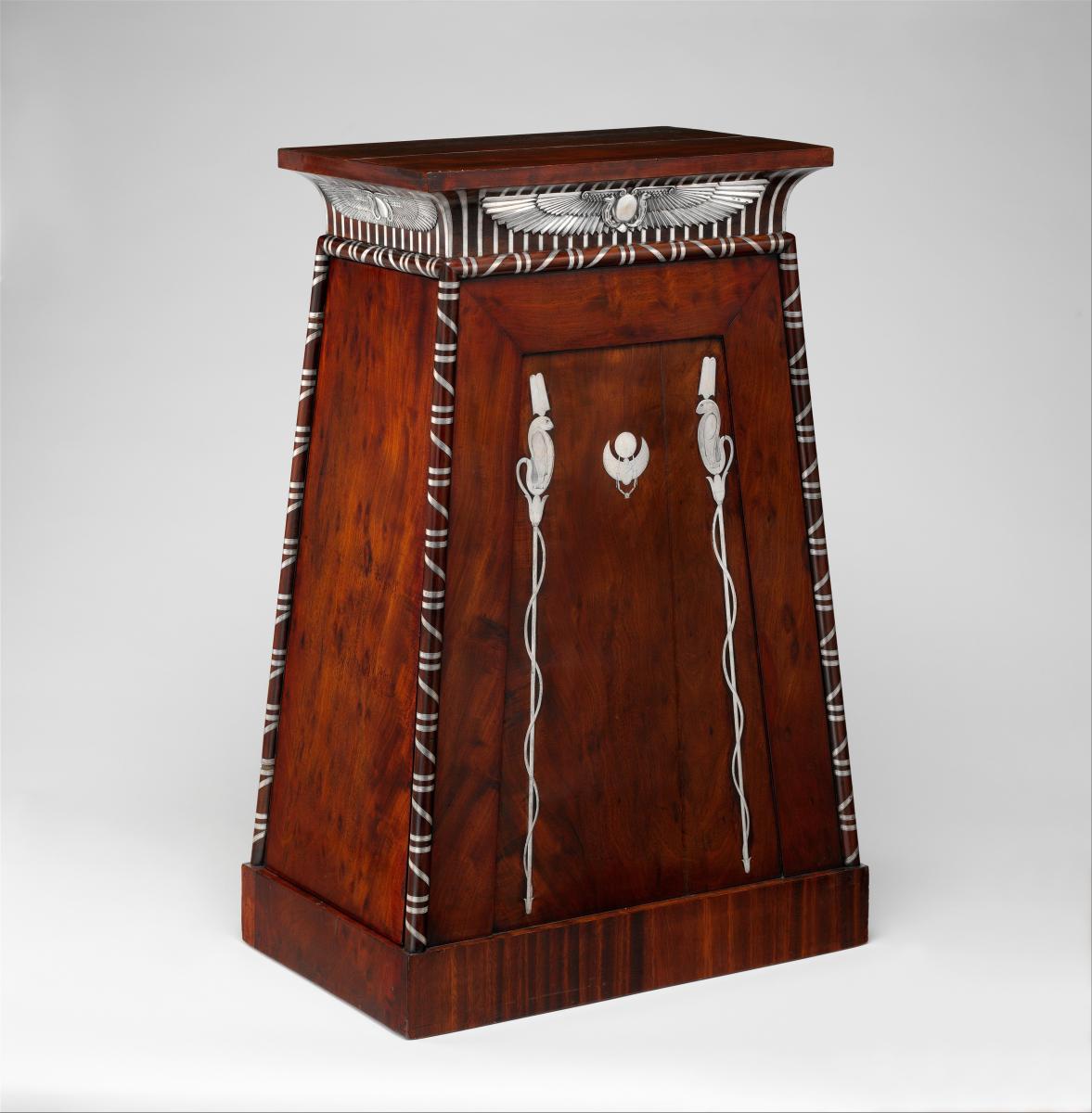
Above is a high-resolution image of the front face of the Metropolitan Museum example of this Napoleonic medal cabinet. It shows the open eyeholes of each of the flanking Uraei and a different patter of dark coloration areas of the mahogany veneer. The wood under the silver bands of the lower portion of the cornice (the left door) do not show the discoloration seen on this architectural element in the first photo of the Met's medal cabinet shown above.
The Metropolitan Museum information about the medal cabinet identifies the designer as Charles Percier. It also credits Baron Dominique Vivant Denon as the “decorator”, noting that the cabinet was based on an architectural drawings by Denon of the Pylon at Apollonopolis Parva in Upper Egypt. The catalogue information does state that the cabinet maker for this piece was the Parisian firm of François-Honoré-George Jacob Desmalter (1770-1841). The Victoria and Albert Museum’s suggests that Desmalter & Cie. was not the manufacturer of their example, identifying Martin-Guillaume Biennais as not only the maker of the applied and inlaid silver fittings but also a master tabletier who was a cabinet maker in addition to manufacturing other luxury goods. The Metropolitan only credits Biennais as the maker of the silver mounts. It does identify the period of his active career as c. 1796-1819. Unlike the burl of the Victoria and Albert examples, the Metropolitan Museum piece is made of mahogany (probably Swietenia mahagoni). The silver is identified in the item description as having a purity of “950/1000” (the cock with number 1 Paris assay mark indicates 950 silver), and is noted as distinctive compared with the more common decoration of many contemporary luxury pieces using gilded bronze. The dimensions are 35 ½ in high x 19 ¾ in wide x 14 ¾ in deep (90.2 cm x 50.2 cm x 37.5 cm). The piece was given to the museum in 1900, and its museum’s accession number is: 26.178.77. This version of the cabinet is identified as having originally been owned by Baron Dominique-Vivant Denon, who was at the time Napoleon’s Director General of Museums. There is some question whether it may have originally been designed for Napoleon (as the Biennais quote translated above from Griffiths 1991 article suggests). Both the Metropolitan Museum and the Victoria and Albert Museum note that Denon, Like Napoleon, was an enthusiastic medal collector. The Metropolitan descriptive text also notes that Denon’s estate listed over 3,000 contemporary medals at a posthumous sale (implying he may also have had an unspecified number of more ancient Classical medals). Following his role as a draftsman during Napoleon’s Egyptian campaign (1798-1999) and the 1802 publication of his popular book Voyage dans la Basse et la Haute Égypte, Denon was appointed by Napoleon to oversee the Monnaie des Médailles (Medals Mint), and as Director of the Musée Napoléon (later the Musée du Louvre). Denon also designed the ceremonial chain and badge of the Legion d’Honneur, that was manufactured by the Biennais atelier.
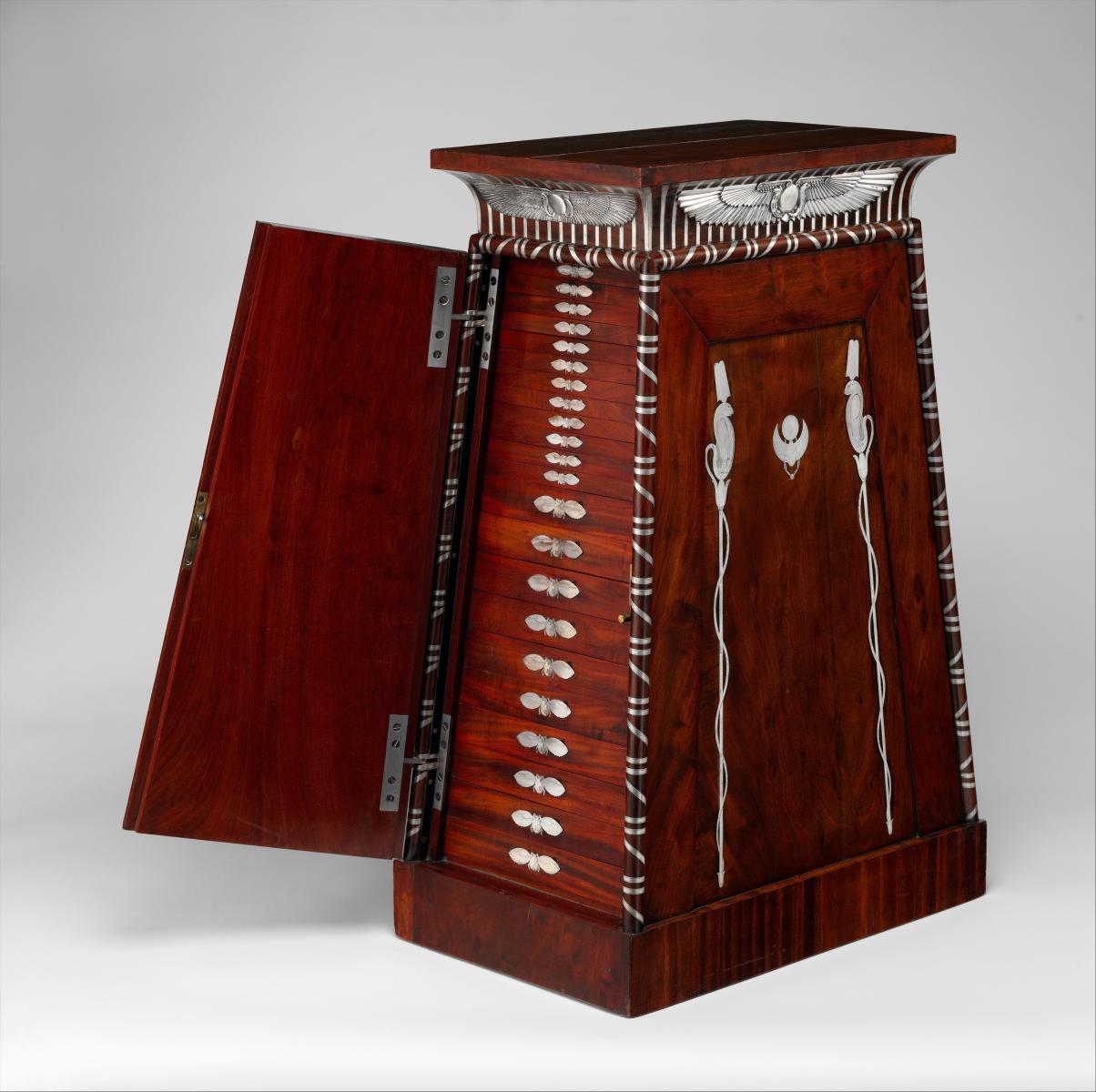
High-resolution photo of the front of the Metropolitan Museum medal cabinet. The opening and drawer configuration of this cabinet are both different compared with the Victoria and Albert example. The same decorations of the front and back panels that employed the central scarab with the solar disk and the two Uraei wrapped around lotus stalks ornament the Metropolitan Museum medal cabinet. However, unlike the Victoria and Albert example, both Uraei on one face only each hold hidden keyholes in the cobras’ eyes that open doors on each side of the cabinet, not the single panel on which the Kheper and Uraei elements are present (as on the V&A cabinet). The Metropolitan Museum description of the cabinet states that a silver stick is provided, along with the keys to the cabinet, to insert into the eyes and open the cobra body over the keyhole. Both sides of the cabinet open, each side exposing 22 graduated drawers. Each side has 12 shallow drawers and 10 deeper drawers (no depth dimensions given).The Metropolitan Museum description also suggests that the silver pulls on each drawer are depictions of a “scarablike insect”. In this case, the form of the pulls is quite different than those on the Victoria and Albert Museum example that look less scaraboid. As shown in photographs on the V&A Museum example, each drawer is numbered with an octagonal silver plate at the front interior edge of each drawer.
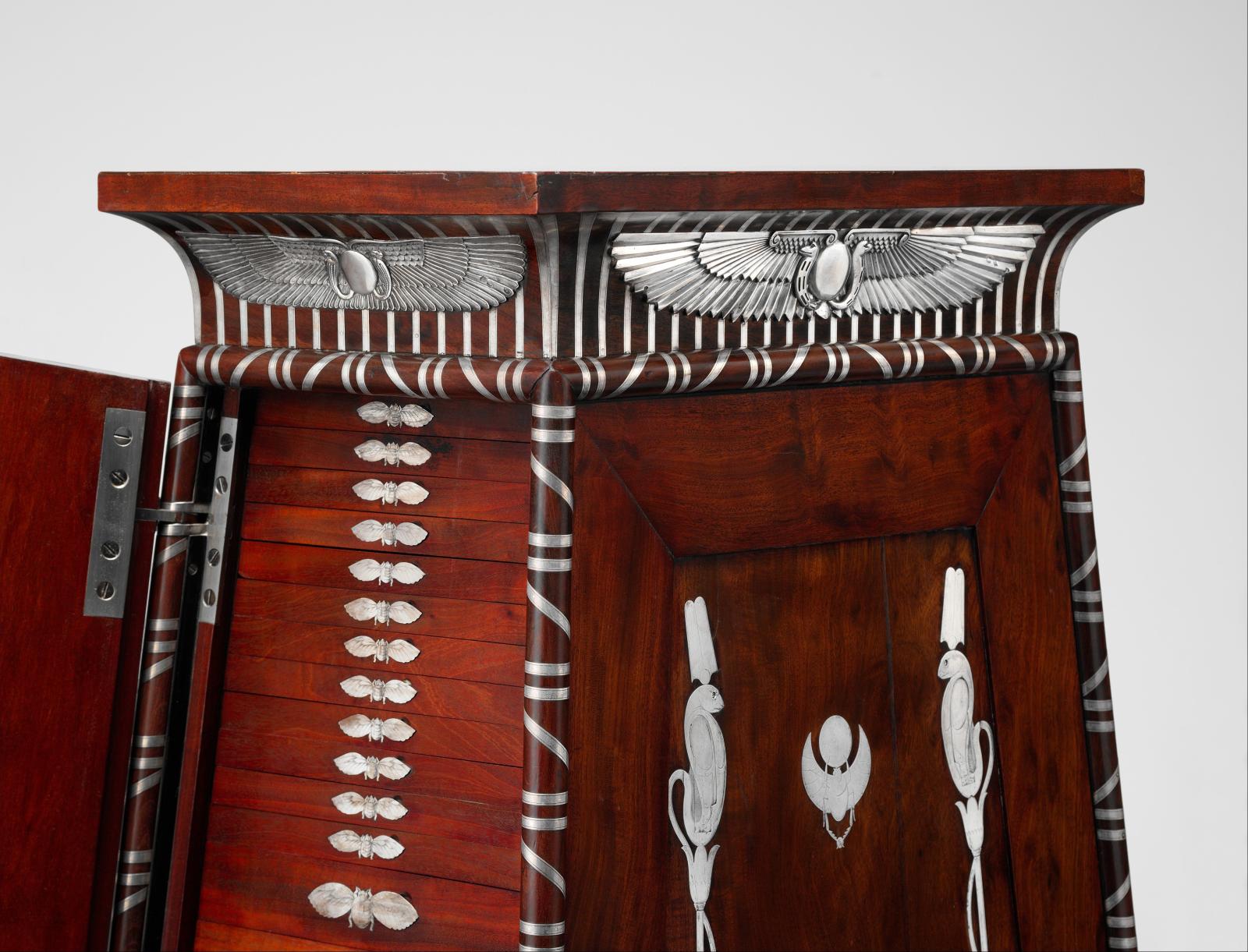
High-resolution image detailing of the face of the medal cabinet with the two keyed-Uraei and the cornice. This image shows that both Uraei have the eyesocket release to open the keyhole cover that is a portion of each cobra’s body and hood.

High-resolution detail of the left side Uraeus wearing the solar disk with two ostrich feather plumes (the Amun headdress) showing the eye hollow for springing open the cover of the keyhole and the outline of opening door on the body and hood of the cobra.
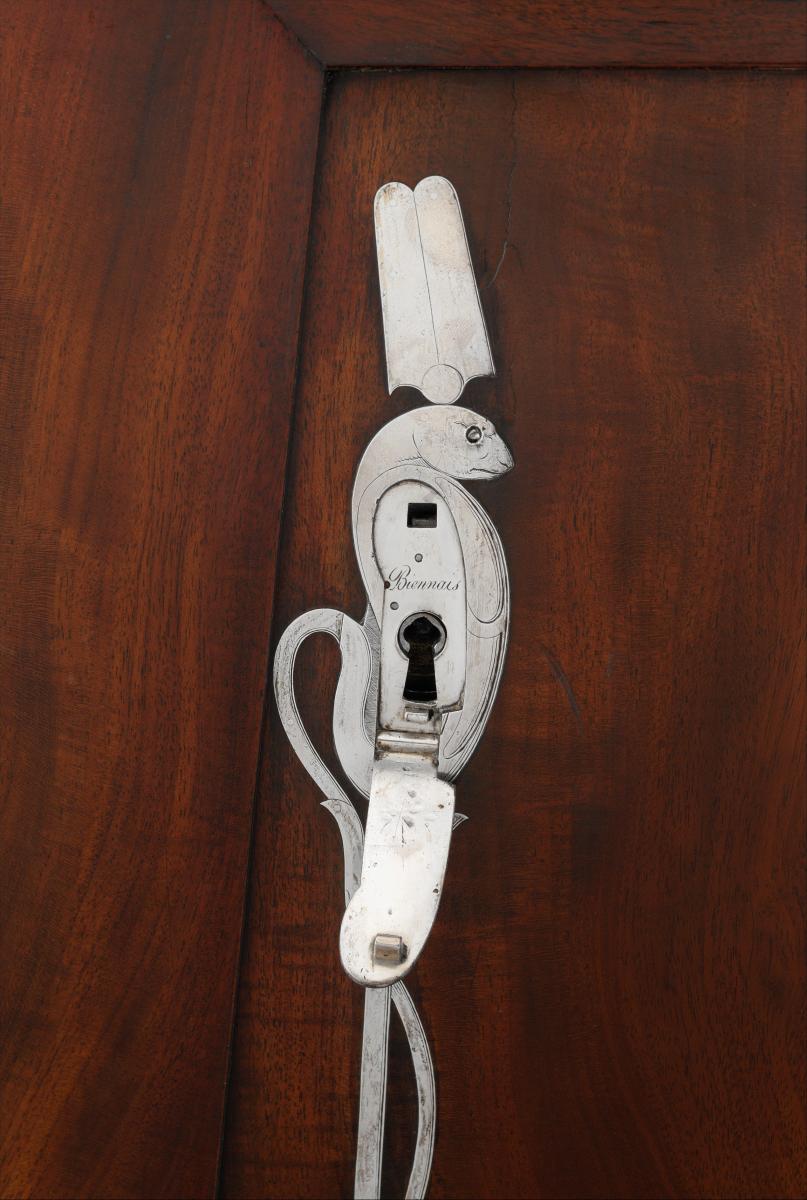
High-resolution photo showing the Biennais signature that is engraved above the keyholes (inside the Uraei bodies), rather than on the single lockplate as on the Victoria and Albert example (the 10th image in this post). The catalogue description does state that it reads “Biennais” in script above each keyhole and provides this high-resolution image of that signature and the left-side keyhole. Unlike the Lockplate on the V&A medal cabinet, there is no inscription "Biennais, goldsmith to their Imperial and Royal Majesties in Paris". Would there be any relationship between this abbreviated signature, excluding the Emperor, and my suggested alteration of the Napoleonic bee form of the drawer pulls (as seen on the V&A medal cabinet) to the more Egyptian-looking scarab pulls on this cabinet?

Very high-resolution cropped portion of the 5th image below this, showing the much more scarab-form of the drawer pulls. The design of the two forelegs, the two back legs, and the mouth parts of these are quite differently formed compared to the pulls on the Victoria and Albert example. (see the 12th photo in this post, shown above). They are a reasonably accurate interpretation of Ancient Egyptian scarabs in relation to those leg and mouth characteristics. As I noted in the discussion of the much less scarab-like form of the drawer pulls on the V&A Museum example, these pulls have been significant re-designed for this example of the medal cabinet. I wonder if Napoleon’s waning influence (if this Metropolitan Museum medal cabinet was indeed made in February 1814 as the identified invoice would suggest) is partly responsible for altering the Napoleonic bee motif to a more Egyptian ornamentation for this example of the Charles Percier design of the medal cabinet. As noted above, compared with the V&A cabinet (at least one probably personally commissioned by Napoleon) the Biennais signature is starkly unassociated with royalty. Additionally, for this cabinet Biennais made the only significant change in the actual forms of silver inlay elements to alter the ambiguous scarab/bee/cicada design of the drawer pulls. Detailed and stylized aspects of the Egyptian scarabs have been incorporated into the new form of these pulls. The other changes between the V&A are mostly just re-orientation of the sun disks cornice elements, different lock mechanisms, and the cabinet structural openings of the MMA cabinet. I looked through both a set of scrapbook images of sketches and designs by Percier in the collections of the Metropolitan Museum shown on their website and other sketches and designs by Percier on the Musée des Arts Décoratifs website to see if any drawings of the drawer pulls might exist that could clarify whether the initial design suggests scarabs or bees as the insect Percier intended these pulls to represent. None of those online collection images show any drawings of the original design of the drawer pulls, nor any images of scarabs or bees as decorative elements that I could use for comparison.
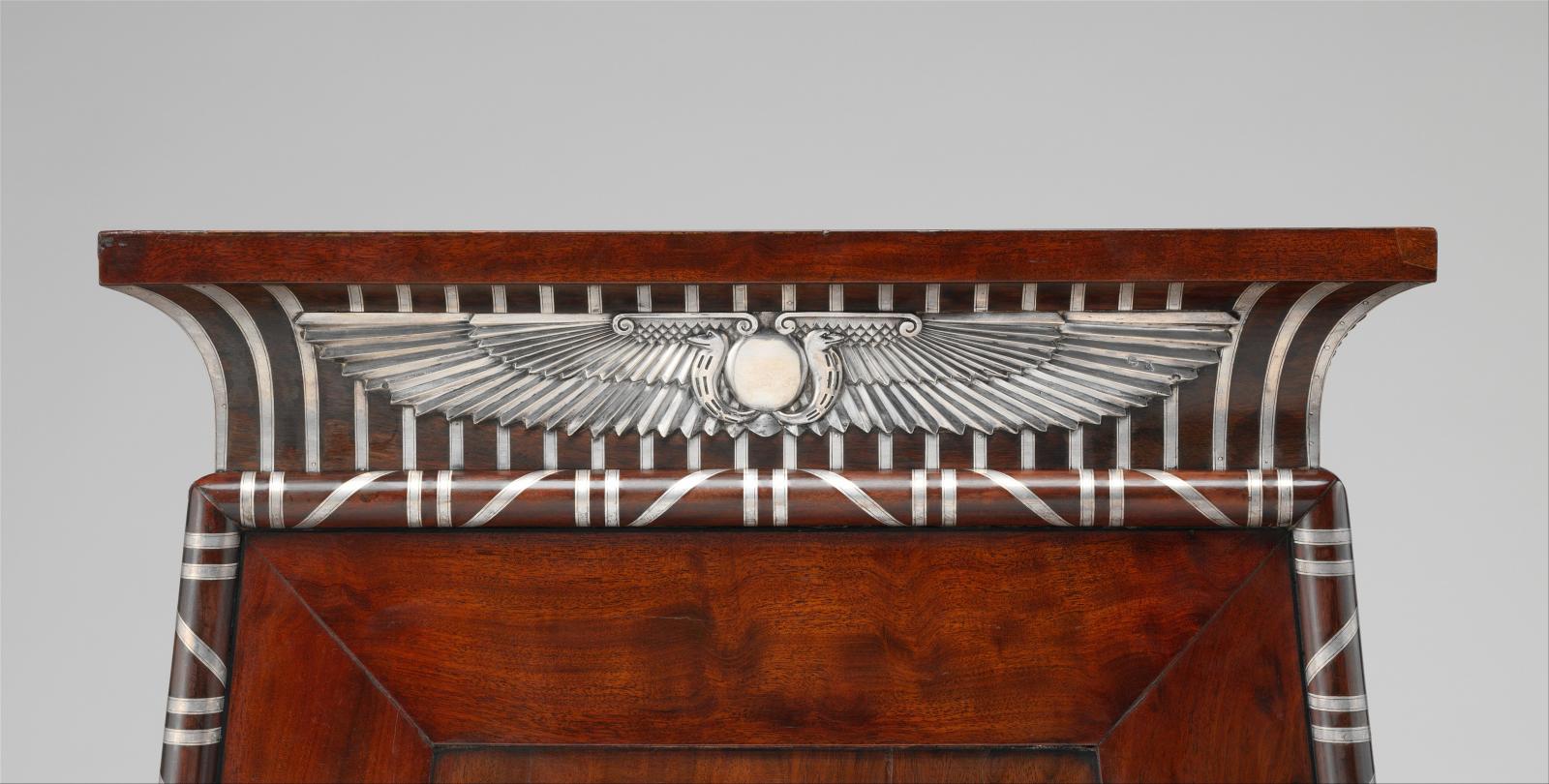
High-resolution photo detailing the form of the silver solar disk with Uraei and vulture’s wings on the front of the cabinet (the darker portions of the mahogany veneer match those seen on the front in the previous 2 photos, not the illustration of the back shown as the first photo of the Metropolitan Museum cabinet). This is the same face that has the two keyed-Uraei for opening the case. The form of the cobras bracketing the solar disk and the wings are not the same design as seen on the front of the Victoria and Albert example. This may be the design employed on the side of the V&A example that opens to reveal the 41 drawers, however, those photos do not illustrate details of the winged solar disk on that side of the V&A cabinet. When this image is enlarged, three hallmarks are visible at the far right of the right-hand vulture wing. The oval-shaped Greek head guarantee mark is the most medial, and the diamond-shaped maker’s mark of Biennais is the more lateral mark (both shown above as the 4th image in this post). Just distal of these two marks, and on the lower margin of the same feather, is an octagonal hallmark that must be the the standard, or title, mark, poinçon de titre, for 1809-1819 (shown in the 6th photo in this post). This photo is not as high resolution as that showing the hallmarks on the V&A cabinet, and cannot be compared with the form of those marks shown in the 3rd photo of this post (that can be zoomed for some details of those marks). On the left-hand wing, there is a dark circle in a similar location to the two hallmarks on the right wing. Although the details of the hallmark cannot be distinguished in this image, this is almost certainly the helmeted head in a circle that is probably the Paris medium object guarantee mark for silver 1809-1819 (poinçon de garantie), shown in a poor resolution image of the in the 7th photo in this post..

High-resolution image showing details of the winged solar disk on one of the sides that open to reveal the drawers of the cabinet. This is an image of the door on the left side of the cabinet (oriented to the front panel with the two keyed Uraei). The first image in this set illustrating the back panel Metropolitan Museum cabinet shows some discoloration of the wood around the silver bands of the rounded lower molding of the cornice that is not seen on this photo. The lack of this discoloration, and a slight flaw or nick in the wood of the rounded cornice molding just to the right of the two central vertical silver bands of the decoration match what is visible of the left side of the opened cabinet, especially in the in the detailed 3rd photo of this set of images of the Met example showing the two Uraei on the face and the opened panel door on the left. The form of the solar disk on this side face of the cornice is the same as that on the front face (the side with the Uraei and the Kheper scarab with the solar disk) of the Victoria and Albert Museum example (visible in all the high-resolution images of the front of the V&A cabinet, especially the detailed images that are the 4th and 8th photos in this post). The same three hallmarks can be seen at the far right of the right-hand vulture’s wing as described in the previous photogrpaph. The diamond-shaped maker’s mark of Biennais is the most medial and the oval Greek woman’s head (almost certainly with the letter "P") is the more lateral mark. More distal to those 2 marks, on the same feather element, is an octagonal mark, that barely shows the form of the cock (1er coq), that must be hallmark representing the Paris standard, or title, mark for 1809-1819 (the octagonal frame is oriented horizontally). The form of this hallmark is shown in the 6th photo in this post. On the left hand wing, again a dark circle is all that can be distinguished of the the helmeted head in a circle, the Paris medium object guarantee mark for silver 1809-1819 (poinçon de garantie). The Metropolitan Museum’s catalogue description identifies the hallmarks as: “Struck on one wing of each winged disk: [1] B surmounted by a crouching monkey, pellet each side, with lozenge (Maker’s mark of Biennais); [2] cock and numeral 1 in octagon (Paris mark for 1st standard silver 1809-19); [3] helmeted head in circle (Paris medium excise mark for silver 1809-19); struck on the other wing of each winged disk: [4} classical head, letter P in oval (standard mark, 1793-94).” My amateurish research on the hallmarks indicates the cock and numeral 1 is an assay purity mark for 950 silver.
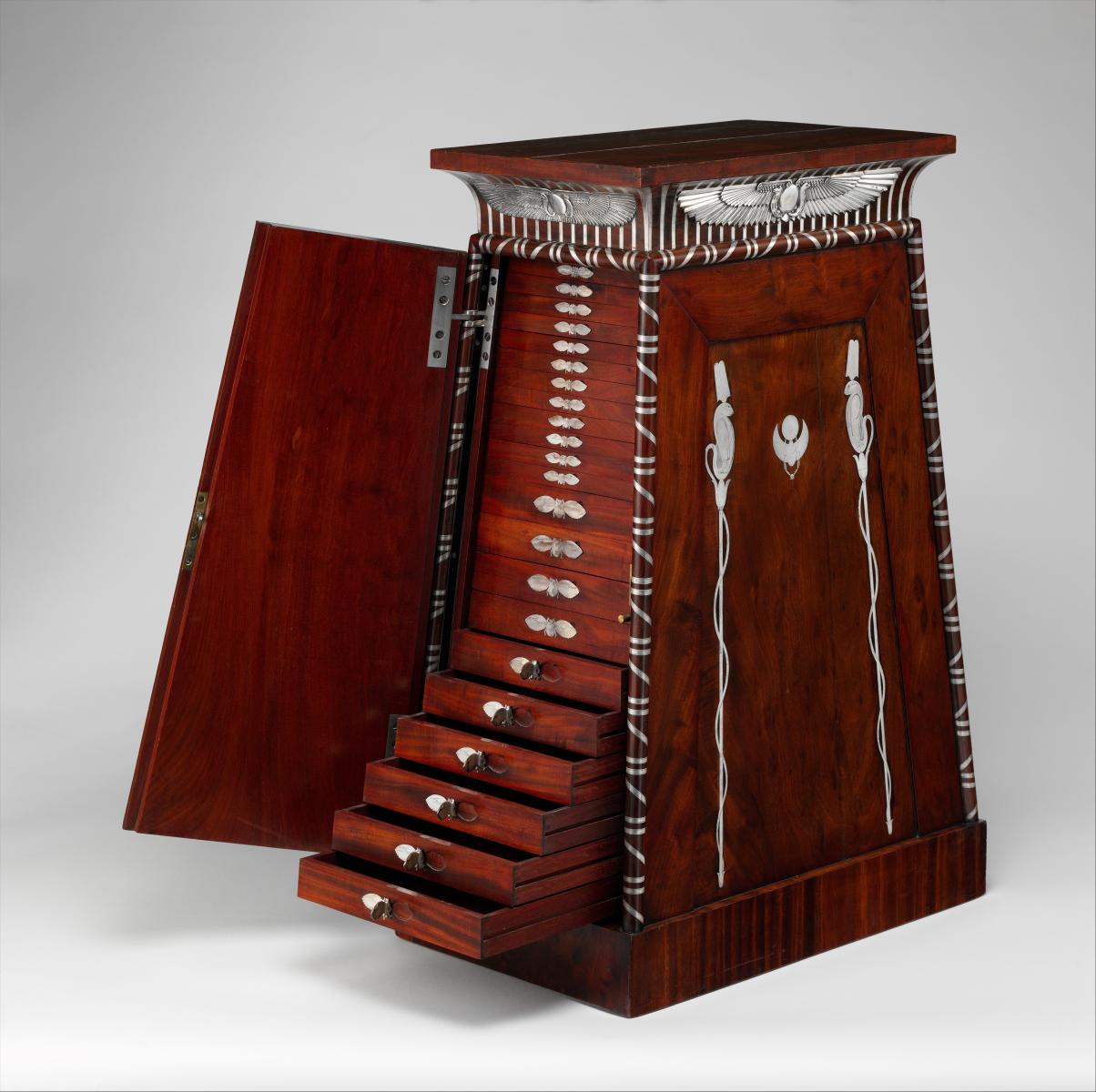
High-resolution photo of the front of the medal cabinet with the left door opened and the lowermost 6 drawers partly opened. Each open drawer shows the swiveled right wings of the silver insects opened to serve as the drawer pulls.
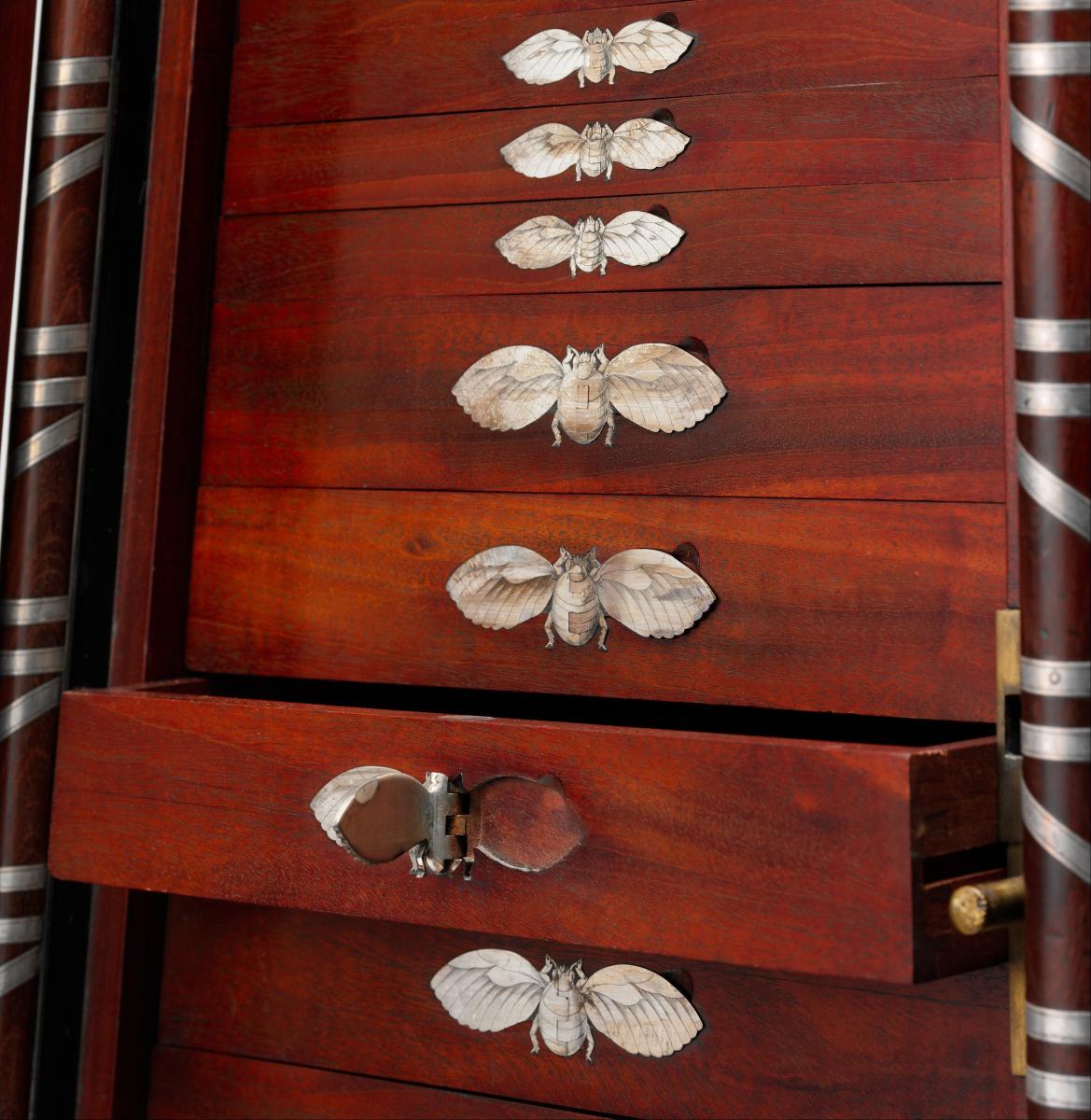
High-resolution photo illustrating details of the one drawer slightly opened showing the swiveled right wing of one silver insect (scarab) drawer pull. Also note the different latch mechanism of this example, at the right of the open drawer (a round post rather than a tongue), compared with the V&A medal cabinet.
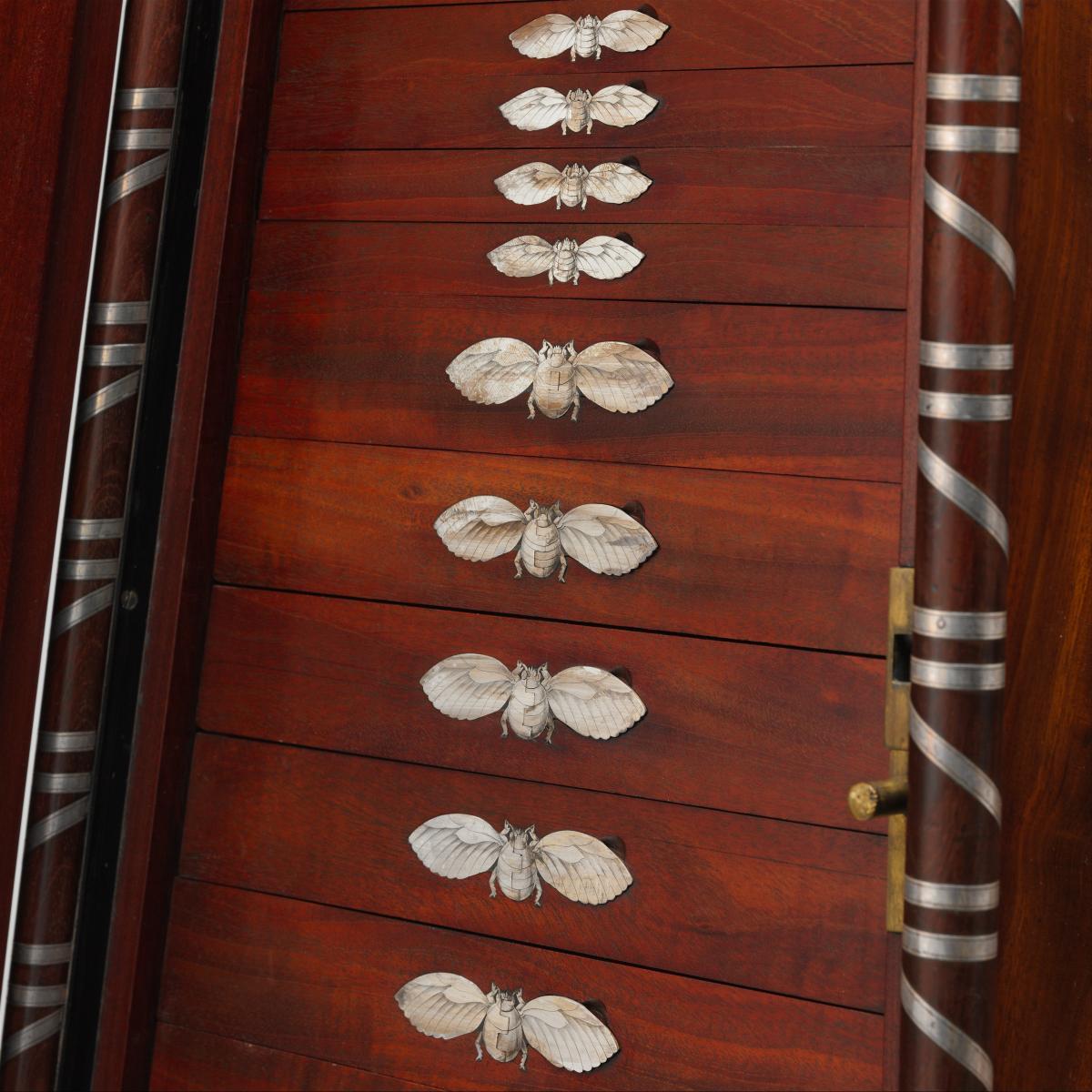
High-resolution image showing details of the drawer pulls and the lock mechanism at the right. There is no engraving visible on the lockplate in this photo or the previous one showing a portion of the lockplate.
There are several additional references cited in the nine footnotes of the initial catalog description (https://www.metmuseum.org/art/collection/search/195473). This may have been written by Wolfrom Koeppe in 2006. Most of the references are in French, and include other writings by Baron Dominique Vivant Denon. Some may provide relevant supplementary information about this cabinet .
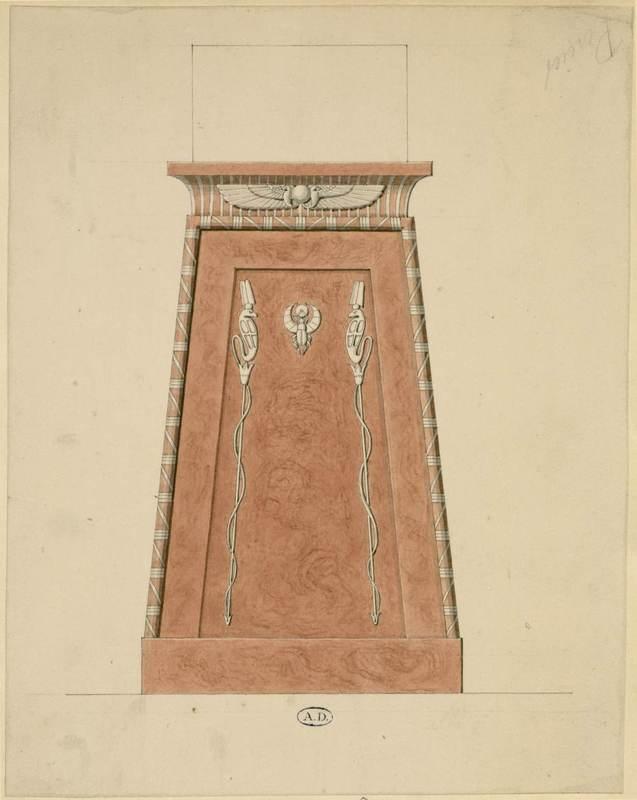
Above is an undated (except to the early portion of the 19th century) drawing of the medal cabinet from the Musée des Arts Décoratifs in Paris, inventory number: CD 3240 (http://collections.madparis.fr/medaillier-0). The drawing is attributed to Charles Percier. The page of this drawing measures 21.4 cm high x 17 cm wide, and is pen (black ink) and watercolor. The design shows the use of a burl wood as the planned veneer for this medal cabinet. This drawing is mentioned in the Victoria and Albert Museum description of the medal cabinet and in the Metropolitan Museum listing. This photo is copyrighted by the Musée des Arts Décoratifs (©Photo Les Arts Décoratifs, Paris Tous droits réservés).
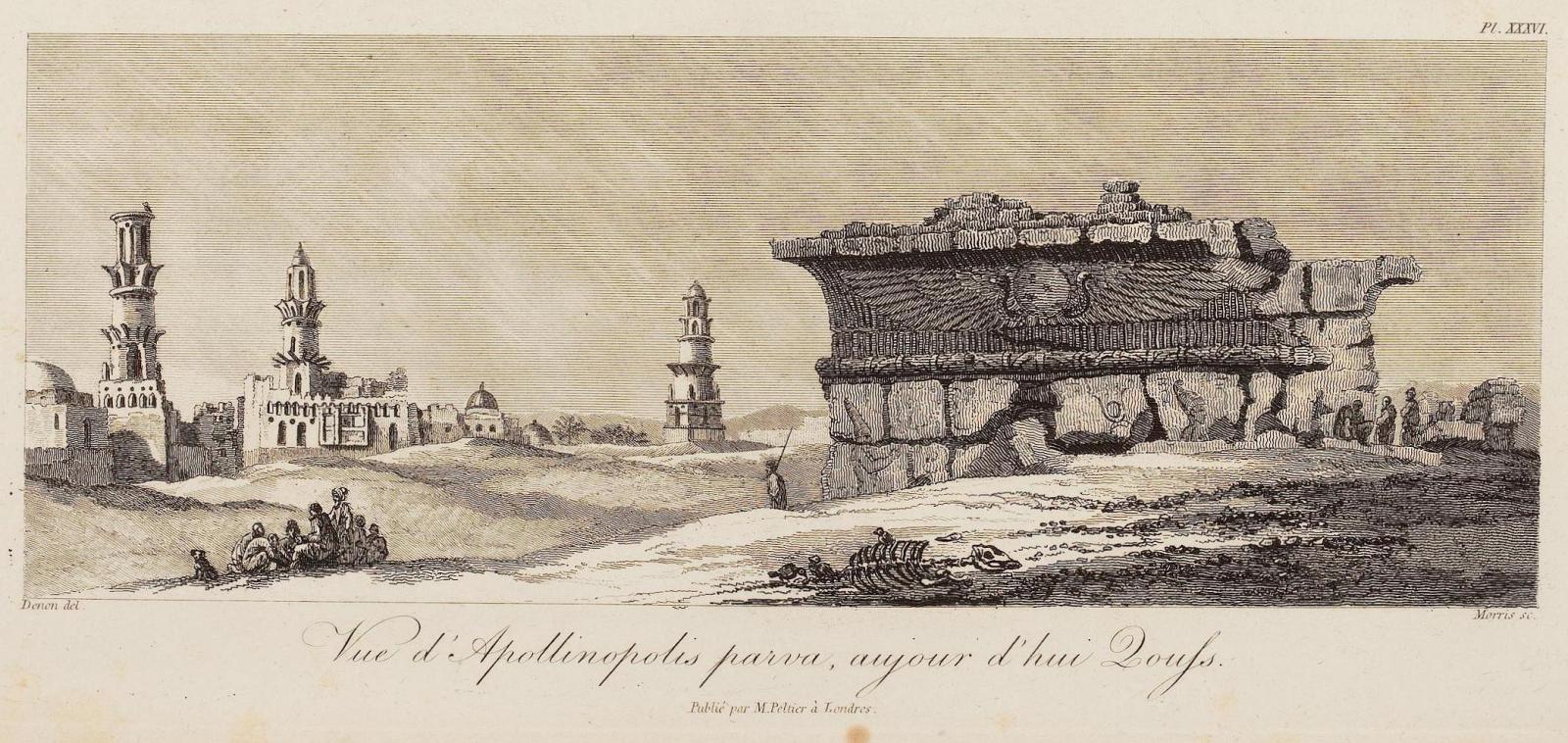
Above is Denon’s engraving of the Pylon at Apollonopolis Parva, Plate 36 (it also is shown as Plate 80 in the atlas accompanying his text) from Denon’s 1802 publication: Voyages dans la basses et la haute Égypte, pendant les campagnes du géneral Bonaparte par Vivant Denon (from: https://upload.wikimedia.org/wikipedia/commons/5/5d/Denon1802bd3_0039.jpg). As noted, the small amount visible of this pylon was the inspiration for the design of part of this medal cabinet. The winged sun disk and Uraei, the vertical lines as background to the sun disk, as well as the form of bands on the round molding were directly used by Charles Percier in designing the cornice in his plan of the medal cabinet. This image can be enlarged for greater detail of the pylon cornice.
4 -
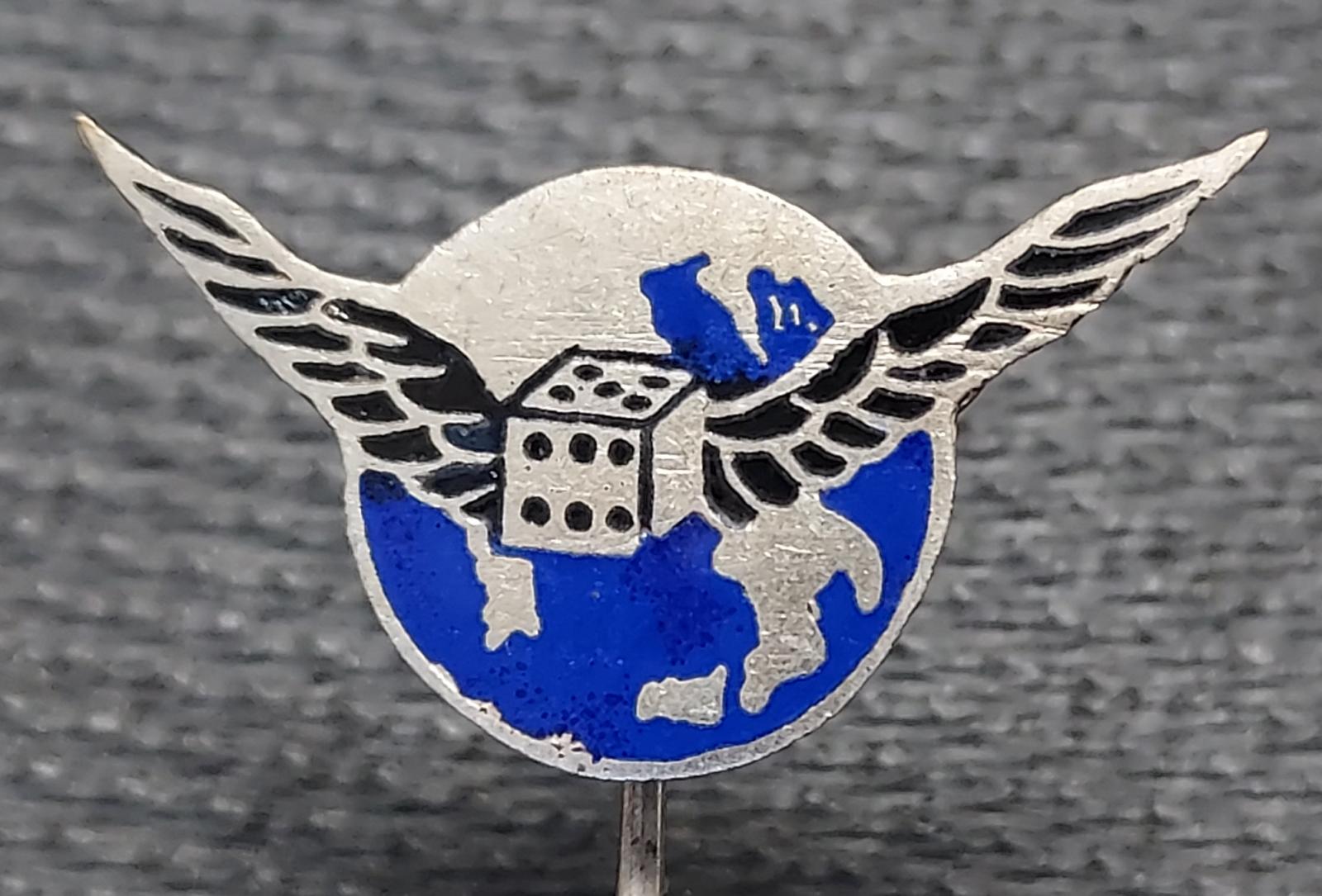
Above is a South African Air Force pin matching the design on the wooden plaque that Chrisvo illustrated in the first post on this thread. This pin measures maximally 26 mm wide (wingtip to wingtip), the round medallion body is 12 mm, and the thickness is ~1 mm. The soldered stickpin measures 40 mm long. This example is unmarked, but was made by Fahmy Tewfik Bichay of Cairo (the dealer obtained this and other pins from Bichay after he emigrated to Canada). I am seeking some additional information to try and confirm the squadron association.
0 -
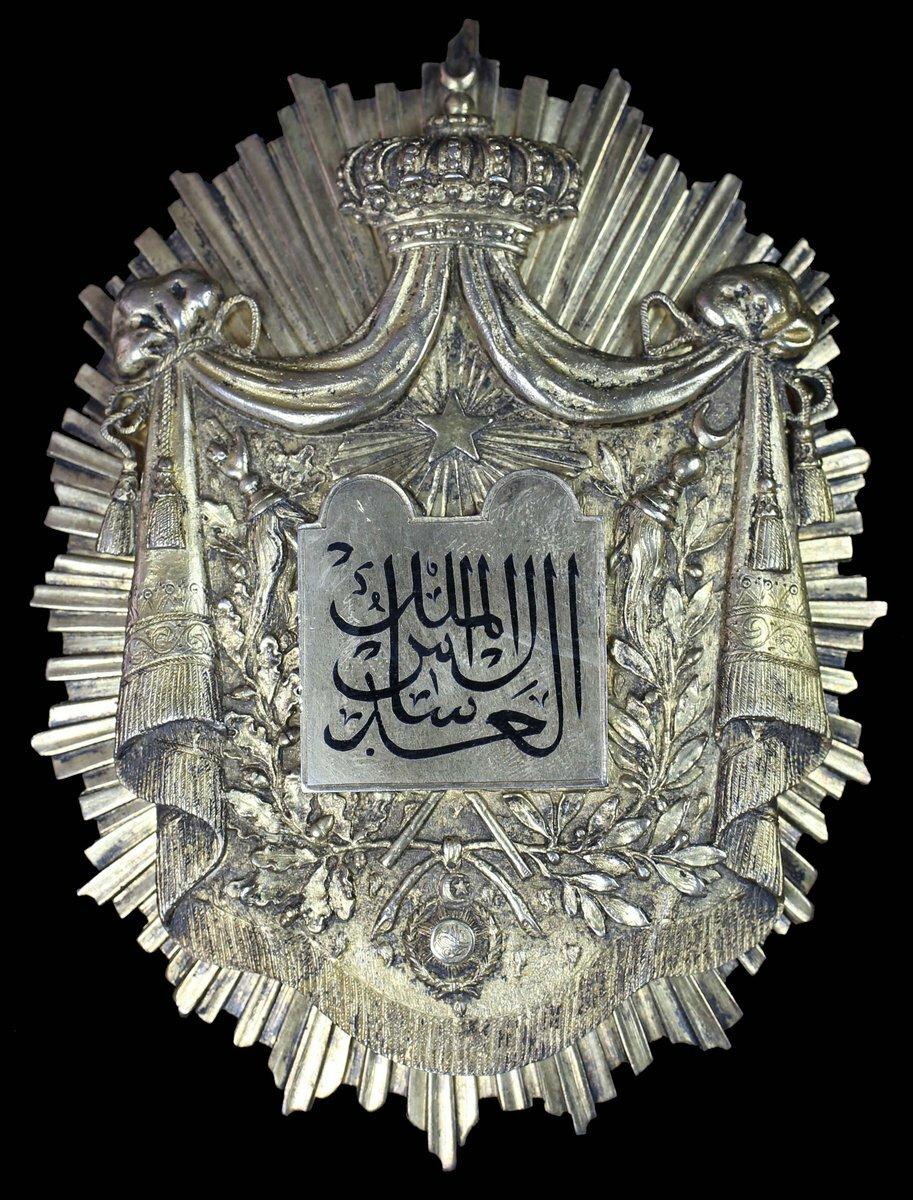
Above is a high-resolution image of a silver Mixed Courts badge from a Spink Auction (21002) of 29 July, 2021 (Lot 412) that I have not previously illustrated (https://www.spink.com/lot/21002000412). The auction description gives its dimensions as 115 mm tall x 86 mm wide. The calligraphy of the central tablet matches that on 2 badges offered in previous Spink auctions, and one past eBay auction badge. The tugra shows a correct orientation. I illustrated the tablets of all of those other badges in my first post here of 6 September, 2021 as unmarked with calligraphy that could not be matched to a named atelier. I illustrated the obverse of the other two badges in their entirety (I had not previously illustrated them) in my second post of 6 September, 2021. The workmanship of this badge is similar to that on the 2 other previous Spink offerings and the one eBay badge, illustrated and discussed in my 2 posts of 6 September 2021 and below. These badges all appear to represent the same as-yet-unidentified maker of Mixed Courts badges.
The first badge with similar calligraphy is from a 4 December, 2017 auction by Spink & Son, Lot 32, archived on the saleroom.com website (https://www.the-saleroom.com/en-us/auction-catalogues/spink/catalogue-id-srspi10156/lot-63685e70-7557-48b1-aabf-a83200b99d8c), measuring 116 mm x 85 mm, unmarked, but with an unspecified "pawnbroker's" mark on the reverse. I illustrated the tablet calligraphy on this gold and silver District Court badge as the 24th photo in my post of 6 September, 2021.
The 2nd badge with similar calligraphy is from a 19 November, 2015 auction by Spink & Son (Lot 320), archived on the saleroom.com website (https://www.the-saleroom.com/en-gb/auction-catalogues/spink/catalogue-id-srspi10063/lot-63c1fc39-2c79-499c-af04-a53f010b14ed). Its dimensions were given as 115 mm x 85 mm. The tablet calligraphy of that silver unmarked badge is shown as the 25th photo in my post of 6 September. I used a small, low-resolution image of this same badge tablet as the 26th image in my 6 September post that came from drclaw's initial post of 9 May, 2011 (from a previous auction by Sammler-Cabinet) starting a topic titled: “Egypt, Khedivate – Judge’s Badge of Office”, here in the “Middle East & Arab States” section of GMIC. I also illustrated the full obverse of this silver badge (from the 19 November, 2015 auction by Spink & Son, archived on the saleroom.com website) as the 1st photo in my second post of 6 September, 2021 on this thread.
A 3rd unmarked silver badge with the same calligraphy is shown as the 27th the photo in my 6 September post , and comes from a 6 June, 2018 eBay auction (https://www.ebay.ie/itm/263668261167; no photo currently available). I llustrated the obverse of this badge as the 2nd photo in my second post of 6 September, 2021 on this thread.
0 -
The name of the French medallist who designed this is on the obverse, "F. VERNON" - Frédéric-Charles-Victor de Vernon (1858-1912). A brief bibliographic outline of his career is available on Wikipedia (https://en.wikipedia.org/wiki/Frédéric-Charles-Victor_de_Vernon) and several images of some of his other medal designs can also be readily accessed online.
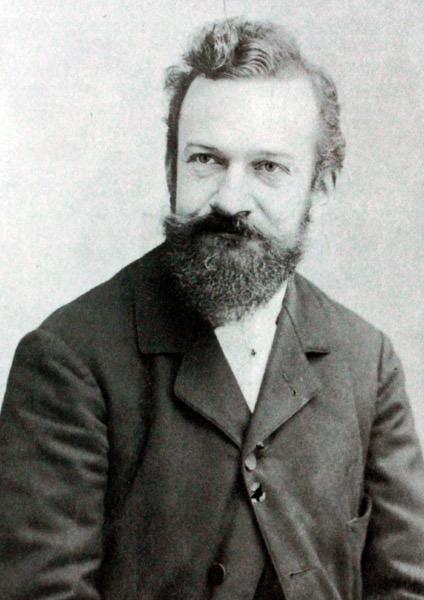
Frédéric-Charles-Victor de Vernon (unknown photographier, unknown date, from: https://upload.wikimedia.org/wikipedia/commons/e/ea/Charles-Frédéric_Victor_Vernon.jpg)
1 -
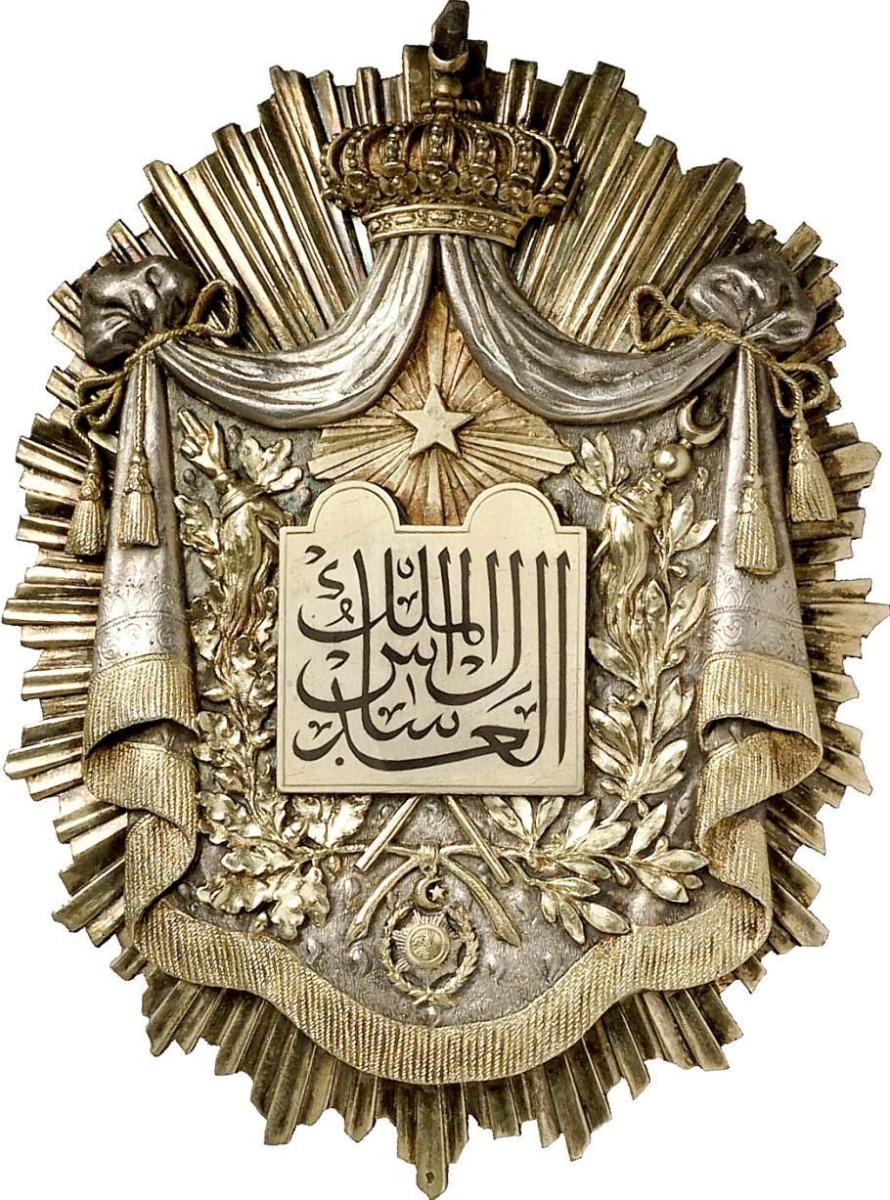
Above is a higher-resolution image of the same gold and silver District Court badge as shown in the above photo from the Tammann Collection catalogue in my post of 15 September, 2021. This image comes from an archived listing on Sixdid.com website (https://www.sixbid-coin-archive.com/#/en/search?text=Egypt Abbas Hilmi II&modal=true) for the same 3 November, 2008 auction by UBS (Auction 80, Lot 3) that is from the Tammann Collection. The Sixbid.com auction description gives the measurements as 117 mm X 88 mm (I mistakenly wrote "118 mm" as the height listed in the UBS printed catalogue, that also gave 117 mm as the height), and as in the UBS printed catalogue noted above, it states that the badge is made of silver, partly gilt, and enamelled, it is identified as marked Froment-Meurice, and was offered with the original case labelled Froment-Meurice, Paris. In both the published UBS catalogue and the Sixbid.com archived description, the information identifies a previous action of this badge by Mars & Merkur in Munich from 11 April, 1990. This image can be zoomed for slightly greater detail than shown in the above image in my post of 15 September, 2021. This photograph shows the tugra in better detail than on the above image of the same badge, indicating that it rrpresents the correct orientation of the calligraphy within the Order of Medjidie design element. Other components of the Froment-Meurice design and workmanship also can more clearly be seen in this photograph
The only other information of note from that the auction listing relates to the claim that only 2 other examples of these badges were known to the Numismatics Department of UBS at the time of this auction, and identifies one as having belonged to George Sherman Batcheller, a former president of "the court" from 1876-1885, and from 1898-1902 (the anniversary volume Les Juridictions Mixtes d'Égypte 1876-1926: Livre d'or Édité sous le Patronage du Conseil de l’Ordre des Avocats á l’Occasion du Cinquantenaire des Tribunaux de la Réforme, par le: Journal des Tribunaux Mixtes. Alexandrie, Egypte, Février 1926, identifies his initial appointment date to the Cairo District Court as 1875, and that he served in Cairo until he was decommissioned in 1885; that volume indicates his 1902 appointment was to the Appeals Court and that he died on 2 July 1908 while serving on the court; he also is listed in the Les Juridictions Mixtes d'Égypte 1876-1926 volume as having been awarded the Order of Medjidie 2nd Class in 1884). His judicial badge is supposed to be in a collection of one of the Smithsonian Institution museums in Washington, DC. I have contacted the museum about this badge, and am hoping to determine whether it is his gold and silver District Court badge or the gold Appeals Court insignia. George Sherman Batcheller served in the U.S. Civil War, ending his military career with the rank of brigadier-general. He was chosen to accompany assassinated president Abraham Lincoln's body from Washington to Illinois. There is significantly more detailed biographical information available about George Sherman Batcheller's legal and political career, military service, family life, and his extravagant home and mausoleum. I will have more to contribute about Batcheller after I hear back from the Smithsonian Institution.
0 -
I am including a photo of a neck badge (or possibly a sash badge?) from a 28 April, 2021 auction by Pescheteau-Badin, Paris, Lot 212, archived on the Lot Art.com website (https://www.lot-art.com/auction-lots/Egypt-Order-of-Ishmael-founded-in-1915-1st-class/212-egypt_order-28.4.21-pescheteau).

Moderate-resolution photo from the 28 April auction by Pescheteau-Badin of Paris (Lot 212), archived on the Lot Art.com website. The auction description of this badge calls it a "first class jewel (grand-cross)" insignia. It is unclear if this may be a 1st Class Grand Cordon sash badge, or if it may be a 2nd or 3rd Class neck badge (it is more likely a 3rd Class Commander neck badge, note the description wording that it lacks the ribbon). No ribbon or sash is identified as being included in this lot (the listing says "without ribbon"). The description states that the Lattes name is marked onto reverse (However, note comments below about the wreath configuration), that it measures 79 mm x 59 mm, and weighs 40 g. It also identifies the Egyptian hallmarks marking it as 18 carat gold and a date hallmark of "Y" = 1923-1924. The lower right ball finial is bent (noted in the description, along with a chip in the enamel), the suspension linking the upper arm to the crown suspension is bent slightly to the viewer’s right (also noted), the wreath and central medallion with the inscription is rotated slightly counterclockwise (not identified in the auction description). Although the resolution makes some aspects of the engraving on the gold floral elements of the arms unclear, they exhibit 2 lateral pairs of marks (looking more like "V"-shaped marks in enlargement) and a single distal mark on the most distal petals of these floral elements (that mark appears rather large in this image). The 2 central flowers show 3 lateral marks on each and it appears this example has the the "V"-shaped mark outlining the central petals. The listing states that a brevet in its envelope is associated with this lot, dated 2 April, 1923, and named Albert Sarraut. The award date is congruent with the date hallmark. Albert Sarraut is probably the French radical socialist and politician (b. 19872-d. 1962). He served as member of the Chamber of Deputies (1902-24), as Undersecretary of State (1906-1909), as Undersecretary of War (1909-10), and Minister of Education (1914-15). He also was France's Ambassador to Turkey (1925-26), and Minister of the Interior 1926-28, 1934, 1937-40), Minister of the Navy (1930-31), and served two times as Prime Minister (1933 and 1936). Sarraut's most important colonial appointment was as the Governor General of Indochina (1911-14 and 1916-19). Sarraut served as Minister of the Colonies 1920-24 and 1932-33), coordinating French colonial policy and development of France's oversees "holdings" as exterritorial components of a “Greater France” or a “France Africaine”. It was during his time as Minister of the Colonies that he was apparently awarded the Order of Ismail, although France's formal role in dual administration of Egypt ended in 1882. How this role earned him the Order of Ismail is unclear to me.
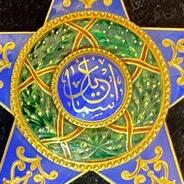
Cropped image of the same auction photo to show the configuration of the wreath on this badge. This photo can be enlarged slightly, for a small amount of additional detail. The wreath on this badge is not the work of Lattes, but is clearly a Tewfik Bichay-made component. The configuration of the gold laurel fruit dots are the pattern seen on Bichay badges (compare the Sarraut badge with the 2nd Class neck badge of Dr. James Ferguson Lees, shown in the 2nd photo of my post of 23 September, 2021, as well as other examples of the Bichay wreath design, shown and described in several previous posts on this thread), not on Lattes pieces (see the 2nd photo in my previous post of 4 October, 2021 on this thread, and elsewhere). The gold and red enamel bands on the wreath also exhibit the thinner gold borders, and slightly uneven overall thickness that also mark Bichay's execution not that of Maison Lattes. Finally, the size of the wreath is anomalously large, covering the narrow area of gold at the most central portion of each of the gold and blue enamel arms (as noted for the other example of an apparent Lattes badge body with a Bichay-made wreath, that periodically keeps re-appearing at different auctions, which I have discussed in several previous posts of on this thread: 28 March, 2020 about an eMedals listing of that badge; 13 August, 2020 of the Spink listing for the same badge; 14 August, 2020 also discussing the Spink listing; and 9 September, 2021 a Liverpool Medals listing of that same badge). This is only the second badge I have seen in online auction images that exhibits a combination of elements from Lattes and Bichay. It is unknown whether this "repair" and recombination of these elements may be recent or a past attempt to fix some loss or damage of the central medallion (perhaps associated with the other damage to the final and link with the crown suspension element on this piece).
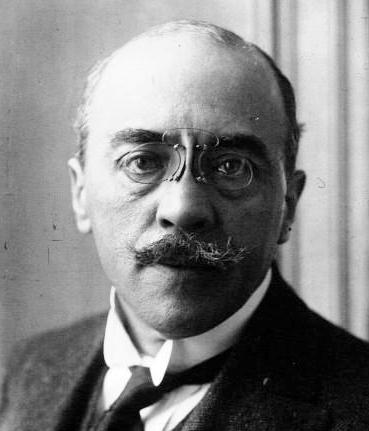
Photo of Albert Sarraut from 1921 (from: https://en.wikipedia.org/wiki/Albert_Sarraut#/media/File:Albert_Sarraut.png)
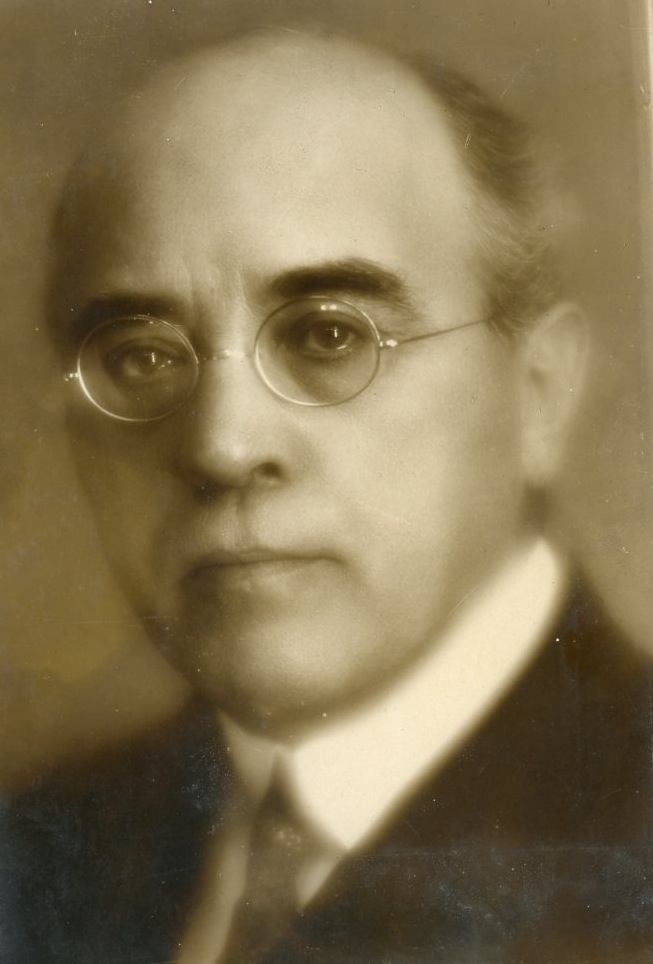
Photo of Albert Sarraut from 1930 (from: https://upload.wikimedia.org/wikipedia/commons/e/e7/Albert_Sarraut_1921.jpg)
0 -
I am including pretty-good images of two different archived auction offerings of Order of Ismail insignia. I had saved these photos a while ago, but then started researching additional photos and information regarding the Sir Jeffrey Francis Archer 1st Class Grand Cordon Order of Ismail set I ran across from a Toovey’s auction (my post of 25 November, 2019 on this thread). I just found these examples while tidying-up some image files on my computer.
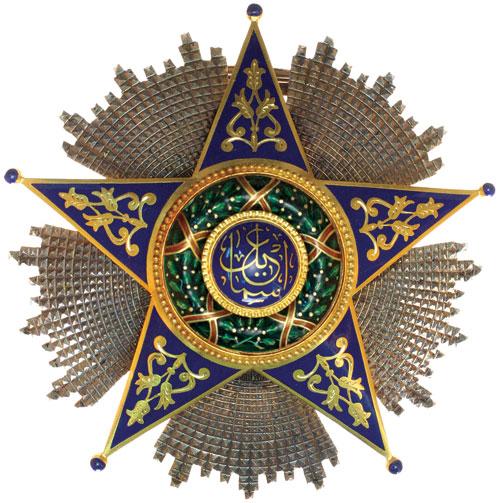
The breast star above is from a 2 April, 2009 auction (Sale 90, Lot 3863) by Noble Numismatics Pty Ltd (https://www.noble.com.au/auctions/lot?id=238462). The brief auction description identifies it as a Grand Officer Class, no measurements of the breast star are provided. The brief description states that it is marked “Lattes” on the reverse, but no photo is provided. No information is given about the date hallmark. This moderate-resolution photo can be zoomed for a small amount of additional detail. The workmanship and configuration of the wreath is consistent with Lattes, and the pattern of the gold laurel fruit dots in the wreath matches exactly those on comparative internet images of 2nd Class breast stars with confirmation of the Lattes name (photos, measurements, or cased with the neck badge; as well as too few with illustrated or noted date hallmarks). The engraving on the gold floral elements on the arms shows the style with 3 lateral marks on each side of the terminal blossom with a short single mark distal to those oriented with the central petal; and 3 lateral and one medial mark on each of the central flowers (the central petal of each is not outlined with a “V” mark). Even in this lower resolution image, the engraving on the Noble Numismatics Lot 3863 example seems quite flowing and elegant, as with some other pieces I have noted elsewhere in this thread.
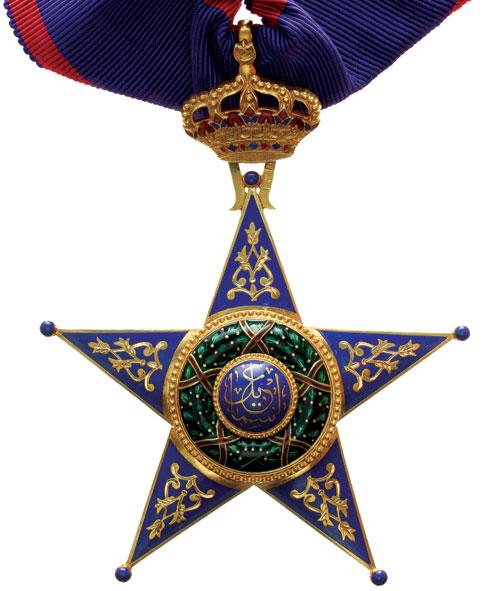
Moderate-resolution photo image (https://www.noble.com.au/auctions/lot?id=238464) from this same Noble Numismatics auction (2 April, 2009, Sale 90). This is identified as a Commander Class neck badge (Lot 3865), and not the neck badge for the 2nd Class breast star shown above. The description states it is marked “Lattes” and that it is hallmarked, but no photo of the reverse is included. This image can be zoomed slightly. The wreath design and execution is an exact match for Lattes examples of 3rd Class neck badges (documented with photos of the reverse). Although unclear when enlarged, 3 Egyptian assay office dates on the suspension link to the crown may show a date of "D" =1929 - 1930 (?). The configuration of laurel fruits is the same as seen on other Lattes-made 3rd Class neck badge, the 2nd Class neck badge, and the 1st Class sash badge. Although not completely clear when enlarged in the photo above, the gold floral elements on the blue enameled arms show 2 lateral marks and a long central marking in the terminal blossom and the central flowers each have 3 lateral marks and a “V”-shaped mark outlining the central petal. The engraving is clearly different than that on the 2nd Class Breast star (Lot 3863), but similar to other examples described previously on this thread.
0 -
Paul, Many thanks for the observation about the medal and the case. I noticed it was easy to find low-quality images on lots of eBay and other sites, and the jewel is not expensive. Is the scarcity you note only for the elaborate & sturdy case shown above marked "SPENCER'S MASONIC DEPOT, OPPOSITE MASONIC HALL, 16 GT QUEEN ST, LONDON W.C.", or are the cardboard cases with the Masonic coat-of-arms also less common than the medals as well?
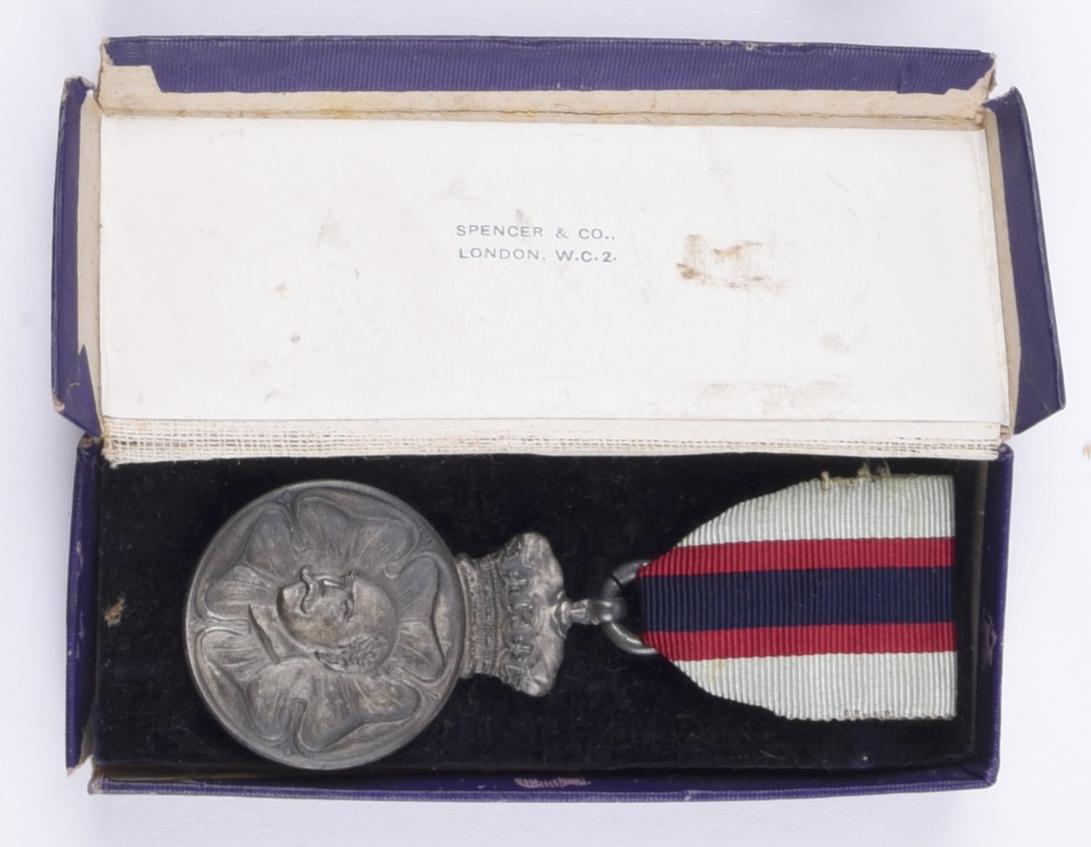
Above is a moderate-resolution cropped image of the 1717-1917 Duke of Connaught Masonic medal from the 22 June, 2021 auction Lot 79 by Woolley and Wallis (https://www.woolleyandwallis.co.uk/departments/medals-coins-arms-armour/ma060521/view-lot/29/) of medals and documents belonging to Dr. James Ferguson Lees. This is the only image of this medal from that auction listing, shown in the cardboard case marked "SPENCER & CO., LONDON, W.C. 2." (same as the above case for the current eBay example, eBay item number: 203348652342). No photo or description of the outer lid cover to determine whether the same embossed U.G.L.E. coat-of-arms is present.
0 -
I recently stumbled upon a very good portrait photo of an individual wearing the full-sized regalia of the Order of Ismail, as well as the miniature for this Order. This comes from a 22 June, 2021 auction by Woolley and Wallace (https://www.woolleyandwallis.co.uk/departments/medals-coins-arms-armour/ma060521/view-lot/29/), archived with lower-resolution images on the Drouot Digital website (https://www.gazette-drouot.com/lots/15319018), and high-resolution photos are archived with this listing on the saleroom.com website (https://www.the-saleroom.com/en-gb/auction-catalogues/woolley-and-wallis/catalogue-id-srwo10279/lot-8de16daa-647c-4e71-a699-ad3b010c7ff6#lotDetails). The Woolley and Wallace auction includes full-sized medals, a miniature medal bar, award documents, extra ribbons, a notebook journal from the Boer War, and the portrait photo of the individual associated with these items. All of the items in this auction Lot (29) belonged to Dr. James Ferguson Lees , CBE, who was the Director General of Public Health in Egypt (1920-1925). He also was the Acting Under Secretary of State from 1920-1922. The medal bar of miniatures is included in the same Spink & Sons case that houses all of Dr. Ferguson Lees full-sized awards. I posted about all of those items from the auction offering yesterday, 23 September, 2021, in the thread "Question about the Order of Ismail/Nishan-al-Ismail" here in the "Middle East & Arab States" section. I apologize for the redundancy of posting some of the same information here, but this auction lot had a very complete collection of medals and documents that represent very thoroughly detailed information and provenance for these 3 examples of Middle Eastern miniatures, and I felt I wanted to include them in this topic.

Above is a moderate resolution photo of the Spink & Sons case holding all of the full-sized medals and medal bar of miniatures for Dr. J. Ferguson Lees. From L-R the full-sized awards are: an OBE Commander’s neck badge (Britannia type) with neck ribbon; the neck badge of the 2nd Class Grand Officer Order of Ismail (upper) with neck ribbon; the breast star of the 2nd Class Grand Officer Order of Ismail (lower); the full sized badges above the bar of miniatures are the Queen’s South Africa Medal (2nd type with 3 clasps: Cape Colony, Orange Free State, South Africa 1901); a 1914 star, British War Medal, and a Victory medal; a neck badge (probably of the 2nd Class Grand Officer Order of the Nile) with neck ribbon (upper); below that the is the breast star for the 2nd Class Order of the Nile; the 3rd Class Order of Medjidie with neck ribbon (upper); and below that a neck badge that is probably the 3rd Class Commander Order of the Nile. In the center lower row is the miniature medal bar, detailed in the photo and description below.
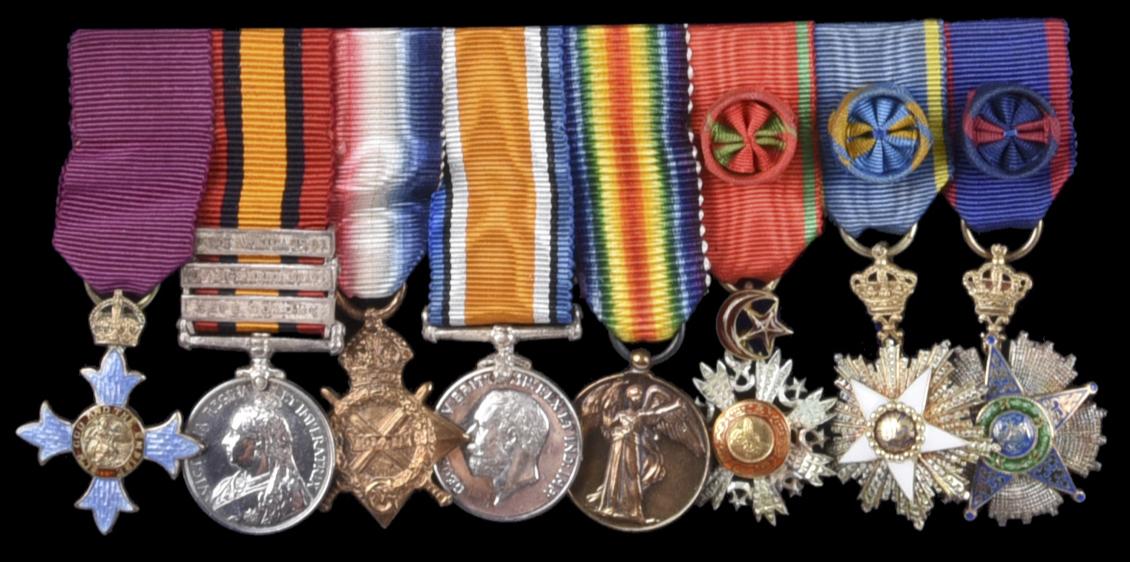
Cropped moderate-resolution image showing a close-up view of the miniature medals of Dr. James Ferguson Lees. As noted above for the full-sized insignia, the miniatures on this medal bar represent, from L-R: the OBE; the Queen’s South Africa Medal with 3 clasps; a 1914 star, British War Medal; a Victory medal; the Order of Medjidie (with rosette); the Order of the Nile (with rosette but without the gold & silver galon for the 2nd Class award, it seems unlikely this mini would represent the 3rd Class Commander Class of this award); and the Order of Ismail (with rosette but lacking the appropriate gold & silver galon for this award). The miniature of the Order of Ismail should precede the Order of the Nile, as shown in Owain's 3 photos of King Farouk I's uniquely configured medal bars (with unusual forms of the Order of Ismail mini on 2 of those bars), shown as the 2nd-4th-to-last photos in my post of 31 October, 2020 on the thread "Question about the Order of Ismail/Nishan-al-Ismail". The miniature of the Order of Ismail in Dr. J. Ferguson Lees' group is the most common form that I have previously illustrated with examples in other posts on this thread.
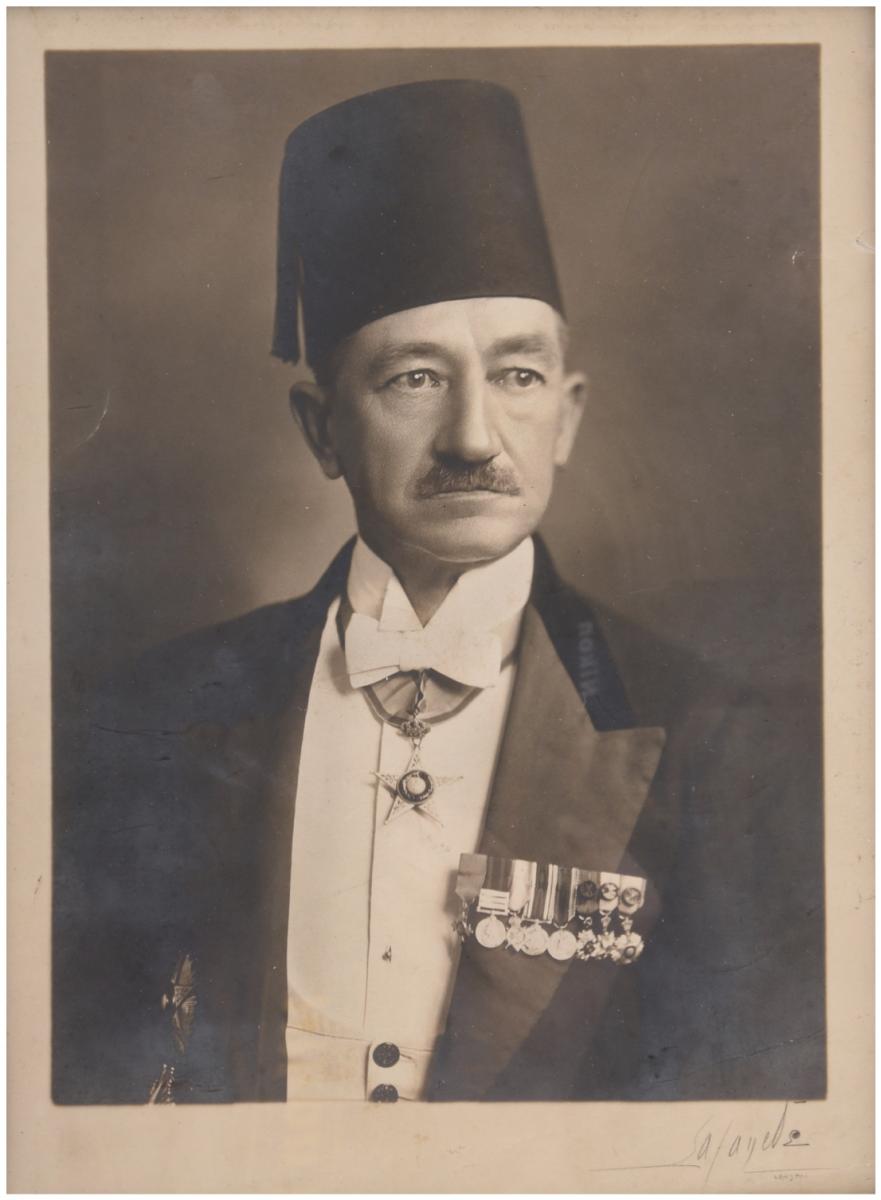
High-resolution portrait photo of Dr. James Ferguson Lees wearing his Egyptian Order of Ismail neck badge, the Order of Ismail breast star (upper star on Dr. Ferguson Lees’ right chest that is partially visible), and the 2nd Class Order of the Nile breast star (the lower partially visible breast star on the right chest). He also wears the miniature medal bar with all of the medals noted above. This photo can be zoomed for additional details. The Order of Ismail miniature is at the viewer’s far right in this image, James Ferguson Lee was born 29 January, 1872 and died 12 January, 1935. The auction information further states that Dr. Ferguson Lees: “…served in the South African War on the Hospital Ship Spartan, at a base hospital in the East End of London, and in the field attached to the 1st Battalion Connaught Rangers. Having become an M.D. in 1902, he joined the Egyptian Government Service as Port Health Officer for Alexandria in 1908, rising to become Director General in 1920, and acting as Under-Secretary of State from July to October 1920. He served in the Great War as Inspector of Prisoner of War Camps in Egypt, E.E.F.”
0 -
I recently came across a Duke of Connaught 1717-1917 Masonic Medal as a component in a large lot of medals, award brevets, Royal licenses to wear foreign orders, and a personal journal kept during the Boer War, that was associated with a British physician who worked in Egypt in the early 20th century. I checked GMIC for information and saw that no images had been added to this thread about the medal and that Paul Wood had a question about a portion of the motto on the reverse of this badge. There are a few threads addressing the Duke of Connaught’s awards and background here on GMIC (i.e., see “Duke of Connaught’s medal”, started by freiherr on 28 June 2010 in the “Great Britain: Orders, Gallantry, Campaign Medals” section; “Duke of Connaught” started by Mervyn Mitton on 9 October, 2011, also in the “Great Britain: Orders, Gallantry, Campaign Medals”; and “Did or Not the Duke of Connaught received the Sachsen-Koburg-Gotha Medals” thread started by lilo on 30 January, 2009 in the “Germany: Imperial: The Orders, Decorations, and Medals of the Imperial German States” section, among information in other threads, all here on GMIC). The recent auction of the awards and other materials belonging to Dr. Ferguson Lees included a Duke of Connaught Masonic Medal 1717-1917 in a Spencer & Co., London cardboard presentation case (identical to that in the 5th photo shown below). I realize this is a bit of a cold topic, but thought I would at least add a few photos to round out the topic.
I came across this medal as a part of a 22 June, 2021 auction of several orders and medals that belonged to Dr. James Ferguson Lees, CBE (https://www.woolleyandwallis.co.uk/departments/medals-coins-arms-armour/ma060521/view-lot/29/). This listing also is archived with lower-resolution images on the Drouot Digital website (https://www.gazette-drouot.com/lots/15319018), and high-resolution photos are archived with this listing on the saleroom.com website (https://www.the-saleroom.com/en-gb/auction-catalogues/woolley-and-wallis/catalogue-id-srwo10279/lot-8de16daa-647c-4e71-a699-ad3b010c7ff6#lotDetails). The Woolley and Wallace auction included medals, award documents, extra ribbons, a notebook journal from the Boer War, and a portrait photo of Dr. Ferguson Lees wearing his Egyptian, Ottoman, and British full-sized awards and a medal bar of miniatures for the same insignia (however, he is not wearing the Duke of Connaught Masonic medal in that portrait). All of the items in this auction Lot (29) belonged to Dr. James Ferguson Lees, who was born 29 January, 1872 and died 12 January, 1935. The Woolley & Wallace auction information further states that Dr. Ferguson Lees: “…served in the South African War on the Hospital Ship Spartan, at a base hospital in the East End of London, and in the field attached to the 1st Battalion Connaught Rangers. Having become an M.D. in 1902, he joined the Egyptian Government Service as Port Health Officer for Alexandria in 1908, rising to become Director General in 1920, and acting as Under-Secretary of State from July to October 1920. He served in the Great War as Inspector of Prisoner of War Camps in Egypt, E.E.F.” The photo of the Duke of Connaught Masonic Medal belonging to Dr. Ferguson Lees is not good enough resolution to include here (and does not show the reverse), so I had to fish for other online images of this medal.
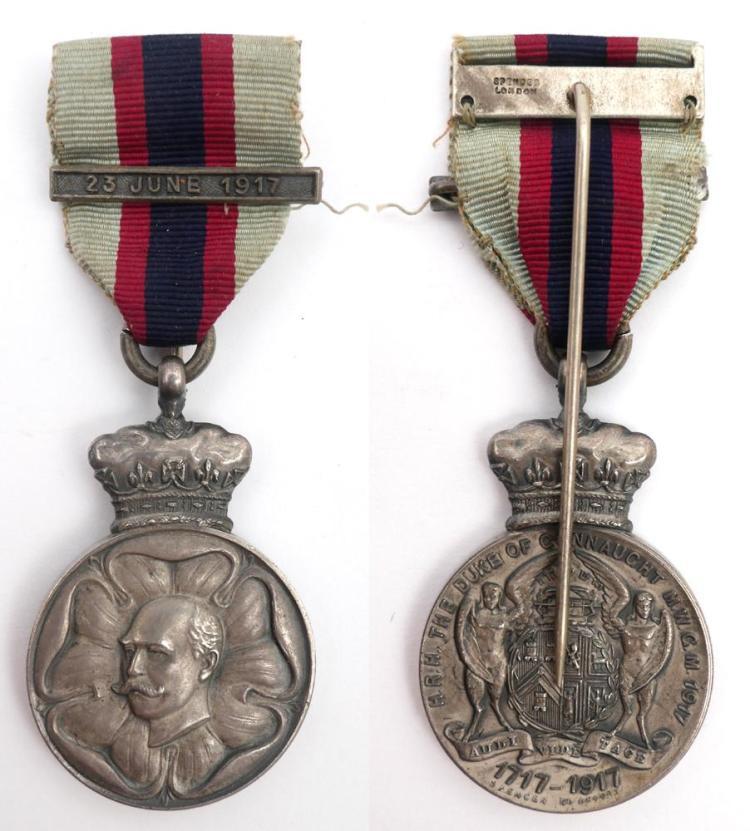
Above are photos of the obverse and reverse of an example of the Duke of Connaught Masonic Medal 1711-1917. This comes from a 3 February, 2018 auction by Whytes of Dublin (Lot 71), archived on the invaluable website (https://www.invaluable.com/auction-lot/1717-1917-duke-of-connaught-medal.-0B044AB94A#).). As noted by Paul Wood, this is a Masonic decoration. The 1717-1917 Duke of Connaught's Medal commemorates the bicentenary of English freemasonry. Other sources identify this medal as being solid sterling silver, with the following dimensions: 30.2 mm in diameter x 43.5 mm tall, 3.5 mm thick, weighing 26.2 g, and manufactured by the silversmith Richard Spencer. The obverse shows a bust of the Duke (Earl) of Connaught on a background of the English Rose. The reverse has a motto around the upper ¾ of the margin reading: “H.R.H. THE DUKE OF CONNAUGHT M.W.G.M. 1917”. To answer Paul Wood’s question here of 1 February, 2010, the “M.W.G.M.” is an abbreviation for “Most Worthy Grand Master”. The reverse shows a coat of arms of the United Grand Lodge of England, U.G.L.E., (see the last image in this post) with a banner below bearing the abbreviated Latin motto: “AUDI VIDE TACE” (= Hear, See, and Be Silent), with the dates 1717-1917. Below that is the inscription; “SPENCER RD” followed by a space and then the digits that are the registration number. In my limited image searches, I have seen three other examples of this medal with the clip reading: “23 JUNE 1917”, the date of the bicentenary.
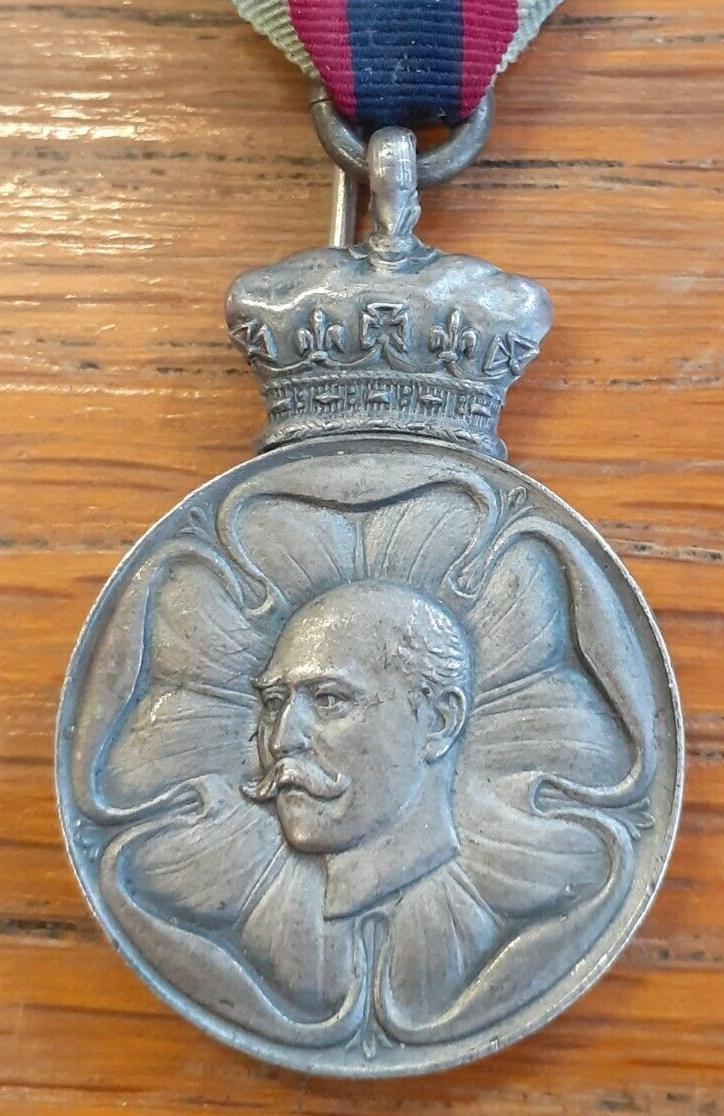
Above is a high-resolution, more detailed view of the obverse of this medal, from a current eBay offering, eBay item number: 363549546410, (https://www.ebay.ie/itm/THE-DUKE-OF-CONNAUGHT-H-R-H-BI-CENTENARY-1717-1917-WW1-MASONIC-SILVER-MEDAL-/363549546410?hash=item54a53dd7aa). The pin on this piece also is marked “SPENCER LONDON” identical to that seen on the Whytes example above, but lacks the clip marked “23 JUNE 1917”.
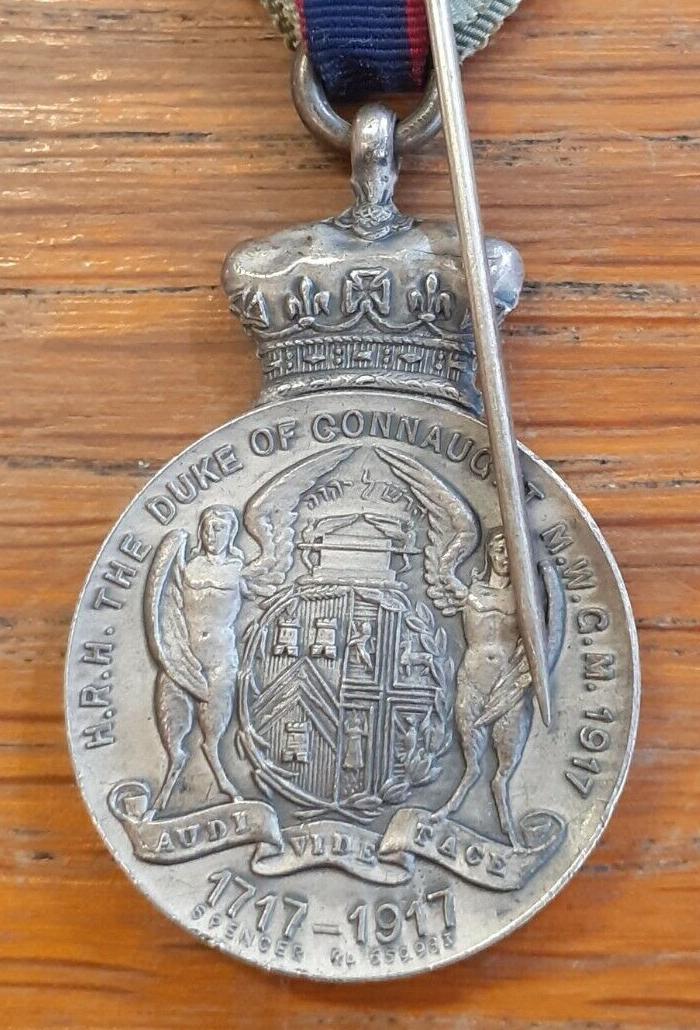
High-resolution image of the reverse of this same eBay example of the Duke of Connaught Masonic Medal 1711-1917, showing the design in better detail than in the Whytes photo above, eBay item number: 363549546410.
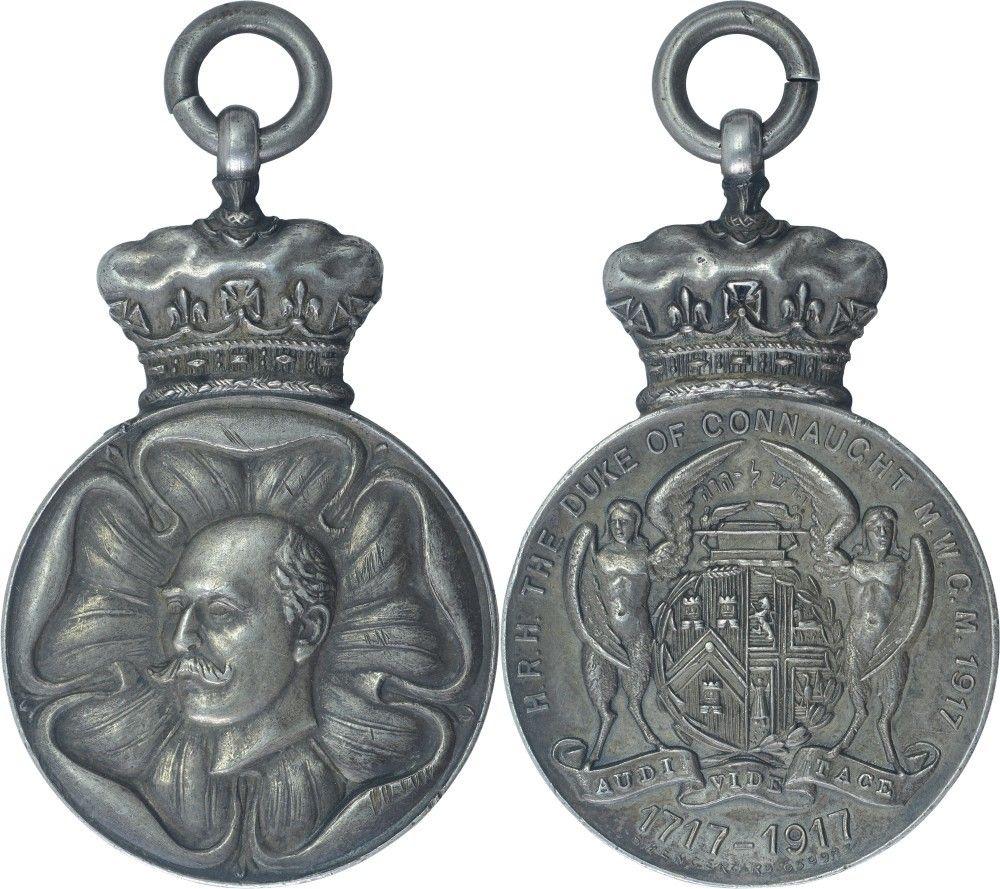
A very high-resolution photo of the obverse and reveres of a Duke of Connaught Masonic Medal 1711-1917 without an associated ribbon. This image comes from a 3 September, 2016 auction by Maruhdar (Auction 21. Lot 727), archived on the Sixbid.com website (https://www.sixbid-coin-archive.com/#/en/search?text=Duke Connaught masonic medal). The brief auction description gives a diameter of 29.94 mm and a weight of 26.3 g for this piece. This image can be zoomed for significantly greater details.
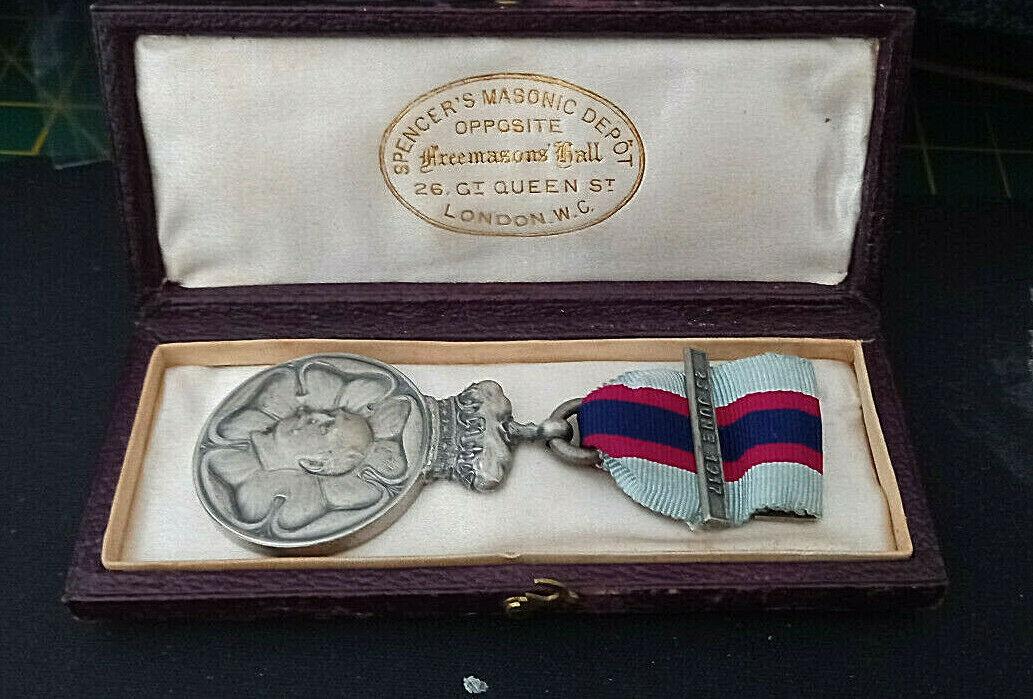
An example of this medal in its case with the Spencer name and location as the Masonic Depot (from a current eBay offering, eBay item number: 154607723196: https://www.ebay.ie/itm/Duke-of-Connaught-Silver-Bi-Centenial-1717-1917-Jewel-Pin-Bar-by-Spencer-Box-/154607723196?hash=item23ff56a2bc).
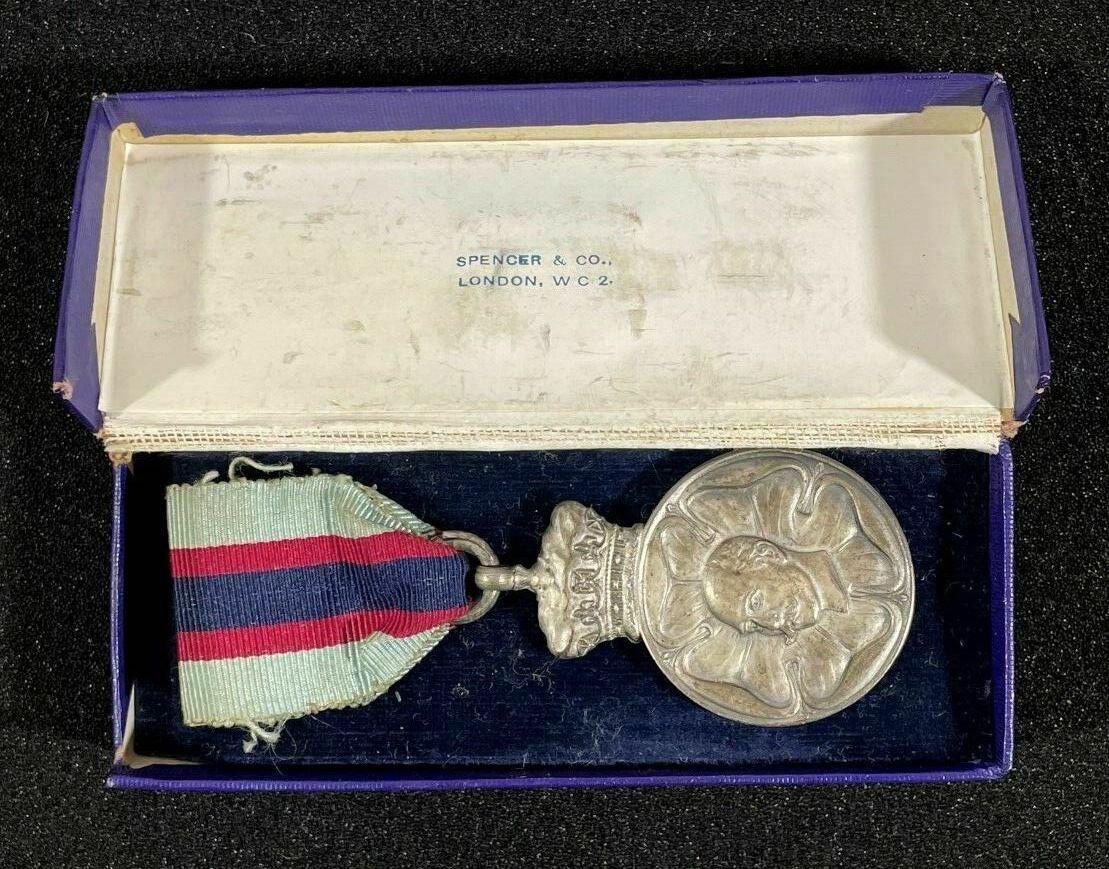
An example of a different form of the case for this medal, in coated cardboard, with the marking SPENCER & CO., LONDON, W C 2.” From a current eBay auction, eBay item number:203348652342 (https://www.ebay.ie/itm/Antique-Duke-of-Connaught-Centenary-Silver-Medal-Cased-Freemasonry-/203348652342?hash=item2f58863136).

The exterior of the upper lid of this same case from the current eBay auction (eBay item number:203348652342) showing the form of the U.G.L.E. coat of arms embossed on it.
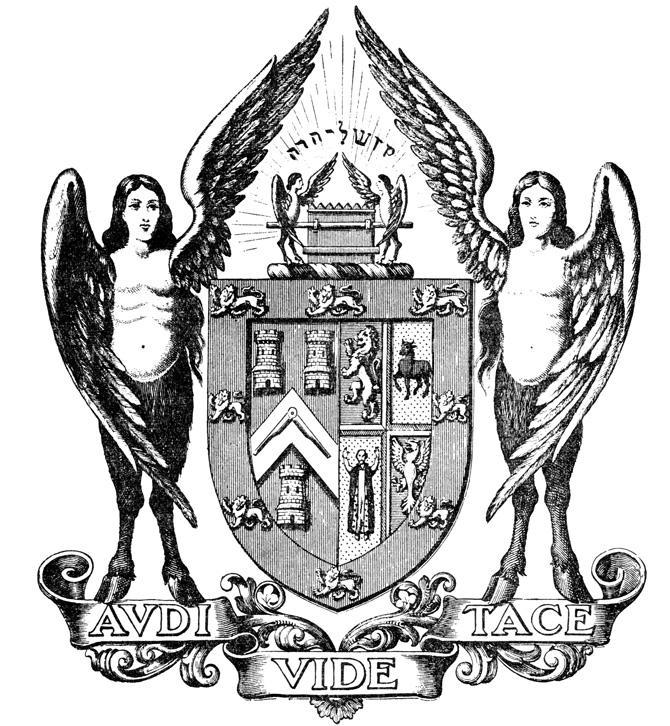
Above is an illustration showing details of the U.G.L.E. coat of arms that is on the reverse of the Duke of Connaught Masonic Medal 1711-1917 (from: http://www.freemasonry.bcy.ca/grandlodge/seal/ugle.html). See the following website for a description of symbolic elements of the U.G.L.E. coat of arms, including the colors not seen in the above illustration or on the reverse of Duke of Connaught Masonic Medal: https://www.hertsmasonicbanners.uk/united-grand-lodge
0




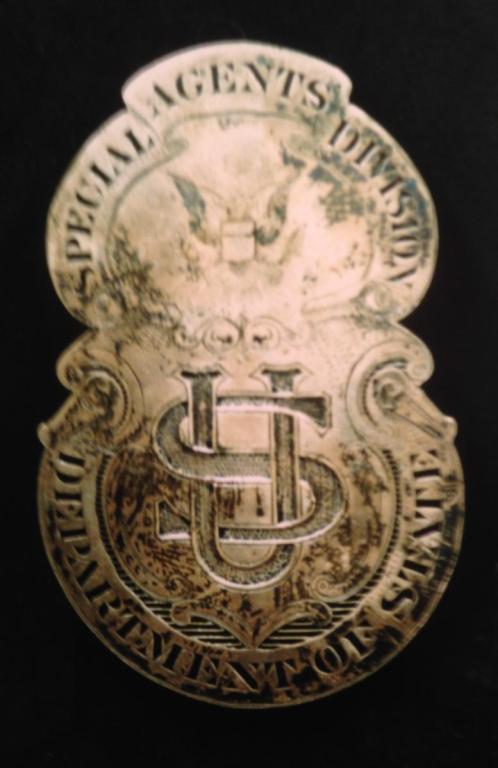
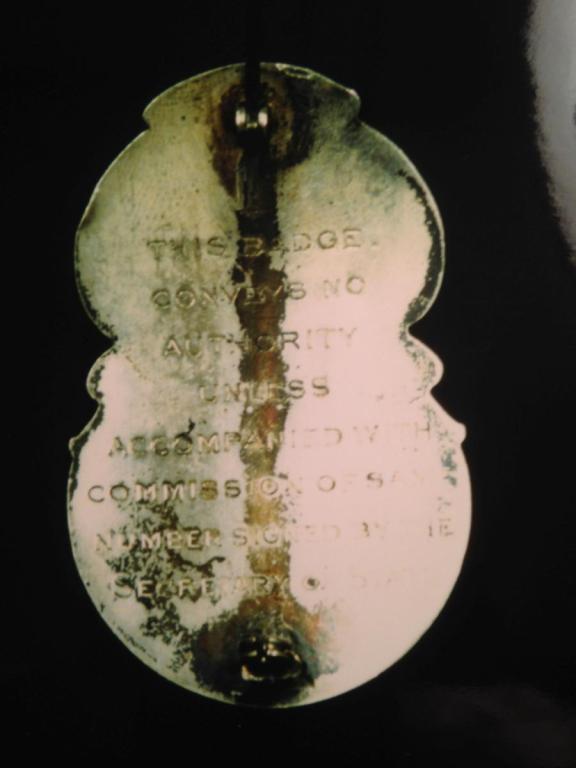
Egypt Khedivate Judge's Badge question
in Middle East & Arab States
Posted · Edited by Rusty Greaves
I recently found a few photographs of some of the collections of orders, medals, and other regalia at Abdeen Palace in Cairo on the FOURSQUARE CITY GUIDES (foursquare.com). One of the images (added on 30 January, 2020 by Abdulrahman) is of a Mixed Courts badge that is displayed alongside many Chamberlains' pins.
Above is a moderate-resolution image of the Mixed Courts badge displayed at Abdeen Palace from the foursquare.com website (https://foursquare.com/v/abdeen-palace--قصر-عابدين/4f169cc8e4b0044a28561a2a?openPhotoId=5e32a2cb8ab81c00084283ee). I have seen a few other lower resolution photos showing this particular badge with the adjacent Chamberlains' pins, or as an artistic partial image of this badge (i.e. see Owain's 2nd and 5th images in his post of 29 March, 2019, on the thread "Question about the Order of Ismail/Nishan al-Ismail" started on 8 November, 2017 here in the "Middle East & Arab States" section. I believe this may be the only example of this badge on display at the Palace. It appears to be silver, although there might be some very worn gilt portions of the rayed embellishment (especially above the mantle and possibly at the most inferior margin of the mantle fringe), some parts of the rays around the star above the central tablet, and maybe some of the lower right mantle fringe(?), suggesting it might be a heavily worn District Courts silver and gold judge's badge. The discoloration could simply be tarnish, so that this represents either a silver Parquet badge or one worn by the other court officials entitled to wear this insignia. There is slight damage to the enamel of the lower siin of the central tablet inscription (and possibly some damage to the upper siin character as well). The form of the calligraphy most closely matches the Froment-Meurice Group 2 tablet inscriptions I illustrated in my post of 6 September, 2021 on this thread. The calligraphy resembles that of the Clark Auction Gallery Lot 0235 example, shown in a low-resolution image as the 9th photo in my 6 September, 2021 post. The thickness of the straight diacritical mark on the lower right of the tablet and the tight curve of the stroke on the lower left under the “bird” diacritical mark match this Abdeen Palace badge’s calligraphy more closely than some of the other examples I have classed as Group 2 of the Froment-Meurice calligraphy (there are some discrepancies, but I do not know if these could be variation due to enamel application or if they may represent actual die differences). The 25 July, 2015 Clark Auction Gallery listing for Lot 0235 clearly shows the Froment-Meurice maker's name on the reverse of that badge and it was offered in a Froment-Meurice case. I am troubled by an inability to determine whether the tugra is oriented in the correct position (as on all Froment-Meurice examples where I am able to distinguish the orientation of this design element) or upside down (as seen on other identified and unidentified manufactures examples of this badge). All of the other design elements are consistent with Froment-Meurice workmanship, although the photo is not detailed enough for good comparisons whith other examples.